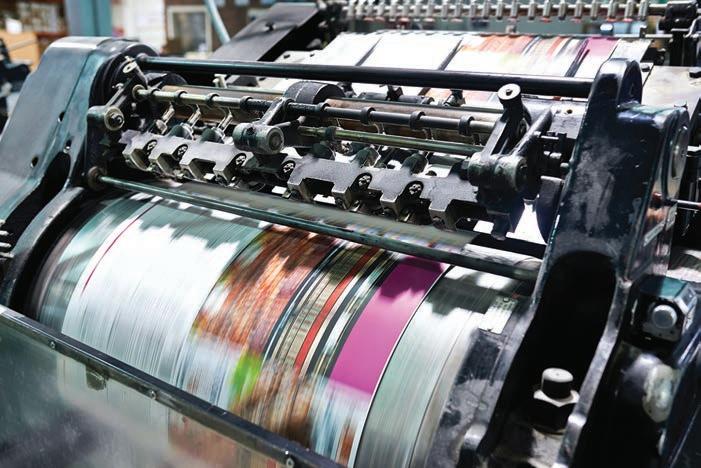

TEXTBOOK ADVANCE COPY
March 2025
This textbook advance is provided as a sample for course preparation, planning and for use by teachers until the final products is available.
It should not be:
• made available in any other form
• uploaded to any website not affiliated to or authorised by Cambridge University Press & Assessment
• sold, reproduced or otherwise exploited for financial gain
• used in whole or in part to create a derivative work
• edited in any way (this includes the removal or modification of any branding, photographs or illustrations)
These advanced chapters have been provided for use by your school prior to publication of the textbook. The PDF supplied and all downloaded or printed excerpts must be destroyed once the textbook has been released.
For questions related to these instructions, please email copyright@cambridge.org

ShaftesburyRoad,CambridgeCB28EA,UnitedKingdom
OneLibertyPlaza,20thFloor,NewYork,NY10006,USA
477WilliamstownRoad,PortMelbourne,VIC3207,Australia
314–321,3rdFloor,Plot3,SplendorForum,JasolaDistrictCentre,NewDelhi–110025,India
103PenangRoad,#05–06/07,VisioncrestCommercial,Singapore238467
CambridgeUniversityPress&AssessmentisapartoftheUniversityofCambridge.
WesharetheUniversity’smissiontocontributetosocietythroughthepursuitofeducation,learningandresearchatthehighestinternational levelsofexcellence. www.cambridge.org
Firstedition©DavidGreenwood,BrynHumberstone,JustinRobinson,JennyGoodman,JenniferVaughanandStuartPalmer2021
Secondedition©DavidGreenwood,BrynHumberstone,JustinRobinson,JennyGoodman,JenniferVaughanandStuartPalmer2025
Thispublicationisincopyright.Subjecttostatutoryexceptionandtotheprovisionsofrelevantcollectivelicensingagreements, noreproductionofanypartmaytakeplacewithoutthewrittenpermissionofCambridgeUniversityPress&Assessment.
Firstpublished2021
Secondedition2025 2019181716151413121110987654321
CoverdesignbySardineDesign TypesetbydiacriTech
PrintedinChinabyC&COffsetPrintingCo.,Ltd.
AcataloguerecordforthisbookisavailablefromtheNationalLibraryofAustraliaat www.nla.gov.au
ISBN978-1-009-59233-8
Additionalresourcesforthispublicationatwww.cambridge.edu.au/GO
ReproductionandCommunicationforeducationalpurposes
TheAustralian CopyrightAct1968 (theAct)allowsamaximumofonechapteror10% ofthepagesofthispublication,whicheveristhe greater,tobereproducedand/orcommunicatedbyanyeducationalinstitutionforitseducationalpurposesprovidedthattheeducational institution(orthebodythatadministersit)hasgivenaremunerationnoticetoCopyrightAgencyLimited(CAL)undertheAct.
FordetailsoftheCALlicenceforeducationalinstitutionscontact:
CopyrightAgencyLimited Level12,66GoulburnStreet SydneyNSW2000
Telephone:(02)93947600
Facsimile:(02)93947601
Email:memberservices@copyright.com.au
ReproductionandCommunicationforotherpurposes
ExceptaspermittedundertheAct(forexampleafairdealingforthepurposesofstudy,research,criticismorreview)nopartofthis publicationmaybereproduced,storedinaretrievalsystem,communicatedortransmittedinanyformorbyanymeanswithoutpriorwritten permission.Allenquiriesshouldbemadetothepublisherattheaddressabove.
CambridgeUniversityPress&AssessmenthasnoresponsibilityforthepersistenceoraccuracyofURLsforexternalorthird-partyinternet websitesreferredtointhispublicationanddoesnotguaranteethatanycontentonsuchwebsitesis,orwillremain,accurateorappropriate. Informationregardingprices,traveltimetablesandotherfactualinformationgiveninthisworkiscorrectatthetimeoffirstprintingbut CambridgeUniversityPress&Assessmentdoesnotguaranteetheaccuracyofsuchinformationthereafter.
CambridgeUniversityPress&AssessmentacknowledgestheAboriginalandTorresStraitIslanderpeoplesofthisnation.Weacknowledgethe traditionalcustodiansofthelandsonwhichourcompanyislocatedandwhereweconductourbusiness.Wepayourrespectstoancestors andElders,pastandpresent.CambridgeUniversityPress&AssessmentiscommittedtohonouringAboriginalandTorresStraitIslander peoples’uniqueculturalandspiritualrelationshipstotheland,watersandseasandtheirrichcontributiontosociety.
1D
4 Algebraictechniques
5A Decimalsandplacevalue CONSOLIDATING
5B Roundingdecimals
5C Additionandsubtractionofdecimals
5D Multiplyinganddividingbypowersof10
5E Multiplicationofdecimals
5F Divisionofdecimals
5G Connectingdecimalsandfractions
5H Connectingdecimalsandpercentages
5I Expressingproportionsusingdecimals, fractionsandpercentages
6A Integers CONSOLIDATING
6B Addingorsubtractingapositiveinteger
6C Addinganegativeinteger
6D Subtractinganegativeinteger
6E Substitutingintegers
6F TheCartesianplane
7B Adjacentandverticallyoppositeangles
7C Transversalsandparallellines
7D Classifyingandconstructingtriangles
7E Classifyingquadrilateralsandotherpolygons
7F Anglesumofatriangle
7G
7H
8A Collectingandclassifyingdata
8B Summarisingdatanumerically
8C Dotplotsandcolumngraphs
8D Linegraphs
8E Stem-and-leafplots
8F Describingchance CONSOLIDATING
8G Theoreticalprobability
8H Experimentalprobability
9E Equationswithfractions
9G Applicationsofequations
Warm-upquiz 564
10A Usingandconvertingmetriclengths CONSOLIDATING 565
10B Perimeter CONSOLIDATING 571
10C Circles, p andcircumference 577
10D Unitsofareaandtheareaofarectangle 584
10E Areaofparallelograms 590
10F Areaoftriangles 595
Progressquiz 601
10G Volumeofrectangularprisms 603
10H Volumeoftriangularprisms 608
10I Capacity CONSOLIDATING 614
10J Massandtemperature CONSOLIDATING 619
Maths@Work:Landscapegardener 624
Modelling 626
Technologyandcomputationalthinking 628
Puzzlesandgames 630
Chaptersummaryandchecklist 631
Chapterreview 635
Semesterreview2 640
AbouttheAuthors
DavidGreenwood istheHeadofMathematicsatTrinityGrammarSchoolinMelbourneand has30+ years’experiencemathematicsfromYear7to12.Heistheleadauthorfor theCambridgeEssentialseriesandhasauthoredmorethan80titlesfortheAustralian Curriculumandforthesyllabusesofthestatesandterritories.Hespecialisesinanalysing curriculumandthesequencingofcoursecontentforschoolmathematicscourses. Healsohasaninterestintheuseoftechnologyfortheteachingofmathematics.
BrynHumberstone graduatedfromtheUniversityofMelbournewithanHonoursdegreein PureMathematics,andhas20+ years’experienceteachingsecondaryschoolmathematics. HewasaHeadofMathematicsfrom2014–2024attwoindependentschoolsinVictoria. Brynispassionateaboutapplyingthescienceoflearningtoteachingandcurriculum design,tomaximisethechancesofstudentsuccess.

JustinRobinson isco-founderof TheWellbeingDistillery,anorganisationcommittedtoenergising, equippingandempoweringteachers.Heconsultswithschoolsgloballyonthefieldsof studentandeducatorwellbeing.Priortothis,Justinspent25yearsteachingmathematics, coveringalllevelsofsecondaryeducationincludingteachingVCE,IBandA-Levels.His drivingpassionwasengagingandchallengingstudentswithinasafelearningenvironment. JustinisanHonoraryFellowoftheUniversityofMelbourne’sGraduateSchoolofEducation.
JennyGoodman hastaughtinschoolsforover28yearsandiscurrentlyteachingataselective highschoolinSydney.Jennyhasaninterestintheimportanceofliteracyinmathematics education,andinteachingstudentsofdifferingabilitylevels.ShewasawardedtheJones MedalforeducationatSydneyUniversityandtheBourkePrizeforMathematics.Shehas writtenforCambridgeMATHSNSWandwasinvolvedintheSpectrumandSpectrumGoldseries.

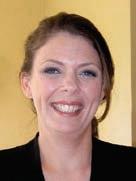
JenniferVaughan hastaughtsecondarymathematicsforover30yearsinNewSouthWales, WesternAustralia,QueenslandandNewZealandandhastutoredandlecturedinmathematics atQueenslandUniversityofTechnology.Sheispassionateaboutprovidingstudentsofallability levelswithopportunitiestounderstandandtohavesuccessinusingmathematics.Shehas hadextensiveexperienceindevelopingresourcesthatmakemathematicalconceptsmore accessible;hence,facilitatingstudentconfidence,achievementandanenjoymentofmaths.
StuartPalmer wasbornandeducatedinNSW.Heisafullyqualifiedhighschoolmathematics teacherwithmorethan25years’experienceteachingstudentsfromallwalksoflifein avarietyofschools.HehasbeenHeadofMathematicsintwoschools.Heisverywell knownbyteachersthroughoutthestatefortheprofessionallearningworkshopshe delivers.StuartalsoassiststhousandsofYear12studentseveryyearastheyprepare fortheirHSCExaminations.AttheUniversityofSydney,Stuartspentmorethana decaderunningtutorialsforpre-servicemathematicsteachers.


Acknowledgements
Theauthorandpublisherwishtothankthefollowingsourcesforpermissiontoreproducematerial: Cover: © GettyImages/Westend61.
Images: © GettyImages/boggy22,Chapter1Opener/PeterDazeley,p.8/akova,p.9/agrobacter,p.11(1)/PeopleImages, p.11(2)/JoseLuisPelaezInc,p.13/PhotographtakenbyAlanHopps,p.15/feardaused,p.16/Flashpop,p.20/RichVintage, p.21/BusaPhotography,p.22/kevinjeon00,p.24(1)/Wirestock,p.24(2)/kampeepatisena,p.25/BRETTSTEVENS,p.29/Tero Vesalainen,p.31/OscarWong,p.37/LisaMareeWilliams,p.39/SolStock,p.40/JohnW.Banagan,p.42/AlistairBerg,Chapter2 Opener/KriangkraiThitimakorn,p.54/PhynartStudio,p.58(1)/yanikap,p.58(2)/MorsaImages,p.59/ROBERTBROOK/SCIENCE PHOTOLIBRARY,p.61/Flashpop,p.69/ROBERTBROOK/SCIENCEPHOTOLIBRARY,p.70(2)/DSGpro,p.73/k samurkas,p.75/ pixelfit,p.78(1)/baona,p.78(1)/ROBERTBROOK,p.82/VinhTran,p.85/FlavioCoelho,p.88/anusornnakdee,p.90/JohnM LundPhotographyInc,p.94/JoseLuisPelaezInc,p.106/AndriyOnufriyenko,p.112/StanislawPytel,p.113/Al1974ex,p.115/ MartinBarraud,p.117/RobertDaly,p.118/FangXiaNuo,Chapter3Opener/Westend61,p.135/SolStock,p.139/EyeEmMobile GmbH,p.144/Jackyenjoyphotography,p.145/filadendron,p.150/p saranya,p.153(1)/YinYang,p.153(2)/Maskot,p.168(2)/ HenrikSorensen,p.171/SallyAnscombe,p.174/LincolnBeddoe,p.177/PhotobyRafaElias,p.180/PhilBoorman,p.183(1)/ CharleneCollins,p.183(2)/JoosMind,p.184(1)/MartinPoole,p.184(2)/MoMoProductions,p.187/LukeStanton,p.188/ FedotovAnatoly,p.189/JungGetty,p.190/ElyseSpinner,p.192/ozgurdonmaz,p.193/Arctic-Images,p.194(1)/ molchanovdmitry,p.194(2)/FGTrade,p.197/ScottShymko,p.107/DharmendraYadav/500px,p.208/Yuri Arcurs,p.209/ FredFroese,Chapter4Opener/Imgorthand,p.223/PhotographcopyrightEricMeola,p.232(2)/sturti,p.233/DanielGrill, p.235(1)/Westend61,p.236/sihuo0860371,p.237/YuichiroChino,p.242/elenaleonova,p.247/sarayut oat,p.248/MAURO DALLAPOZZA,Chapter5Opener/PeopleImages,p.256/kasto80,p.261(1)/EyeEmMobileGmbH,p.262/FGTrade,p.265(1)/ TomMerton,p.265(3)/hatman12,p.266/HelenKing,p.273/ConnectImages,p.277(1)/stoncelli,p.277(2)/MontyRakusen, p.279/PMImages,p.282/sankai,p.283/kajakiki,p.284/DarrianTraynor/AFLPhotos,p.288/JacobsStockPhotographyLtd, p.295/KenKeifer,Chapter6Opener/AndreSchoenherr,p.322/DanielGrill,p.324/MassimoBorchi/AtlantidePhototravel, p.331/ZU 09,p.341/Maskot,p.346(1)/MichaelH,p.348/malerapaso,p.349/Woodkern,Chapter7Opener/MinaDeLaO, p.361/KarlHendon,p.369/SanghwanKim,p.371/MarioGuti,p.377/AchimThomae,p.384/ReinhardKrull,p.385/Douglas Rissing,p.394/jadaphoto,p.399/DianeMiller,p.403/Warchi,p.427/KittiBoonnitrod,p.436/MartinBarraud,p.438/Trevor Williams,Chapter8Opener/AdamGault,p.464(1)/TimGristPhotography,p.464(2)/SolStock,p.465/TetraImages-Rob Lewine,p.466/BlendImages-MikeKemp,p.469(1)/EricYang,p.476/MorsaImages,p.492(2)/adventtr,p.494/ItziarAio, p.500/TetraImages,p.503/skynesher,p.509/istetiana,p.516(2)/esemelwe,Chapter9Opener/FrancescoCartafotografo, p.532/PhotoAlto/MicheleConstantini,p.540/KanawaStudio,p.550/MattLincoln,p.553/GeraintRowlandPhotography, p.555/MoMoProductions,Chapter10Opener/AlexanderSpatari,p.565/puravida,p.570/lillisphotography,p.576/JoseA. BernatBacete,p.577/PAThompson,p.582/ElenaPopova,p.583/JohnerImages,p.599/ImagetakenbyMayteTorres,p.601/ MintImages,p.607/philly077,p.613/VickiSmith,p.614/manologuijarro,p.618/RundstedtB.Rovillos,p.619/StefaniaPelfini, LaWaziyaPhotography,p.622/kolderal,p.623/FrancescoBergamaschi,p.626/adandr,p.637.
Everyefforthasbeenmadetotraceandacknowledgecopyright.Thepublisherapologisesforanyaccidentalinfringementand welcomesinformationthatwouldredressthissituation.
© AustralianCurriculum,AssessmentandReportingAuthority(ACARA)2009topresent,unlessotherwiseindicated.Thismaterial wasaccessedfromtheACARAwebsite(www.acara.edu.au).ThematerialislicensedunderCCBY4.0(https://creativecommons. org/licenses/by/4.0/).ACARAdoesnotendorseanyproductthatusesACARAmaterialormakeanyrepresentationsastothe qualityofsuchproducts.Anyproductthatusesmaterialpublishedonthiswebsiteshouldnotbetakentobeaffiliatedwith ACARAorhavethesponsorshiporapprovalofACARA.Itisuptoeachpersontomaketheirownassessmentoftheproduct.
Introduction
Thesecondeditionof EssentialMathematicsCOREfortheAustralianCurriculum hasbeensignificantlyrevisedandupdatedtosuit theteachingandlearningofVersion9.0oftheAustralianCurriculum.Manyoftheestablishedfeaturesoftheserieshavebeen retained,buttherehavebeensomesubstantialrevisions,improvementsandnewelementsintroducedforthiseditionacrossthe print,digitalandteacherresources.
Newcontentandsomerestructuring
Newcontenthasbeenaddedatallyearlevels.In Year7,thereisnewcontentonratiosandproportions,volumeoftriangular prisms,netsofsolidsandmeasurementrelatingtocircles.Allgeometrytopicsarenowcontainedinasinglechapter(Chapter7).In Year8,thereisnewcontentonorderofoperations,3D-coordinates,operationswithnegativefractions,areasofsectorsand compositeshapes,Pythagoras’theorem,inequalities,similarfigures,two-stepexperimentsandtreediagrams.For Year9,thereis newcontentonerrorsinmeasurement,inequalities,factorisation,samplingandproportion,quadraticsexpressionsandparabolas. In Year10,thereisnewcontentoncompositesolids,errorsinmeasurement,networksandlogarithmicscales.
Version9.0placesincreasedemphasison investigations and modelling,andthisiscoveredwithrevisedModellingactivitiesat theendofchaptersanddownloadableInvestigations.Therearealsomanynewelaborationscovering FirstNationsPeoples’ perspectives onmathematics,rangingacrossallsixcontentstrandsofthecurriculum.Thesearecoveredinasuiteofspecialised investigationsprovidedintheOnlineTeachingSuite.
Othernewfeatures
• Technologyandcomputationalthinking activitieshavebeenaddedtotheendofeverychaptertoaddressthecurriculum’s increasedfocusontheuseoftechnologyandtheunderstandingandapplicationofalgorithms.
• Targetedskillsheets –downloadableandprintable–havebeenwrittenforeverylessonintheseries,withtheintentionof providingadditionalpracticeforstudentswhoneedsupportatthebasicskillscoveredinthelesson,withquestionslinkedto workedexamplesinthebook.
• EditablePowerPointlessonsummaries arealsoprovidedforeachlessonintheseries,withtheintentionofsavingthetime ofteacherswhowerepreviouslycreatingthesethemselves.
Diagnosticassessmenttool
Alsonewforthiseditionisaflexible,comprehensivediagnosticassessmenttool,availablethroughtheOnlineTeachingSuite.This tool,featuringaround10,000newquestions,allowsteacherstosetdiagnosticteststhatarecloselyalignedwiththetextbook content,viewstudentperformanceandgrowthviaarangeofreports,setfollow-upworkwithaviewtohelpingstudents improve,andexportdataasneeded.
Guidetotheworkingprograms
EssentialMathematicsCOREfortheAustralianCurriculum containsworkingprogramsthataresubtlyembeddedintheexercises. ThesuggestedworkingprogramsprovidetwopathwaysthroughthebooktoallowdifferentiationforBuildingandProgressing students.
EachexerciseisstructuredinsubsectionsthatmatchtheAustralianCurriculumproficiencystrands(withProblem-solvingand Reasoningcombinedintoonesectiontoreduceexerciselength),aswellas‘Goldstar’( ).Thequestions* suggestedforeach pathwayarelistedintwocolumnsatthetopofeachsubsection.
• Theleftcolumn(lightestshade)showsthequestionsintheBuildingworkingprogram.
• Therightcolumn(darkestshade)showsthequestionsintheProgressingworkingprogram.
Gradientswithinexercisesandproficiencystrands
Theworkingprogramsmakeuseoftwo gradientsthathavebeencarefullyintegrated intotheexercises.Agradientrunsthrough theoverallstructureofeachexercise–where there’sanincreasinglevelofsophistication requiredasastudentprogressesthrough theproficiencystrandsandthenontothe ‘GoldStar’question(s)–butalsowithineach proficiencystrand;thefirstfewquestions inFluencyareeasierthanthelastfew,for example,andthefirstfewProblem-solvingand reasoningquestionsareeasierthanthelastfew.
½):completehalfofthepartsfromquestion 10(a,c,e,.....orb,d,f,.....)
• 2–4(½):completehalfofthepartsofquestions2,3and4
• –:completenoneofthequestionsinthissection.
• 4(½),5:completehalfofthepartsofquestion4 andallpartsofquestion5
•
Guidetothisresource
PRINTTEXTBOOKFEATURES
1 NEW Newlessons: authoritativecoverageofnewtopicsintheAustralianCurriculum9.0intheformofnew,road-tested lessonsthroughouteachbook.
2 AustralianCurriculum: contentstrands,sub-strandsandcontentdescriptionsarelistedatthebeginningofthechapter(see theteachingprogramformoredetailedcurriculumdocuments)
3 Inthischapter: anoverviewofthechaptercontents
4 NEW Quickreference: Multiplication,primenumber,fractionwallanddivisibilityrulestablesatthebackofthebook
5 Chapterintroduction: setscontextforstudentsabouthowthetopicconnectswiththerealworldandthehistoryof mathematics
6 Warm-upquiz: aquizforstudentsonthepriorknowledgeandessentialskillsrequiredbeforebeginningeachchapter
7 Sectionslabelledtoaidplanning: Allnon-coresectionsarelabelledas‘Consolidating’(indicatingarevisionsection)or withagoldstar(indicatingatopicthatcouldbeconsideredchallenging)tohelpteachersdecideonthemostsuitablewayof approachingthecoursefortheirclassorforindividualstudents.
8 Learningintentions: setsoutwhatastudentwillbeexpectedtolearninthelesson
9 Lessonstarter: anactivity,whichcanoftenbedoneingroups,tostartthelesson
10 Keyideas: summarisestheknowledgeandskillsforthesection
11 Workedexamples: solutionsandexplanationsofeachlineofworking,alongwithadescriptionthatclearlydescribesthe mathematicscoveredbytheexample.Workedexamplesareplacedwithintheexercisesotheycanbereferencedquickly, witheachexamplefollowedbythequestionsthatdirectlyrelatetoit.
12 Nowyoutry: try-it-yourselfquestionsprovidedaftereveryworkedexampleinexactlythesamestyleastheworkedexample togivestudentsimmediatepractice






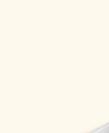



Workingprograms: differentiatedquestionsetsfortwoabilitylevelsinexercises
14 Puzzlesandgames: ineachchapterprovideproblem-solvingpracticeinthecontextofpuzzlesandgamesconnectedwith thetopic
15 Gentlestarttoexercises: theexercisebeginsatUnderstandingthenfluency,withthefirstquestionalwayslinkedtothe firstworkedexampleinthelesson



16 Chapterchecklist: achecklistofthelearningintentionsforthechapter,withexamplequestions
17 Chapterreviews: withshort-answer,multiple-choiceandextended-responsequestions;questionsthatare‘GoldStar’are clearlysignposted






18 Maths@Work: asetofextendedquestionsacrosstwopagesthatgivepracticeatapplyingthemathematicsofthechapter toreal-lifecontexts
19 NEW Technologyandcomputationalthinking activityineachchapteraddressesthecurriculum’sincreasedfocusonthe useofdifferentformsoftechnology,andtheunderstandingandimplementationofalgorithms
20 Modellingactivities: anactivityineachchaptergivesstudentstheopportunitytolearnandapplythemathematicalmodelling processtosolverealisticproblems
INTERACTIVETEXTBOOKFEATURES
21 NEW TargetedSkillsheets,oneforeachlesson,focusonasmallsetofrelatedFluency-styleskillsforstudentswhoneed extrasupport,withquestionslinkedtoworkedexamples
22 Workspaces: almosteverytextbookquestion–including allworking-out–canbecompletedinsidetheInteractive Textbookbyusingeitherastylus,akeyboardandsymbol palette,oruploadinganimageofthework.
23 Self-assessment: studentscanthenself-assesstheir ownworkandsendalertstotheteacher.Seethe Introductiononpagexformoreinformation.
24 Interactivequestiontabs canbeclickedonsothat onlyquestionsincludedinthatworkingprogramare shownonthescreen
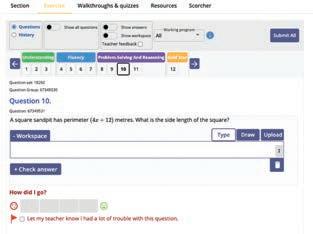

25 HOTmathsresources: ahugecateredlibraryofwidgets, HOTsheetsandwalkthroughsseamlesslyblendedwith thedigitaltextbook
26 Desmosgraphingcalculator,scientificcalculatorand geometrytoolarealwaysavailabletoopenwithinevery lesson
27 Scorcher: thepopularcompetitivegame
28 Workedexamplevideos: everyworkedexampleis linkedtoahigh-qualityvideodemonstration,supporting bothin-classlearningandtheflippedclassroom
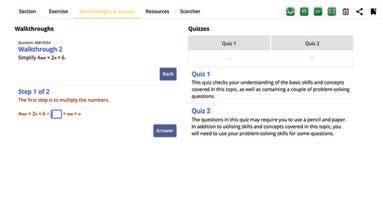
29 Arevisedsetof differentiatedauto-marked practicequizzes perlessonwithsavedscores
30 Auto-markedmaths literacyactivitiesteststudents ontheirabilitytounderstandandusethekey mathematicallanguageusedinthechapter

31 Auto-markedpriorknowledgepre-test (the‘Warm-upquiz’oftheprintbook)fortestingtheknowledgethatstudents willneedbeforestartingthechapter
32 Auto-markedprogressquizzesandchapterreviewquestions inthechapterreviewscanbecompletedonline
DOWNLOADABLEPDFTEXTBOOK
33 InadditiontotheInteractiveTextbook,a PDFversionofthetextbook hasbeenretainedfortimeswhenuserscannotgo online.PDFsearchandcommentingtoolsareenabled.
ONLINETEACHINGSUITE
34 NEW DiagnosticAssessmentTool included withtheOnlineTeachingSuiteallowsforflexible diagnostictesting,reportingandrecommendations forfollow-upworktoassistyoutohelpyour studentstoimprove
35 NEW PowerPointlesson summariescontainthe mainelementsofeachlessoninaformthatcanbe annotatedandprojectedinfrontofclass
36 LearningManagementSystem withclass andstudentanalytics,includingreportsand communicationtools
37 Teacherviewofstudents’workand self-assessment allowstheteachertoseetheir class’sworkout,howstudentsintheclassassessed theirownwork,andany‘redflags’thattheclass hassubmittedtotheteacher
38 Powerfultestgenerator withahugebankof levelledquestionsaswellasready-madetests
39 Revampedtaskmanager allowsteachersto incorporatemanyoftheactivitiesandtoolslisted aboveintoteacher-controlledlearningpathways thatcanbebuiltforindividualstudents,groupsof studentsandwholeclasses
40 Worksheets,Skillanddrill,mathsliteracy worksheets,and twodifferentiatedchapter testsineverychapter,providedineditableWord documents
41 Moreprintableresources: allPre-testsand Progressquizzesareprovidedinprintableworksheet versions

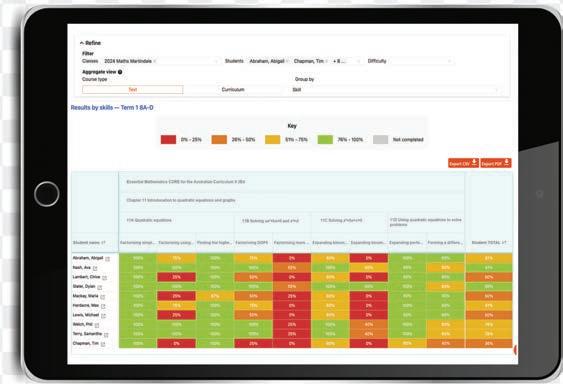
1 Computationwith positiveintegers

Essentialmathematics:whycomputationwithpositive integersisimportant
Skilledworkersinthetechnical,construction,andserviceindustriesneedtoperformaccurate computationsandmakerealisticestimates.
Chefsusemultiplicationordivisionwhenscalingrecipesupordown;forexample,thewhole numberweightofglazedcherriesforfourweddingcakes = 4 × 360 g = 1440 g.
Alandscapegardenerusesdivisiontofindhowmanybagsofmulchareneeded;forexample,the totalgardenareaisdividedbythenumberofsquaremetresthatonebagofmulchwillcover.
Anursecountsthenumberofheartbeatsinaperiodof 20 secondsandmultipliesbythreeto estimateapatient’sheartrateinbeatsperminute.
Rogainingisacompetitionusingmapskillstofindcheckpointsinbushland.Competitorscount stepsandmentallycalculatedistancesrun,ascalculatorsarenotpermitted.
Itismostusefulwhenshoppingtomentallyestimatethetotalwholenumbercostofafewitems.

Inthischapter
1APlacevalue (Consolidating)
1BAddingandsubtracting positiveintegers
1CAlgorithmsforadditionand subtraction
1DMultiplyingsmallpositive integers
1EMultiplyinglargepositive integers
1FDividingpositiveintegers
1GEstimatingandrounding positiveintegers (Consolidating)
1HOrderofoperationswith positiveintegers
AustralianCurriculum9.0
NUMBER
Representnaturalnumbersinexpanded notationusingplacevalueandpowers of 10 (AC9M7N03)
Compare,orderandsolveproblems involvingadditionandsubtractionof integers(AC9M7N07)
Usemathematicalmodellingtosolve practicalproblemsinvolvingrational numbersandpercentages,including financialcontexts;formulateproblems, choosingrepresentationsandefficient calculationstrategies,usingdigitaltools asappropriate;interpretand communicatesolutionsintermsofthe situation,justifyingchoicesmadeabout therepresentation(AC9M7N09)
©ACARA
Onlineresources
Ahostofadditionalonlineresources areincludedaspartofyourInteractive Textbook,includingHOTmathscontent, videodemonstrationsofallworked examples,auto-markedquizzesand muchmore.
1 Writedownthelargernumberfromeachpairofnumbers. 9, 11 a 137, 129 b 99, 104 c 10102, 9870 d
2 Foreachofthefollowing,matchthesymbol(A, B, C or D)tothegivenword(a, b, c,and d). add a A subtract b
multiply c
3 Writeeachofthefollowingasnumbers.
fifty-seven a onehundredandsixteen b twothousandandforty-four c eleventhousandandtwo d
4 Whichnumberis:
2 morethan 11? a 5 lessthan 42? b 1 lessthan 100? c
3 morethan 7997? d double 13? e halfof 56? f
5 Completethesepatterns,showingthenextfournumbers.
a
7
14
6 Howmanyequalgroupscan 48 bedividedintoifthesizeofeachgroupis:
7 Givetheresultforeachofthesesumsanddifferences.
8 Givetheresultforeachofthesemultiplicationsanddivisions. 5 × 6
9 Arrangethesenumbersfromsmallesttolargest.
37, 73, 58, 59, 62, 159 a 301, 103, 31, 310, 130 b 29143, 24913, 13429, 24319, 24931 c
10 Whatistheremainderwhenthesenumbersaredividedby 3? 12 a 10 b 37 c
1A 1A Placevalue
Learningintentions
CONSOLIDATING
• Tounderstandhowplacevalueworksinthedecimal(Hindu-Arabic)system.
• Tobeabletoidentifytheplacevalueofdigitsindifferentnumbers.
• Tobeabletowritebasicnumeralsinexpandedformtohighlightplacevalues.
• Tobeabletocomparetwopositiveintegersbyconsideringthedigitsineachposition.
Keyvocabulary: placevalue,digit,decimalsystem,Hindu-Arabicsystem,positiveinteger
Thedecimalsystemisthenumbersystemusedmostoftentoday.ItisalsocalledtheHindu-Arabicsystem. Itusesthedigits 0, 1, 2, 3, 4, 5, 6, 7, 8 and 9.ThedecimalsystemoriginatedinancientIndiaabout 3000 BCE andspreadacrossEuropethroughArabictextsoverthenext 4000 years.
Lessonstarter:Writethelargestnumber
Writethelargestpossiblenumberusingthesedigits.Digitscannot berepeated.
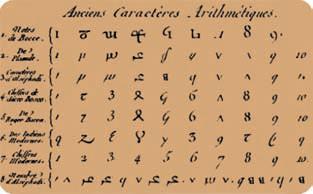
Explainwhyyournumberisthelargestpossible.
Keyideas
Thesymbols 0, 1, 2, 3, 4, 5, 6, 7, 8 and 9 arecalled digits
AFrenchdocumentshowingthe historyoftheHindu-Arabicnumber system.
Thevalueofeachdigitdependsonitsplaceinthenumber. The placevalue ofthedigit 2 inthenumber 3254,forexample,is 200
3254 = 3000 + 200 + 50 + 4
Thebasicnumeral 3254 canbewritteninexpandedformas 3254 = 3 × 1000 + 2 × 100 + 5 × 10 + 4 × 1 orinexpandedformwithindexnotationas 3254 = 3 ×
Symbolsusedtocomparenumbersincludethefollowing. =(equalto) 1 + 3 = 4 or 10−7 = 3
¢ (notequalto) 1 + 3 ¢ 5 or 11 + 38 ¢ 50
> (greaterthan) 5 > 4 or 100 > 37
Å (greaterthanorequalto) 5 Å 4 or 4 Å 4
< (lessthan) 4 < 5 or 13 < 26
Ä (lessthanorequalto) 4 Ä 5 or 4 Ä 4
¥ (approximatelyequalto) 4.02 ¥ 4 or 8997 ¥ 9000
.
A positiveinteger isawholenumber(greaterthanzero);e.g. 1, 2, 3,...areallpositiveintegers.
Exercise1A
Und er stand ing
1 Forthenumber 5207,writedownwhichdigitisinthe:
Q1Hint:Thetendigitsused inournumbersystemare 0, 1, 2, 3, 4, 5, 6, 7, 8 and 9. tensplace a thousandsplace b hundredsplace c onesplace d
2 Writedownthesenumbersusingdigits. forty-six a twohundredandsixty-three b seventhousand,fourhundredandtwenty-one c thirty-sixthousandandfifteen d
3 Whichsymbol(A, B, C, D, E or F)matchesthegivenwords(a, b, c, d, e and f)? notequalto a = A lessthan b ¢ B greaterthanorequalto c > C equalto d Å D greaterthan e < E lessthanorequalto f Ä F Fluency
Example1Findingplacevalue
Writedowntheplacevalueofthedigit 4 inthesenumbers. 437 a 1043 b
Solution
a 4 × 100 = 400
b 4 × 10 = 40
Explanation
The 4 hasvalue 4 × 100
The 3 hasvalue 3 × 10
The 7 hasvalue 7 × 1
The 1 hasvalue 1 × 1000
The 0 hasvalue 0 × 100
The 4 hasvalue 4 × 10
The 3 hasvalue 3 × 1
Nowyoutry
Writedowntheplacevalueofthedigit 6 inthesenumbers. 162 a 4628 b

4 Writedowntheplacevalueofthedigit 7 inthesenumbers.
Q4Hint:Writeyouransweras 7, 70, 700, 7000 or 70000 37 a
5 Writedowntheplacevalueofthedigit 3 inthesenumbers.
Example2Writingnumbersinexpandedform
a
Write 472 inexpandedform.
Write 472 inexpandedformwithindexnotation. b
Solution
a 472 = 4 × 100 + 7 × 10 + 2 × 1
b 472 = 4 ×
Nowyoutry
Write 356 inexpandedform. a
Explanation
Writeeachdigitseparatelyandmultiplyby 100 forthehundredsdigit, 10 forthetensdigit and 1 fortheunitsdigit.
Firstwritethenumberinexpandedform.
Thennotethat 100 = 102 , 10 = 101
Write 356 inexpandedformwithindexnotation. b
6 Writethefollowingnumbersinexpandedform.
7 Writethefollowingnumbersinexpandedformwithindexnotation.
8 Statewhethereachofthesestatementsistrueorfalse.
5 > 4 a


Q8Hint: < lessthan Ä lessthanorequalto > greaterthan Å greaterthanorequalto = equalto ¢ notequalto l
Problem-solving and reasoning
Example3Arrangingnumbers
Arrangethesenumbersfromsmallesttolargest.
29, 36, 18, 132, 1001, 99, 592, 123, 952
Solution
18, 29, 36, 99, 123, 132, 592, 952, 1001
Nowyoutry
Arrangethesenumbersfromsmallesttolargest.
37, 102, 117, 9001, 324, 9, 312, 8413, 799
Explanation
9,109(½),10,11
Thesmallesttwo-digitnumberhasthesmallest numberinthetenscolumn. Thenchoosethenextsmallesttwo-digit, andsoon,beforemovingontothree-digitand four-digitnumbers.
9 Arrangethesenumbersfromsmallesttolargest.
55, 45, 54, 44 a
b 23, 951, 136, 4 c
d 12345, 54321, 34512, 31254 e
, 29, 92, 927,
10 Inthefollowingquestions,digitscannotbeusedmorethanonce,andallthegivendigitsmustbe used.Donotuseadecimalpoint.
a Writethelargestpossiblenumberusingthedigits 2, 7 and 8
b Writethesmallestpossiblenumberusingthedigits 9, 1, 3, 6 and 4
11 Howmanynumberscanbemadeusingthegivendigits?Digitsarenotallowedtobeusedmorethan onceandallthegivendigitsmustbeused. 2, 8 and 9 a 1, 6 and 7 b 2, 5, 6 and 7 c
Largenumbers
12
12 Thenamesoflargenumbersdependonthenumberofdigitsgroupedintothrees.Forexample, 1000 is 1 thousand, 1000000 is 1 millionand 1000000000 is 1 billion.
a Writethesenumbersusingdigits.
7 thousand i 46 thousand ii 712 thousand iii 5 million iv 44 million v 6 billion vi 437 billion vii 15 trillion viii
b Researchthenumber 1 googol andwriteasentenceexplaining whatitis.
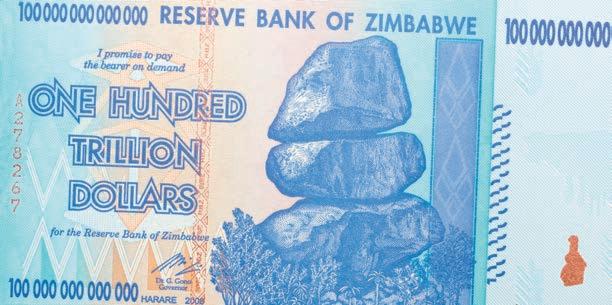
1B 1B Addingandsubtractingpositiveintegers
Learningintentions
• Tounderstandthatnumberscanbeaddedinanyorder,butthatforsubtractionorderdoesmatter.
• Tobeabletousethementalstrategiespartitioning,compensatinganddoubling/halvingtocalculateasumor differenceofpositiveintegersmentally.
Keyvocabulary: partitioning,compensating,mentalstrategy
Theprocessoffindingthetotalvalueoftwoormore numbersiscalledaddition.Thewords‘plus’,‘add’and‘sum’ arealsousedtodescribeaddition.
Theprocessforfindingthedifferencebetweentwo numbersiscalledsubtraction.Thewords‘minus’,‘subtract’ and‘takeaway’arealsousedtodescribesubtraction.
Lessonstarter:Yourmentalstrategy
Manyproblemsthatinvolveadditionandsubtractioncanbe solvedmentallywithouttheuseofacalculatororwritten working.
Explainyourmentalstrategyforworkingouttheanswerto theseproblems.
132 + 245 • 99 + 35 • 73−41 •
Keyideas
Thesymbol + isusedtoshowadditionorfindasum.
Forexample: 4 + 3 = 7
765 +3 4 8 3
• Notethattheorderdoes not matterwithaddition.
Forexample: 5 + 2 = 2 + 5 and 21 + 12 = 12 + 21
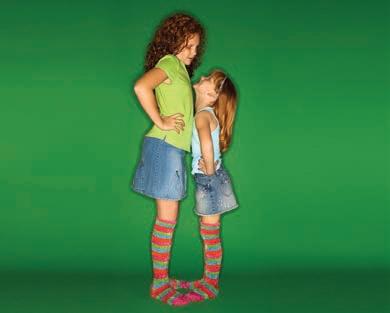
Thesymbol isusedtoshowsubtractionorfindadifference.
Forexample: 7−2 = 5
76 2 5 8 43
• Notethattheorder does matterwithsubtraction.
Forexample: 5−2 ¢ 2−5 and 21−12 ¢ 12−21
Mentaladditionandsubtractioncanbedoneusingdifferentstrategies.
• Partitioning (Groupingdigitsinthesameposition)
171 + 23 = 194
428−114 = 314
• Compensating (Makinga 10, 100 etc.andthenadjustingorcompensatingbyadding orsubtracting)
46 + 9 = 46 + 10−1
= 55
138−99 = 138 −100 + 1 = 39
Youcanfindtheheightdifferenceoftwopeople bysubtractingtheshorterperson’sheightfrom thetallerperson’sheight.
Exercise1B
Und er stand ing
1a Listthreewordsthattellyouwhentouse addition
b Listthreewordsthattellyouwhentouse subtraction
2 Writethenumberwhichis:
2 morethan 5 a 3 morethan 7 b
58 morethan 11 c 5 lessthan 9 d
7 lessthan 19 e 137 lessthan 157 f
3a Addtofindthesumofthesepairsofnumbers.
2 and 6 i 19 and 8 ii 62 and 70 iii
Q1Hint:Choosefromthesewords: minus,add,sum,subtract,plus, takeaway

b Subtract(takeaway)tofindthedifferencebetweenthesepairsofnumbers. 11 and 5 i 29 and 13 ii 101 and 93 iii
4 Givetheresultforeachoftheseproblems.
7 plus 11 a 22 minus 3 b thesumof 11 and 21 c 128 add 12 d 36 takeaway 15 e thedifferencebetween 13 and 4 f Fluency
Example4Mentaladditionandsubtraction
Usethesuggestedstrategytomentallyworkouttheanswer.
132 + 156 (partitioning) a 429−203 (partitioning) b 25 + 19 (compensating) c 56−18 (compensating) d
Solution Explanation
a 132 + 156 = 288
100 + 30 + 2 Groupthehundreds, 100 + 50 + 6
Nowyoutry
Usethesuggestedstrategytomentallyworkouttheanswer. 423 + 236 (partitioning) a 758−321 (partitioning) b 46 + 29 (compensating) c 134−28 (compensating) d
5 Mentallyfindtheanswerstothesesums.Hint:Usethe partitioningstrategy.
Q5Hint:Workoutthe answerbyadding theones,thenthe tens,andsoon.
6 Mentallyfindtheanswerstothesedifferences.Hint:Usethepartitioningstrategy. 29−18 a
b 94−43 c 249−137 d
g
7 Mentallyfindtheanswerstothesesums.Hint:Usethe compensatingstrategy.
i

Q7Hint:Roundoneofthenumbersto thenearestten,thencompensateby addingorsubtractingthedifference.
+ 52 f
b 19 + 76 c 18 + 115 d 31 + 136 e
8 Mentallyfindtheanswerstothesedifferences.Hint:Usethecompensatingstrategy. 35−11 a 45−19 b 156−48 c 244−22 d 376−59 e 5216−199 f
Problem-solving and reasoning
9 Maryhas $101 inherpiggybank.Shetakesout $22 tobuy ajumper.Howmuchmoneyremainsinherpiggybank?

9–12 11–15

10 Garyworked 7 hoursonMonday, 5 hoursonTuesday, 13 hoursonWednesday, 11 hoursonThursday and 2 hoursonFriday.WhatisthetotalnumberofhoursthatGaryworkedduringtheweek?
11 Inabattinginnings,Philhit 126 runsandMariohit 19 runs.How manymorerunsdidPhilhitcomparedtoMario?
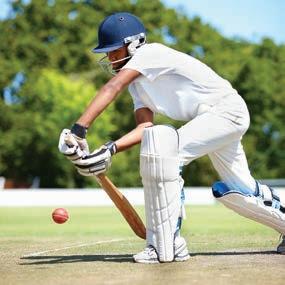
12 Mentallyfindtheanswerstothesemixedproblems.
13 Matthas 36 cardsandAndyhas 35 morecardsthanMatt. HowmanycardsdoesAndyhave? a Iftheycombinetheircards,howmanydotheyhaveintotal? b
14 Arethesestatementstrueorfalse?
15 Completethesenumbersentences.(Theletters a, b and c representnumbers.)
16 Amagicsquarehaseveryrow,columnandmaindiagonaladdingtothesamenumber,calledthemagic sum.Forexample,thismagicsquarehasamagicsumof 15
Findthemagicsumsforthesesquares,thenfillinthemissingnumbers.
1C 1C Algorithmsforadditionandsubtraction
Learningintentions
• Tobeabletoapplytheadditionalgorithmto ndthesumofpositiveintegers.
• Tobeabletoapplythesubtractionalgorithmto ndthedifferenceofpositiveintegers.
Keyvocabulary: borrow,carry,algorithm,placevalue
Toaddorsubtractlargernumberswecanuseastep-by-stepprocesscalledanalgorithm. Addingcaninvolvecarryinga‘one’tothenextcolumn,whilesubtractingcaninvolveborrowinga‘one’ fromthenextcolumn.
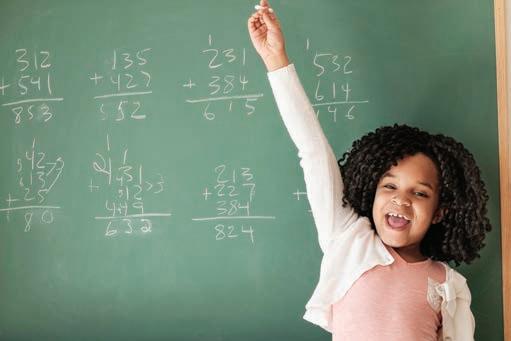
Theadditionalgorithminvolvescarryingthe’one’tothenext column.
Lessonstarter:Themissingdigits
Discusswhatdigitsshouldgointheemptyboxes.Givereasonsforyouranswers.
Keyideas
Toaddlargernumbers:
• Arrangethenumbersvertically(aboveeachother)sothatthedigits withsimilar placevalue areinthesamecolumn.
• Adddigitsinthesamecolumn,startingontheright.
• Ifthedigitsaddtomorethan 9, carry the 1 tothenextcolumn.
Tosubtractlargernumbers:
• Arrangethenumbersverticallysothatthedigitswithsimilarplace valueareinthesamecolumn.
• Subtractdigitsinthesamecolumntop-down,startingontheright.
• Ifthedigitssubtracttolessthan 0, borrow a 1 fromthenextcolumn toformanextra 10.
Exercise1C
1 Mentallyfindtheresultstothesesimplesums.
2 Mentallyfindtheresultstothesesimpledifferences.
3 Whatisthemissingdigitintheseproblems?
Example5Addinglargernumbers
Givetheresultforeachofthesesums.
Addthedigitsvertically. 6 + 6 = 12,socarrythe 1 tothetenscolumn.
b 14139 + 172 611 9 + 2 = 11,socarrya 1 tothetenscolumn. 1 + 3 + 7 = 11,socarrya 1 tothehundreds column.
Nowyoutry
Givetheresultforeachofthesesums.
4 Givetheresultforeachofthesesums.

5 Givetheresultforeachofthesesums.
Example6Subtractinglargernumbers
Givetheresultforeachofthesedifferences.
a 6
b 4 ✁ 511 ✁ 2 16 −138 388
Givetheresultforeachofthesedifferences.
6 Findtheanswerstothesedifferences.
7 Findtheanswertothesedifferences.

Q5Hint:Youwillneedtocarrythe ‘one’twiceinthesequestions.
Borrow 1 from 7 tomake 14−5 = 9
Thensubtract 1 from 6 (not 7).
Borrow 1 from 2 tomake 16−8 = 8.
Borrow 1 from 5 tomake 11−3 = 8 4−1 = 3.

Q6Hint:Forparts c to h,youwill needtoborrowa‘one’fromthe tenscolumn.

Q7Hint:Youwillneedtoborrow
Problem-solving and reasoning
8 FarmerGreenowns 287 sheep,FarmerBrownowns 526 sheep andFarmerGreyowns 1041 sheep.Howmanysheeparethere intotal?

9 Acar’sodometershows 12138 kilometresatthestartofajourneyand 12714 kilometresattheendof thejourney.Howfarwasthejourney?
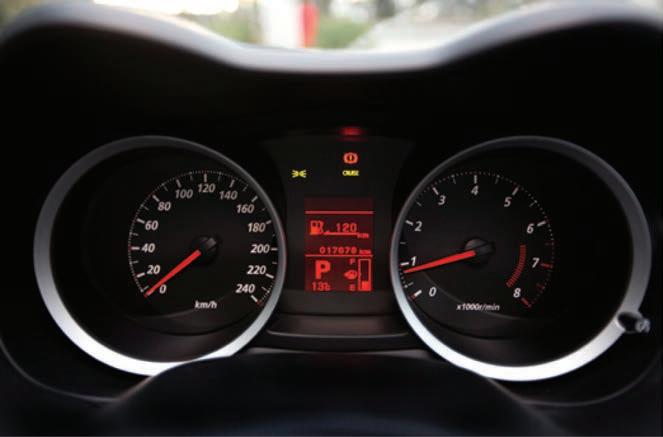
10 Givetheresultforeachofthesesums.
11 Findthemissingdigitsinthesesumsanddifferences.
12a Whatarethemissingdigitsinthissum? 2 3 + 421
b Explainwhythereismorethanonepossiblesetofmissingdigitsinthesumabove.Givesome examples.
13 Completethesemagicsquares.Rememberthatinamagicsquare,eachrow,columnanddiagonalhas thesamesum.
1D 1D Multiplyingsmallpositiveintegers
Learningintentions
• Tounderstandthecommutativeandassociativelawsformultiplication.
• Tobeabletousementalstrategiesto ndproducts.
• Tobeabletoapplythemultiplicationalgorithmto ndtheproductofasingle-digitnumberbyapositiveinteger.
Keyvocabulary: product,commutativelaw,associativelaw,distributivelaw,algorithm
Themultiplicationoftwonumbersrepresentsarepeatedaddition.Forexample, 4 × 2 couldbethoughtof as 4 groupsof 2 or 2 + 2 + 2 + 2,or 4 × 2 couldbethoughtofas 2 groupsof 4 or 2 × 4 or 4 + 4
× 2
Lessonstarter:Museumtickets
Yourteacherpurchases 21 ticketsat $9 eachforaclassexcursiontothemuseum.Youneedtoworkout thetotalcost.
Lookatthefollowingstrategies.Doanyofthemgivethecorrectanswer?
• 21 × 9 isthesameas 20 × 10,sotheansweris $200
• 21 × 9 isthesameas 21 × 10−1,sotheansweris 210−1 = $209
• 21 × 9 isthesameas 20 × 9 + 1,sotheansweris 180 + 1 = $181
• 21 × 9 isthesameas 21 × 10−21,sotheansweris 210−21 = $189
• 21 × 9 isthesameas 20 × 9 + 9,sotheansweris 180 + 9 = $189
Keyideas
Findingthe product oftwonumbersinvolvesmultiplication. Wesay‘theproductof 2 and 3 is 6’.
a × b = b × a
• Theorderdoes not matterwhenyoumultiplynumbers.Thisisthe commutativelaw Forexample: 2 × 3 = 3 × 2 5 × 11 = 11 × 5
a × (b × c) = (a × b) × c
• Theresultofaddingormultiplyingthreeormorenumbersdoesnotdependonhowtheyare grouped.Thisisthe associativelaw.Forexample: (2 × 3) × 4 = 2 × (3 × 4)
92 4 × 3 = 12 4 × 2 + 1 = 9
Mentalstrategiesformultiplicationinclude:
• Knowingyourmultiplicationtablesoffbyheart.Forexample: 9 × 7 = 63 12 × 3 = 36
• Changingtheorder.Forexample:
15 × 3 = 3 × 15 (3 groupsof 15) = 45
5 × 13 × 2 = 5 × 2 × 13 = 10 × 13 = 130
• Usingthe distributivelaw bymakinga 10, 100 etc.andthenadjustingbyaddingor subtracting.Thedistributivelawmeansthataddingnumbersandthenmultiplyingthetotal givesthesameanswerasmultiplyingeachnumberfirstandthenaddingtheproducts.For example:
6 × 21 = 120 +6 = 126 6 × 206 × 1 7 × 18 = 14014 = 126 7 × 207 × 2
• Usingthedoublingandhalvingstrategybydoublingonenumberandhalvingtheother.
5 × 7 × 4 = 10 × 7 × 2 = 70 × 2 = 140 Double the 5Halve the 4
Exercise1D
Und er stand ing
1 Answertrueorfalse. Theproductof 4 and 7 is 21 a
4 × 31 = 4 × 30 + 4 ×
2 Writethemissingnumber.
3 Useyourknowledgeofthemultiplicationtablestowritetheanswer.
Fluency
Example7Usingmentalstrategiesformultiplication
Useamentalstrategytofind: 3 × 13 a 4 × 19 b 5 × 24 c
Solution
Explanation
a 3 × 13 = 30 + 9 = 39 3 × 13 = 3 × 10 + 3 × 3
Thedistributivelawisbeingused.
b 4 × 19 = 80−4 = 76 4 × 19 = 4 × 20−4 × 1
Thedistributivelawisbeingused.
c 5 × 24 = 10 × 12 = 120 Thedoublingandhalvingstrategyisbeingused.
Nowyoutry
Useamentalstrategytofind: 5 × 41 a 7 × 19 b 5 × 16 c
4 Findtheresultstotheseproductsmentally.Checkyouranswerswithyourcalculator.

Q4Hint:Forpart a,workout 5 × 20 andthenadd 5 × 1
5 Findtheanswerstotheseproductsmentally.
Q5Hint:Forpart a,workout 3 × 20 andthensubtract 3 × 1 3 × 19 a 2 × 19 b 2 × 29 c 4 × 29 d 5 × 18 e 7 × 18 f 3 × 39 g 4 × 49 h
6 Findtheanswerstotheseproductsmentally.


Q6Hint:Doubleone numberandhalve theother.So 5 × 14 = 10 × 7 = 70
Example8Multiplicationshowingworking
Givetheresultforeachoftheseproducts.
31 × 4
Nowyoutry
Givetheresultofeachoftheseproducts.
7 Givetheresultofeachoftheseproducts,showingworking.
8 Whatisthemissingdigitintheseproducts?
9 Eightticketscosting $33 eacharepurchasedforaconcert.Whatisthetotalcostofthetickets?

10 Acircularracetrackis 240 metreslongandRoryrunssevenlaps.HowfardoesRoryrunintotal?

11 ReggieandAngelocombinetheirpacksofcards.Reggiehasfivesetsof 13 cardsandAngelohasthree setsof 17 cards.Howmanycardsarethereintotal?
12 Classifythesestatementsastrueorfalse.
Missingdigits
13 Findthemissingdigitsintheseproducts.
14 Howmanydifferentwayscanthetwospacesbefilledinthisproblem?Explainyouranswer.
1E 1E Multiplyinglargepositiveintegers
Learningintentions
• Tobeabletomultiplybyapoweroften.
• Tobeabletoapplythemultiplicationalgorithmto ndtheproductofanytwopositiveintegers.
Keyvocabulary: product,algorithm,placevalue
Therearemanysituationsthatrequirethemultiplicationoflargenumbers.Forexample,findingthetotal amountmadefromselling 40000 ticketsat $23 each.Anotherexampleisfindingtheareaofarectangular parkwithlengthandwidthdimensionsof 65 metresby 122 metres.Doingsuchcalculationsbyhandrequires anumberofsteps.
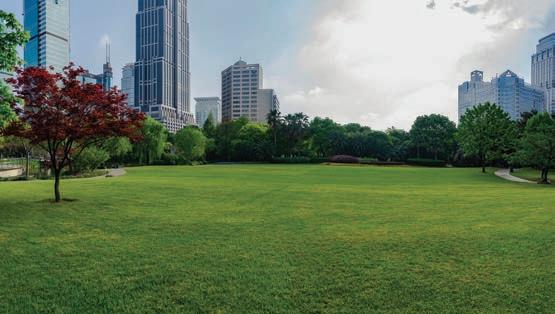
Theareaofarectangular-shapedparkcanbecalculatedby multiplyingthepark’slengthbyitswidth.
Lessonstarter:Spottheerrors
Therearethreetypesoferrorsintheworkingshownforthisproblem.Findtheerrorsanddescribethem.
Keyideas
Whenmultiplyingby 10, 100, 1000, 10000 etc.eachdigitmovestotheleftbythenumberofzeros.
2 × 100 = 20041 × 10 = 410279 × 1000 = 279000
Astrategyformultiplyingbymultiplesof 10, 100 etc.istofirstmultiplybythenumberwithout thezerosthenaddthezerostotheanswerlater.
Forexample: 21 × 3000 = 21 × 3 × 1000 = 63 × 1000 = 63000
Tomultiplylargenumbers,dividetheproblemintosmallerproductsandthenaddthetotals.
37 × 12
× 14
37 × 2
× 10
+ 74
× 4
× 10
Exercise1E
Und er stand ing
1 Writethemissingnumber: 10, 100 or 1000 35 × = 350 a 21 × = 2100 b
2 Answertrueorfalse.
6 × 200 = 6 × 2 × 100 a
9 × 3000 = 9 × 3 × 100 c
b
3 Whichofthefollowingisthecorrectset-upfor 23 × 11?
× =
×
= 2130 d
Example9Multiplyinglargenumbers
Givetheresultforeachoftheseproducts.
37 × 100 a 21 × 50 b 87 × 13 c
Solution
a 37 × 100 = 3700
b 21 × 50 = 21 × 5 × 10 = 105 × 10 = 1050
c 87 × 13 261
Explanation
Movethe 3 andthe 7 twoplacestotheleftand addtwozeros.
Firstmultiplyby 5,thenmultiplyby 10 21 × 5 105
Firstmultiply 87 × 3 Thenmultiply 87 × 10. Addtheresultstogivetheanswer.
Nowyoutry
Givetheresultforeachoftheseproducts. 53 × 100 a 32 × 40 b 74 × 17 c
4 Givetheresultofeachoftheseproducts.
4 × 100 a
×
5 Findtheseproducts.
× 20 c
× 30 b
Q5Hint:Firstmultiplyby thesinglenon-zerodigit, thenwritethezeros: 12 × 20 = 12 × 2 × 10 12 × 20 a
6 Findtheseproducts.
Problem-solving and reasoning
7 Mandybuys 28 ticketsat $15 each.Whatisthetotalcostofthetickets?

(½),108,9(½),11,12
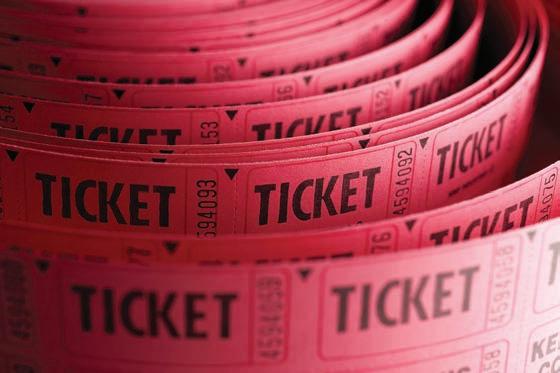
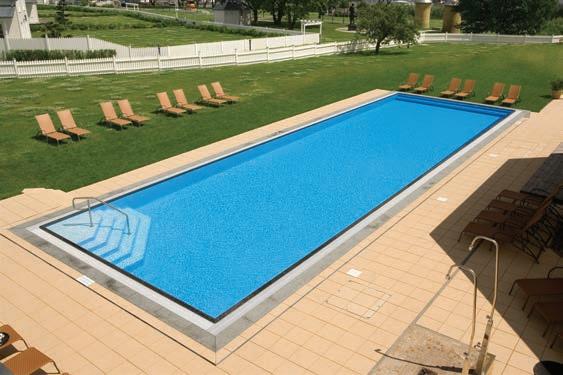
9 Findtheanswertoeachofthefollowingproducts(showyourworking).
10 Waldobuys 215 metresofpipeat $28 permetre.Whatisthetotalcostofpiping?

11 Howmanysecondsarethereinoneday?

Q11Hint:Thereare 60 seconds inaminute.
12 Ifbothnumbersinamultiplicationproblemhaveatleastthreedigits,thenmorestepsneedtobe shown.Findtheseproducts.
13 Findthemissingdigitsintheseproducts.
1F 1F Dividingpositiveintegers
Learningintentions
• Toknowthatadivisionoftwonumberscanresultinaquotientandaremainder,andtheresultcanbewrittenasa mixednumberifthereisaremainder.
• Tobeabletousementalstrategiesto ndquotients.
• Tobeabletoapplytheshortdivisionalgorithmtodividepositiveintegers.
Keyvocabulary: quotient,dividend,divisor,remainder
Divisionisusedtofindthenumberofequalgroupsfromagiventotal.Dividing 20 applesamongfive peopleordividing $10000 betweenthreebankaccountsareexamplesofwhendivisioncanbeused.
Lessonstarter:Arrangingcounters
Atotalof 24 counterssitonatable.Usingpositiveintegers,inhowmanywayscanthecountersbedivided intoequal-sizedgroupswithnocountersleftover?
• Isitalsopossibletodividethecountersintoequal-sizedgroupsbutwithtwo countersleftover?
• Iffivecountersaretoremain,howmanyequal-sizedgroupscanbeformed andwhy?
Keyideas
Thenumberofequal-sizedgroupsmadebydividingiscalledthe quotient
Thetotalbeingdividediscalledthe dividend.Thesizeoftheequalgroupsiscalledthe divisor. Anyamountremainingafterdivisionintoequal-sizedgroupsiscalledthe remainder 7 ÷ 3 = 2 and 1 remainder
total being divided (dividend) size of equal groups (divisor) quotient
Theorder does matterwhenyoudividenumbers.Youcannot swapnumbersinadivisiontomakethecalculationeasier.Forexample:
6 ÷ 3 ¢ 3 ÷ 6 (10 ÷ 5) ÷ 2 ¢ 10 ÷ (5 ÷ 2)
Useshortdivisiontoworkwithlargernumbers.
• Startbydividingthedivisorintothefirst(left)digit,thencarryanyremainder. Thisexampleshowsthat 413 ÷ 3 = 137 and 2 remainder.
4 ÷ 3 = 1 and 1 rem. 11 ÷ 3 = 3 and 2 rem. 23 ÷ 3 = 7 and 2 rem. ) 3413 137 1 2
So 413 ÷ 3 = 137 and 2 remainder = 137 2 3
Exercise1F
Und er stand ing
1 Findtheremainderwhen 24 isdividedby:
Q1Hint:Theremaindercan bezero.

2 Writethenumberthatismissinginthesestatements.
8 ÷ 2 = 4 isthesameas 4 × ? = 8 a
36 ÷ 12 = 3 isthesameas ? × 12 = 36 b
42 ÷ ? = 6 isthesameas 6 × 7 = 42 c
72 ÷ 6 = ? isthesameas 12 × 6 = 72 d
3 Considerthedivision 83 ÷ 7 = 11 and 6 leftover.Whichnumberis: theremainder a thequotient b thedivisor c thedividend d
Fluency
Example10Usingmentalstrategiesfordivision
Useamentalstrategytofindtheanswer.
(Useyourknowledgefrommultiplicationtables.)
c
÷ 3 =
Nowyoutry
(Halvebothnumbersrepeatedly.)
Useamentalstrategytofindtheanswer.
4 Useyourknowledgeofmultiplicationtablestofindthequotient.Checkwithacalculator.
5 Findtheanswertotheseusingamentalstrategy.

6 Findtheanswerstotheseusingamentalstrategy.
7 Findtheanswerstotheseusingamentalstrategy.

Q6Hint:Forpart a,remember that 90 ÷ 3 = 30.

Q7Hint:Halvebothnumbers, sincetheyarebotheven.So,
8 Writetheanswerstothesedivisions,whichinvolve 0sand 1s.
Example11Usingshortdivision
Useshortdivisiontofindthequotientandremainder.Thenwritetheresultusingamixednumeral.
Nowyoutry
Useshortdivisiontofindthequotientandremainder.Thenwritetheresultusingamixednumeral. 4 ) 89 a 6 ) 237 b
9 Usetheshortdivisionalgorithmtofindthequotientandremainder.Thenwritetheresultusinga mixednumeral. 3 ) 71 a
Problem-solving and reasoning
10 Writethemissingdigitineachofthesedivisions.
)
11 If 117 foodpacksaredividedequallyamongninefamilies,howmanypacks doeseachfamilyreceive?
12 SpringFreshCompanysellsmineralwaterinpacksofsixbottles. Howmanypacksarethereinatruckcontaining 744 bottles?
Q12Hint:Workout 6 ) 744 13
Astraightfencehastwoendposts.Italsohasotherpoststhatare dividedevenlyalongthefence 4 metresapart.Ifthefenceistobe 264 metreslong,howmanypostsareneeded,includingtheendposts?
14 FriendlyTaxiscantakeuptofourpassengerseach.Howmanytaxisare requiredtotransport 59 people?
15 Piesarepurchasedwholesaleatthreefor $4.Howmuchwillitcostto purchase 153 pies?


Q13Hint:First,considerhow manypostsareneededfor afence 12 metresin length.
16 Shortdivisioncanalsobeusedtodividebynumberswithmorethanonedigit. e.g. 215 ÷ 12 = 17 and 11 remainder.
Usetheshortdivisionalgorithmtofindthequotientandremainder.
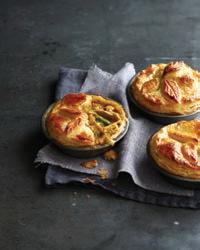
17 Inthissquare,everyrow,columnanddiagonalhasaproductof 6720.Findthemissingnumbers.
1 1A Writedowntheplacevalueofthedigit 5 inthesenumbers. 356 a 5103 b 857412 c
2 1A Howmanynumberscanbemadeusingthegivendigits?Digitsarenotallowedtobeused morethanonceandalldigitsmustbeused.
4, 6 and 8 a 1, 2, 3 and 9 b
3 1B Mentallyfindtheanswerstotheseproblems.
146 + 332 a 754−531 b 85−19 c 21 + 49−28 d
4 1B Arethesestatementstrue(T)orfalse(F)?
23−17 < 8 a 60−18 + 11 > 50 b
5 1C Givetheresultforeachofthesesumsanddifferences.
6 1D Findtheanswerstotheseproductsmentally. 6
7 1D Givetheresultforeachoftheseproducts.
8 1E Givetheresultforeachoftheseproducts.
1E Jackpurchases 15 basketballticketsat $21 each.Whatisthetotalcostofthetickets?
10 1F Findtheanswertotheseusingamentalstrategy.
11 1F Usetheshortdivisionalgorithmtofindthequotientandremainder.
1G 1G Estimatingandrounding positiveintegers
CONSOLIDATING
Learningintentions
• Tounderstandthatinsomepracticalsituations,anestimateorapproximationisacceptable.
• Tobeabletoroundnumberstoadegreeofaccuracy(e.g.tothenearest 100).
• Tobeabletoestimatenumericalanswerstoarithmeticquestionsbyroundingeachnumberinthequestion.
Keyvocabulary: estimate,approximation,rounding
Often,agoodestimateisenoughtoansweraquestionanditisnotnecessarytofindanexactanswer. Insuchcasesweuseroundingtohelp.Forexample,theapproximatetotalcostof 18 truckloadsofsoilat $54 perloadcouldbeestimatedas 20 × 50 = 1000,sothecostisabout $1000
Lessonstarter:Countingcrowds
Hereisaphotoofacrowdatasportingevent.Describehowyoumight estimatethenumberofpeopleinthephoto.Whatisyouranswer?How differentisyouranswerfromthoseofothersinyourclass?

Howwouldyouestimatethe numberofpeopleinthiscrowd?
Keyideas
An estimate isaninformedguess,an approximation isavalueclosetotherealvalue,and rounding involvesapproximatinganumbertoaspecifiedplacevalue.
Estimatesorapproximationscanbefoundbyroundingnumberstothenearest 10,
• Ifthenextdigitis 0, 1, 2, 3 or 4,thenrounddown.
• Ifthenextdigitis 5, 6, 7, 8 or 9,thenroundup.
Leadingdigitapproximationinvolvesroundingtothefirstdigit.Forexample: For 932,roundto 900
For 968,roundto 1000
Thesymbol ¥ means‘approximatelyequalto’.
Exercise1G
1 Havethesenumbersbeenroundedupordown?
2 Thefollowingnumbersaretoberoundedtothenearest 10.Shouldtheyberoundedupordown?
3 Thefollowingnumbersaretoberoundedtothenearest 100.Decideiftheywouldberoundedupor down.
a
g
Fluency
b
h
Example12Rounding
Roundthesenumbersasindicated.
86 (tothenearest 10) a
Solution
a 86 ¥ 90
b 4142 ¥ 4100
c
i
d
j
4142 (tothenearest 100) b
Explanation
Thedigitafterthe 8 isgreaterthanorequalto 5,soroundup.
Thedigitafterthe 1 islessthanorequalto 4,sorounddown.
Keepthe 1 andmakethefollowingdigitszero. Nowyoutry
Roundthesenumbersasindicated.
93 (tothenearest 10) a 5851 (tothenearest 100) b
4 Roundthesenumbersasindicated.
59 (nearest 10) a 32 (nearest 10) b
124 (nearest 10) c 185 (nearest 10) d
231 (nearest 100) e 894 (nearest 100) f
96 (nearest 10) g 584 (nearest 100) h
1512 (nearest 1000) i 1492 (nearest 1000) j
7810 (nearest 1000) k 10200 (nearest 1000) l
5 Roundthesenumbersusingleadingdigitapproximation.
Example13Usingleadingdigitapproximation

Q4Hint:Ifthenextdigitis 0, 1, 2, 3 or 4 rounddown. Otherwise,roundup.

Q5Hint:Roundtothefirstdigit ontheleft,so 284 ¥ 300.
Estimatetheanswerstothesequestionsbyfirstroundingeachnumbertotheleadingdigit.
42 × 7 a 95 × 326 b
Solution
a 42 × 7 ¥ 40 × 7 = 280
b 95 × 326 ¥ 100 × 300 = 30000
c 302 ÷ 29 ¥ 300 ÷ 30 = 10
302 ÷ 29 c
Explanation
Theleadingdigitin 42 isthe 4 inthe‘tens’column.
Thenearest‘ten’to 95 is 100,andtheleadingdigitin 326 isinthe‘hundreds’column.
302 roundsto 300 and 29 roundsto 30.
Nowyoutry
Estimatetheanswerstothesequestionsbyfirstroundingeachnumbertotheleadingdigit. 31 × 8 a
b
×
6 Useleadingdigitapproximationtoestimatetheanswer.
÷ 91 c

Q6Hint:Firstroundeach numbertotheleadingdigit beforemakingthecalculation.
Problem-solving and reasoning
7 Youpurchase 59 ticketsat $21 each.Giveanestimateforthe totalcostofthetickets.
8 Adiggercandig 29 scoopsperhourandwork 7 hoursperday. Approximatelyhowmanyscoopscanbedugover 10 days?

Hint:Forquestions 7 to 10,use leadingdigitapproximationto makeyourestimate.
9 Mostofthepensatastockyardarefullofsheep.Thereare 55 pensandoneofthepens has 22 sheep.Giveanestimateforthetotalnumberofsheepatthestockyard.
10 Awholeyeargroupof 159 studentsisroughlydividedinto 19 groups.Estimatethenumberin eachgroup.
11 Forthegivenestimates,decideiftheapproximateanswerisgoingtogivealargerorsmallerresult comparedtothetrueanswer. 58 + 97 ¥ 60 + 100 a 24 × 31 ¥ 20 × 30 b
¥ 130−80 c 267−110 ¥ 270−110 d
12 Itissensiblesometimestoroundonenumberupiftheothernumberisgoingtoberoundeddown. Useleadingdigitapproximationtoestimatetheanswerstotheseproblems.
13 ManyexamplesofAboriginalartincludedotpaintings.Herearetwoexamples.Estimatethenumber ofdotsineachone.
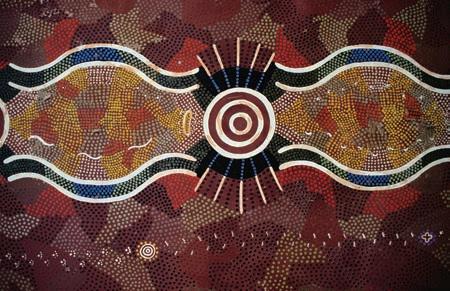
1H 1H Orderofoperationswithpositiveintegers
Learningintentions
• Toknowtheconventionfordeterminingorderofoperationsinanexpressioninvolvingmorethanoneoperation.
• Tobeabletoevaluatearithmeticexpressionsinvolvingmorethanoneoperation.
Keyvocabulary: operation,brackets,multiplication,division,addition,subtraction
Whencombiningtheoperationsofaddition,subtraction,multiplicationanddivision,aspecialorderneeds tobefollowed.Multiplicationanddivisionsithigherintheorderthanadditionandsubtraction.Thisaffects howwemightmakesenseofsimplemathematicalproblemsputintowords. Considerthesetwostatements.
2 groupsof 3 chairsplus 5 chairs
5 chairsplus 2 groupsof 3 chairs
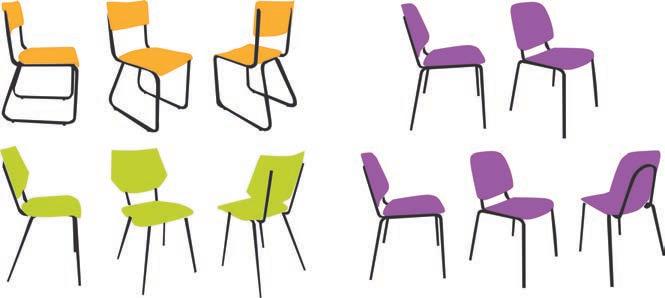
Inbothcases,thereare 2
Thisalsosuggeststhatfor 5 + 2 × 3,themultiplicationshouldbedonefirst.
Lessonstarter:Makeittrue!
Canyouinsertapairofbracketstomakethefollowingtrue?
Discusswhetheryouthinkthefollowingneedbracketstomakethemtrue.
Keyideas
Whenworkingwithmorethanone operation:
• Dealwith brackets first.
• Do multiplication and division next,workingfromlefttoright.
• Do addition and subtraction last,workingfromlefttoright.
Exercise1H
Und er stand ing
1 Whichgoesfirst?
a Additionormultiplication
b Bracketsordivision
c Subtractionorbrackets
d Multiplicationorsubtraction
2 Whichoperation(addition,subtraction,multiplicationordivision)isdonefirstintheseproblems?
)
Fluency 3(½)
Example14Usingorderofoperations
Useorderofoperationstofindthefollowingvalues.
5 + 10 ÷ 2 a 3 × (2 + 4) b
5 × 2−8 ÷ 4 c
6 × (2 + 10) −24 d 18−2 × (4 + 6) ÷ 5 e
Solution
a 5 + 10 ÷ 2 = 5 + 5 = 10
b 3 × (2 + 4) = 3 × 6 = 18
c 5 × 2−8 ÷ 4 = 10−2 = 8
d 6 × (2 + 10) −24 = 6 × 12−24 = 72−24 = 48
e 18−2 × (4 + 6) ÷ 5 = 18−2 × 10 ÷ 5 = 18−20 ÷ 5 = 18−4 = 14
Explanation
Dothedivisionbeforetheaddition.
Dealwithbracketsbeforemultiplication.
Dothemultiplicationanddivisionbeforethe subtraction.
Dealwithbracketsfirst.
Dothemultiplicationbeforesubtraction.
Dothesubtractionlast.
Dealwithbracketsfirst.
Dothemultiplicationanddivisionnext,working fromlefttoright.
Dothesubtractionlast.
Nowyoutry
Useorderofoperationstofindthefollowingvalues.
9−2 × 3 a
11 × (8−5) b
20 ÷ 10 + 7 × 3 c
12 ÷ (7−3) + 13 d
4 ÷ (13−11) × 3 + 6 e
3 Useorderofoperationstofindtheanswers.
1 + 2 × 3 a 5 + 7 × 2 b
9−10 ÷ 5 c 4 × (3 + 2) d
21 ÷ (3 + 4) e 18 ÷ (10−1) f
(7 + 2) ÷ 3 g (10−4) × 4 h
(6−5) ÷ 1 i 2 + 3 × 7 j
5 + 8 × 2 k 10−20 ÷ 2 l
22−16 ÷ 4 m 6 × 3 + 2 × 7 n
1 × 8−2 × 3 o 18 ÷ 9 + 60 ÷ 3 p 2 + 3 × 7−1 q 40−25 ÷ 5 + 3 r
63 ÷ 3 × 7 + 2 × 3 s 78−14 × 4 + 6 t
300−100 × 4 ÷ 4 u
4 Useorderofoperationstofindtheanswers.
2 × (3 + 2) a 18 ÷ (10−4) b
(19−9) ÷ 5 c 2 × (3 + 2) −1 d
10 ÷ (3 + 2) + 6 e 13 × (10 ÷ 10) −13 f
(100 + 5) ÷ 5 + 1 g 2 × (9−4) ÷ 5 h
50 ÷ (13−3) + 4 i 16−2 × (7−5) + 6 j
(7 + 2) ÷ (53−50) k 14− (7 ÷ 7 + 1) × 2 l
(20−10) × (5 + 7) + 1 m 3 × (72 ÷ 12 + 1) −1 n
48 ÷ (4 + 4) ÷ (3 × 2) o 20− (3 × 5 + 1) ÷ 4 p

Q3Hint:Rememberthat × and ÷ gobefore + and .Workfrom lefttorightafteryouhavechosen whichoperationgoesfirst.
Q4Hint:Dealwithbracketsfirst, then × and ÷ then + and .

Problem-solving and reasoning 5–7 7–10
5 Arethesestatementstrueorfalse?
5 × 2 + 1 = (5 × 2) + 1 a 10 × (3 + 4) = 10 × 3 + 4 b 21−7 ÷ 7 = (21−7) ÷ 7 c 9−3 × 2 = 9− (3 × 2) d
Example15Usingorderofoperationsinwordedproblems
Findtheresultif 6 ismultipliedbythesumof 2 and 7
Solution
6 × (2 + 7) = 6 × 9 = 54
Explanation
First,writetheproblemusingsymbolsand numbers.
Usebracketsforthesumsincethisoperationis tobecompletedfirst.
Nowyoutry
Findtheresultif 26 isdividedbythedifferencebetween 16 and 3
6 Findtheanswertothesewordedproblemsbyfirstwriting thesentenceusingnumbersandsymbols.
Triplethesumof 3 and 6 a
Doubletheresultof 20 dividedby 4 b 44 dividedby 11 plus 4 c 5 morethantheproductof 6 and 12. d
Theresultof 60 dividedby 12 issubtractedfromthe productof 5 and 7 e 15 lessthanthedifferenceof 48 and 12 f

Q6Hint: Sum meansadd. Difference meanssubtract. Product meansmultiply.
Theproductof 9 and 12 issubtractedfromdoubletheproductof 10 and 15 g
7 Adeliveryof 15 boxesofbooksarrives.Eachboxcontainseightbooks.Thebookstoreownerremoves threebooksfromeachbox.Howmanybooksstillremainintotal?

8 Inaclass,eightstudentshavethreeTVsetsathome,fourhavetwoTVsets, 13 haveoneTVsetand twostudentshavenoTVsets.HowmanyTVsetsarethereintotal?
9 Insertbracketsintotheseequationstomakethemtrue.
10 Decideifthebracketsgivenineachequationareactuallynecessary.Thatis,dotheymakeany difference?
2 + (3 × 6) = 20 a (
(5 + 2) = 3
Bracketswithinbrackets 11,12
11 Theseproblemsinvolvebracketswithinbrackets.Makesureyouworkwiththeinnerbracketsfirst. (Thefirstonehasalreadybeendone.)
2 ×[(2 + 3) × 5−1]= 2 ×[5 × 5−1] = 2 ×[25−1] = 2 × 24 = 48 a
[10 ÷ (2 + 3) + 1]× 6 b
26 ÷[10− (17−9)] c [6− (5−3)]× 7 d
2 +[103− (21 + 52)] (9 + 11) × 6 ÷ 12 e
12 Insertbracketstomakethefollowingtrue.(Youmayneedtousemorethanonepair.)
20−31−19 × 2 = 16 a
50 ÷ 2 × 5−4 = 1 b
25−19 × 3 + 7 ÷ 12 + 1 = 6 c
Stockcontrolleratsportsevents
The2019AFLGrandFinalbetweenthe RichmondTigersandtheGreaterWestern SydneyGiantssawanofficialattendanceof 100014,whichisextremelyclosetothe capacitycrowdof 100024 peoplethatcanfit intotheMCG(MelbourneCricketGround).
Atlargesportingeventsandconcerts,there aremanyfoodandbeveragestandsaround thegrounds.Thestockcontrollersneedto predictthecrowdsizeandmakesurethat enoughwaterandfoodisavailableforeach event.
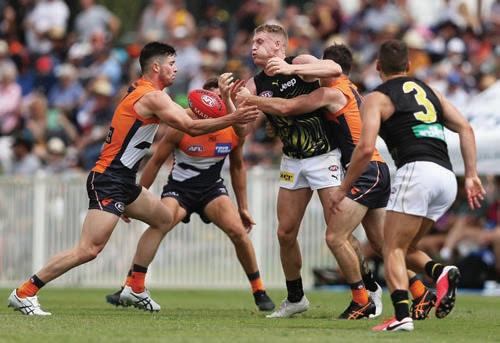
1 Completethetablebelowforthesedifferentstadiumsandevents fromaroundAustralia.Useanallowanceof 1.5 bottlesofwater foreachpersonattendingtheevent.Aftercalculating allanswers,roundtothenearestpositiveinteger.
Q1Hint:Earningsarethe totalamountfromsales, nottheprofit. Venue

Suncorp Stadium, Brisbane
MCG,Melbourne CricketGround
BrisbaneRoarvs PerthGlory 35200
Hawthornvs Fremantle 100007
WACA,WA Cricket Association T20 cricketIndia vsAustralia 34527
SCG,Sydney CricketGround
SydneySwans vsWestern Bulldogs 33386
AdelaideOval AdelaideCrows vsWestCoast Eagles 53445
NIBStadium, Perth Wallabiesvs Argentina 16202
DarwinFootball Stadium Brumbiesvs Reds 4600
ANZStadium, Sydney Broncosvs Cowboys 82758
2 Attendancesareoftenroundedforconvenienceofreporting.Fortheeventsinquestion 1,round eachoftheattendancestothenearestthousand.
3 Averageattendancefigureshelpstockcontrollers predicttheneedsofeventsattheirvenues.
Average = Totalattendance Numberofgames
Calculatetheaverageattendanceforeachofthe followingevents:
a
b
c
d
AFL2019seasonwithatotalattendanceof 7517647 with 198 games.
BigBashLeague2018–19seasonwith 1212596 peopleattending 59 games.
Japanesebaseball2019seasonof 429 gameswitha totalattendanceof 14867071
Majorleaguebaseballwithtotalattendance 68494752 over 2429 games.

4 Listfourfactorsthatcouldcausevariationinattendancefigures.
Usingtechnology
Usethefollowingexampletohelpyouwiththequestionbelow. ForoneMCGcricketevent, 6 bucketsofhotchipsweresoldforevery 10 people.Thefollowing calculationshowshowthestockcontrollerpredictstheamountoffoodrequiredforanevent.
Totalnumberoffooditems = seatingcapacity × numberoffooditems numberofpeople
= 100000 × 6 10
= 60000 bucketsofhotchips
5 Forthefollowingcalculations,you canassumeeachstadiumisfilledto capacity.
a Copythetablebelowintoa spreadsheet.Selecttheshaded cells,rightclick,selectFormat Cells/Number/0d.p./OK
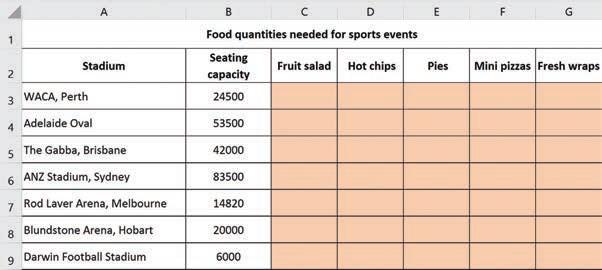
b Insertformulasintotheshadedcellstocalculatethepositiveintegersofservesforeachfooditem inthistable.
Usethesefactstowritetheformulas:
1 in 5 peoplebuyfruitsalad • halfthefansbuyhotchips
3 piesaresoldforevery 2 fans
3 in 8 peoplebuyfreshwraps
2 minipizzasaresoldforevery 5 people
Q5bHint:E3formula
=B3*3/2G3formula =B3*3/8

Cansandchips
Ataschoolfundraisingfair,Mikehasbeengiven $30 tospendon softdrinkandchipsforhimselfandhisfriends.Cansofsoftdrink cost $2 eachandcupsofchipscost $3 each.

Presentareportforthefollowingtasksandensurethatyoushowclearmathematicalworkings, explanationsanddiagramswhereappropriate.
1Preliminarytask
a Findthetotalcostofbuying:
5 cansofsoftdrink i 7 cupsofchips ii
4 cansofsoftdrinkand 3 cupsofchips iii 6 cansofsoftdrinkand 5 cupsofchips iv
b If 6 cupsofchipsand 3 cansarepurchased,findthechangefrom $30
c DeterminethemaximumnumberofcansofsoftdrinkthatMikecanpurchaseif:
4 cupsofchipsarepurchased i 3 cupsofchipsarepurchased ii
2Modellingtask
Formulate TheproblemistofindthemaximumnumberofcansandcupsofchipsthatMikecanpurchasewith themoneyhewasgiven.
a Writedownalltherelevantinformationthatwillhelpsolvethisproblem.
Solve b Chooseatleasttwocombinationsforthenumberofcansandnumberofcupsofchipssothat thetotalcostislessthan $30.Showyourcalculationstoexplainwhyyourcombinationsare affordable.
c Chooseatleasttwodifferentcombinationsforthenumberofcansandchipssothatthetotal costisequalto $30
d Determinepossiblecombinationscostingupto $30 whichwouldmeanthatMike: i maximisesthenumberofcanspurchased. ii maximisesthenumberofcupsofchipspurchased.
Evaluate and verify
e Determinethemaximumnumberofitems(cansand/orcupsofchips)thatcanbepurchased for $30 orless:
i ifatleast 5 cupsofchipsmustbepurchased. ii iftherearenorestrictions.Describethecombinationsofcansandcupsthatcouldbe boughttogetthismaximumnumber.
Communicate f Summariseyourresultsanddescribeanykeyfindings.
3Extensionquestion
g IfMikehad $37,investigatethemaximumnumberofitems(cansofsoftdrinkand/orcupsof chips)thatcouldbepurchasedifatleast 6 cupsofchipsmustbeincluded.
Making100dollars
Keytechnology:Spreadsheets
Youcanimaginethattherearemanywaysinwhichyoucanmake $100 from $10 and $20 notes. Assumingyouhaveenoughofeachtype,youcouldmake $100 usingfive $20 andno $10 notesor perhapsthree $20 notesandfour $10 notes,forexample.
1Gettingstarted
a Withoutusingoneofthecombinationsmentionedintheintroduction,listthreedifferentpossible combinationsof $20 and $10 notesthatmakeupatotalof $100
b Canyoufindawaytomakeup $100 bycombining $10 and $20 notessothatthereisatotalof sevennotesbeingused?Ifso,describeit.
c Canyoufindawaytomakeup $100 bycombining $10 and $20 notessothatthereisatotalof elevennotesbeingused?Explainyouranswer.
2Usingtechnology
Wewilluseaspreadsheettoexplorethenumberofwaysyoucanchoose $10 and $20 notesto form $100
a Createthefollowingspreadsheetusingthegiveninformation.
• Thenumberof $20 notescanvaryandisincellB3.
• TheinformationincellA7 createsthenumberof $10 notesselected.
• TheinformationincellB6 createsthetotalvalueofthe $10 and $20 notesselected.
• TheinformationincellC6 createsthetotalnumberofnotesselected.

b FilldownatcellsA7,B6 andC6.Filldownuntilten $10 notesareused.Notethatthe $ signincells B6 andC6 ensuresthatthenumberof $20 notesincellB3 isusedforeverycalculation.
Technology and computational thinking
c Seeifyourspreadsheetisworkingproperlybyalteringthenumberof $20 notesincellB3.Allthe valuesshouldchangewhenthiscellisupdated.
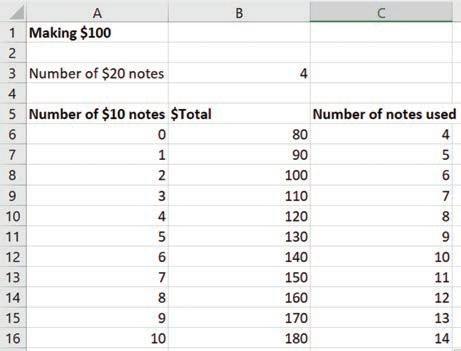
d Choosetwo $20 notesbychangingthecellB3 toequal 2.Readoffyourspreadsheettoanswer thefollowing.
Howmany $10 notesarerequiredtomakethetotalof $100? i Howmanynotesareselectedintotalifyoumake $100? ii Describewhathappensifthenumberof $20 notesincellB3ischangedto 7 iii
3Applyinganalgorithm
a Useyourspreadsheettosystematicallyrunthroughandcountallthewaysyoucanmake $100 using $10 and $20 notes.Applythesesteps.
• Step 1:Choosethesmallestnumberof $20 notespossibleandenterthisnumberintocellB3
• Step 2:Readoffthenumberof $10 notesneededtomake $100
• Step 3:Increasethenumberof $20 usedbyoneandrepeatStep 2
• Step 4:Continueincreasingthenumberof $20 notesuseduntilyoureachamaximum possiblenumber.
b Describethecombinationofnoteswhereatotalof $100 isachievedbutthereareeightnotes intotal.
c Isitpossibletoachieveatotalof $100 usingonlysixnotesintotal?Ifso,describehow.
d Howmanywayswerethereofforming $100 from $10 and $20 notes?
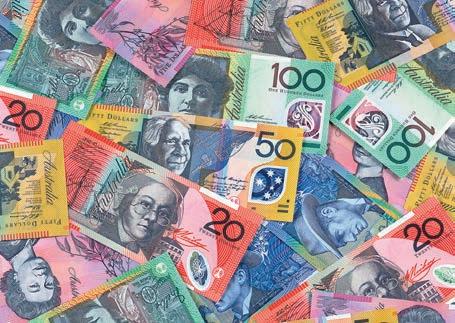
1 Completethesemagicsquares.Eachrow,columnandmaindiagonaladduptothesamemagic total.
2 Decidewherebracketsshouldgotomakeeachstatementtrue.
5 + 2 × 3 = 21 a 16−8 ÷ 10−6 = 2 b
4 + 2 × 7−1 × 3 = 43 c
3 Eachsideonamagictriangleaddsuptothesamenumber,asshowninthisexamplewithasum of 12 oneachside.
a Placethedigits 1 to 6 inamagictrianglewiththreedigitsalongeachsidesothateachside addsuptothegivennumber.
9 i 10 ii
b Placethedigits 1 to 9 inamagictrianglewithfourdigitsalongeachsidesothateachsideadds uptothegivennumber.
20 i 23 ii
Puzzles and games
4 Sudokuisapopularlogicnumberpuzzlemadeupofa 9 by 9 square,whereeachcolumnandrow canusethedigits 1, 2, 3, 4, 5, 6, 7, 8 and 9 onlyonce.Also,eachdigitistobeusedonlyoncein each 3 by 3 square.Solvethesepuzzles.
5 Thesumalongeachlineis 15.Canyouplaceeachofthedigits 1,
and
tomake thiswork?
6 Findallthemissingdigitsintheseproducts.
7 Youdecidetostartcountingbackwardsby 7,startingatthesenumbers.Ifyoustopjustbefore passingzero,whatisyourfinalnumber?
205 a 22314 b
Place value

The place value of 3 in 1327 is 300
The place value of 4 in 7143 is 40

2 × 100 + 7 × 10 + 3 × 1 is the expanded form of 273. This can also be written with indices as 2 × 102 + 7 × 101 + 3 × 1


Addition and subtraction


Positive integers
Mental strategies
172 + 216 = 300 + 80 + 8 = 388 98 19 = 98 20 + 1 = 79

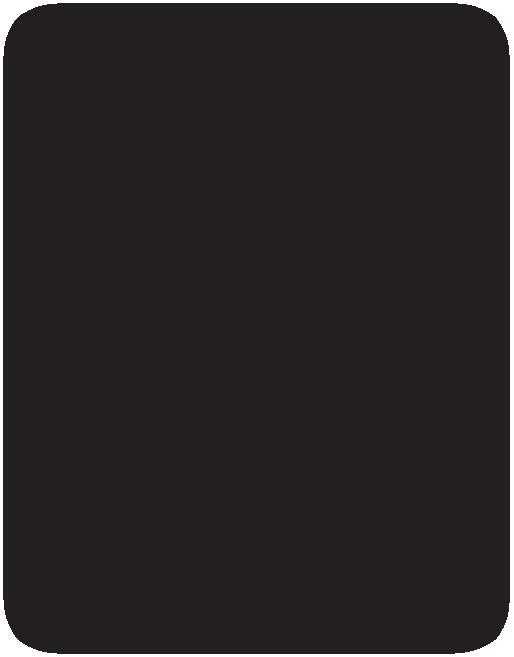
Order of operations
Brackets first, then × and ÷, then + and from left to right. 2 × (7 + 1) = 2 × 8 = 16

Estimation

955 to the nearest 10 is 960
950 to the nearest 100 is 1000

Leading digit approximation
39 × 326 ≈ 40 × 300 = 12 000

Mental strategies

7 × 31 = 7 × 30 + 7 × 1 = 217 5 × 14 = 10 × 7 = 70
64 ÷ 8 = 32 ÷ 4 = 16 ÷ 2 = 8 156 ÷ 4 = 160 ÷ 4 4 ÷ 4 = 40 1 = 39
Multiplication and division 29 × 13 87 290 377 6 8 3 2025 with 1 remainder Larger numbers 2

Multiplying by 10, 100, …
38 × 100 = 3800

38 × 700 = 38 × 7 × 100 = 26 600
Chapterchecklist
AversionofthischecklistthatyoucanprintoutandcompletecanbedownloadedfromyourInteractiveTextbook.
1A 1
1A 2
1A 3
1B 4
1C 5
Icanwritedowntheplacevalueofdigitswithinanumber. e.g.Writetheplacevalueofthedigit 4 inthenumber 1043
Icanarrangepositiveintegersfromsmallesttolargest.
e.g.Arrangethesenumbersfromsmallesttolargest: 29, 36, 18, 132, 1001, 99, 592, 123, 952.
Icanwritepositiveintegersinexpandedformwithandwithoutindexnotation. e.g.Write 517 inexpandedform.Rewrite 517 inexpandedformwithindexnotation.
Icanusementaladditionandsubtractiontechniqueseffectively. e.g.Mentallyfind 132 + 156 (withpartitioning)and 56−18 (withcompensating).
Icanusetheadditionalgorithm.
e.g.Givetheresultforthissum 439 + 172
1C 6
Icanusethesubtractionalgorithm.
e.g.Givetheresultforthisdifference 526 −138
1D 7
1D 8
1E 9
1E 10
1F 11
1F 12
Icanusementalmultiplicationtechniqueseffectively. e.g.Mentallyfind 4 × 19
Icanusethemultiplicationalgorithmwhenonenumberislessthanten. e.g.Givetheresultof 197 × 7.
Icanmultiplybypowersoftenbyaddingzerostotheendofanumber. e.g.Givetheresultof 37 × 100
Icanmultiplylargernumbersusingthemultiplicationalgorithm. e.g.Find 87 × 13
Icanusementalstrategiestodividepositiveintegers. e.g.Mentallyfind 93 ÷ 3.
Icanusetheshortdivisionalgorithm. e.g.Useshortdivisiontofindthequotientandremainder. 7 ) 195
Giveyouranswerusingmixednumeral.
1G 13
1G 14
1H 15
1H 16
Icanroundpositiveintegerstoapoweroften.
e.g.Round 4142 tothenearest 100.
Icanestimateanswersusingleadingdigitapproximation.
e.g.Estimate 95 × 326 byroundingeachnumbertotheleadingdigit.
Icanuseorderofoperations.
e.g.Findthevalueof 18−2 × (4 + 6) ÷ 5
Icanuseorderofoperationsinwordedproblems.
e.g.Findtheresultif 6 ismultipliedbythesumof 2 and 78
Short-answerquestions
1 1A Arrangethesenumbersfromsmallesttolargest.
317, 713, 731, 371, 173, 137 a 1001, 1010, 199, 999, 1000, 1900, 1090 b 2
1B Useamentalstrategytofindthesesumsanddifferences.
4 1C Findthesesumsanddifferences.
5 1D Useamentalstrategytoworkoutthefollowing.
÷
6 1E/F Showyourworkingtofindeachanswer.
7 1E/F Findthemissingdigitsintheseproblems.
8 1G Roundthesenumbersasindicated.
72 (nearest 10) a
3268 (nearest 100) b 951 (nearest 100) c
9 1G Useleadingdigitapproximationtoestimatetheanswerstotheseproblems.
10 1H Useorderofoperationstofindtheanswerstotheseproblems.
Multiple-choicequestions
1 1A Theplacevalueof 7 in 2713 is:
2 1A Theexpandedformof 372 is
3 1B/D/F Whichofthefollowingis not true?
2 + 3 = 3 + 2 A 2 × 3 = 3 × 2
4 1C Thesumof 198 and 103 is:
5 1C Thedifferencebetween 126 and 29 is:
6 1D/E Theproductof 7 and 21 is:
7 1F Themissingdigitinthisdivision 3
8 1F Theremainderwhen 317 isdividedby 9 is:
9 1G 458 roundedtothenearest 100 is:
1H Theanswerto 4 × 3−26 ÷ 13 is:
Extended-responsequestion
1 Acitytowerconstructionuses 450 tonnesofconcrete.Theconcreteistruckedfromafactorythat is 2 kilometresfromtheconstructionsite.Eachconcretemixercancarry 5 tonnesofconcrete. Theconcretecosts $350 pertruckloadforthefirst 10 loadsand $300 perloadafterthat.
a Howmanyloadsofconcreteareneeded?
b Findthetotaldistancetravelledbytheconcretemixerstodeliverallloads.Theyneedtoreturn tothefactoryaftereachload.
c Findthetotalcostofconcreteneededforthetowerconstruction.
d Ifthepriceofconcreteisalways $350 regardlessofthenumberofloads,howmuchmore woulditcostfortheconcrete?
2 OnenightRickyandhisbrotherMickydecidetohavesomefunattheirfather’ssweetshop. Intheshoptheycollected 3 tinsof 25 jellybeans, 4 packetsof 32 chocbuds, 5 boxesof 10 smartiesand 12 packetsof 5 liquoricesticks.
a Findthetotalnumberofsweets.
b Findthedifferencebetweenthenumberofchocbudsandthenumberofsmarties.
c RickyandMickydecidetodivideeachtypeofsweetintogroupsof 7 andtheneatany remainder.Whichtypeofsweetwilltheyeatthemostofandhowmany?
2 Numberproperties andpatterns

Essentialmathematics:whyunderstandingnumber propertiesandpatternsisimportant
Numberpropertiesandpatternsarewidelyapplied,includingincryptography,engineering, finance,gamedevelopment,musictheory,science,sportsanalyticsandstatistics.
Asportscoachwith 24 soccerballsand 60 conesusestheHighestCommonFactor(12)tocreate 12 equalsetsoftwoballsandfivecones.Iftwobusesarriveevery 15 and 20 minutes,theLowest CommonMultiple(60)tellsustheywillarrivetogether,every 60 minutes.
Squaresandsquarerootsarecomputedwhenapplyingcircleandtriangleproperties,includingby engineers,architects,builders,surveyors,graphicdesignersandanimators.
Verylargeprimenumbersareusedincryptographytoprotectinformationtransmittedoverthe internet.Barcodesystemscanuseprimenumberstoencodeinformation.
Numberpatternrulesaredevelopedbyaccountantsandfinancialadviserstoforecastfuture annualincreasinginvestmentvaluesandpropertyprices.

Inthischapter
2AFactorsandmultiples (Consolidating)
2BHighestcommonfactorandlowest commonmultiple (Consolidating)
2CDivisibility
2DPrimenumbersandcompositenumbers
2EIndexform
2FPrimefactors
2GSquaresandsquareroots
2HNumberpatterns (Consolidating)
2IPatternswithshapesandnumbers
2JTablesandrules
2KTheCartesianplaneandgraphs
AustralianCurriculum9.0
NUMBER
Describetherelationshipbetweenperfectsquare numbersandsquareroots,andusesquaresof numbersandsquarerootsofperfectsquare numberstosolveproblems(AC9M7N01)
Representnaturalnumbersasproductsofpowers ofprimenumbersusingexponentnotation (AC9M7N02)
ALGEBRA
Describerelationshipsbetweenvariables representedingraphsoffunctionsfromauthentic data(AC9M7A04)
Generatetablesofvaluesfromvisuallygrowing patternsortheruleofafunction;describeand plottheserelationshipsontheCartesianplane (AC9M7A05)
©ACARA
Onlineresources
Ahostofadditionalonlineresourcesareincluded aspartofyourInteractiveTextbook,including HOTmathscontent,videodemonstrationsofall workedexamples,auto-markedquizzesand muchmore.
1 Find:
10 × 10 × 10 × 10 × 10 × 10 c
2 Find: 20 ÷ 5 a
Warm-up
÷
20 ÷ 1 c 20 ÷ 20 d allthenumbersthatdivideinto 20 withnoremainder e
3 Writethequotientandremainderforthesedivisions.
4 Find: 3 morethan 7 a thedifferencebetween 20 and 16 b thesumof 12 and 7 c 6 multipliedby 4 d theproductof 2 and 9 e 30 dividedby 6 f
5 Listallthefactorsof 24 inascendingorder.
6 Replace with < or > 3 issmallerthan 7 sowewrite 3 7 a 12 isbiggerthan 5 sowewrite 12 5 b
7a Listthenextthreeevennumbers: 2, 4, , , b Listthenextthreeoddnumbers: 1, 3, , ,
8 Find:
9 Copyandcompletethefollowing.
10 Statethemissingnumberinthesefactortrees.
11 Find 33 ÷ 3. a Is 33 divisibleby 3? b Find 32 ÷ 3 c Is 32 divisibleby 3? d
12 Usetheorderofoperationstofindtheanswer. 2 × 10 + 3 a 6 + 3 × 10 b 20 ÷ 2 + 12 ÷ 4 c 3 × (4 × 2−6) d
13 Choosethecorrectsetofnumbers(A to D)thatmatchesthedescription(a to d).
Factorsof 10 a 4, 8, 12, 16, A
Multiplesof 4 b 1, 2, 5, 10 B
Factorsof 16 c 5, 10, 15, 20, C
Multiplesof 5 d 1, 2, 4, 8, 16 D
14 Find: theareaofthissquare a thesidelengthofthissquare b 4 cm 4 cm Area = 36 cm2
2A 2A Factorsandmultiples CONSOLIDATING
Learningintentions
• Tounderstandthatanumberhasin nitelymanymultiples.
• Tobeableto ndfactorsofanumber.
• Tobeableto ndmultiplesofanumber.
Keyvocabulary: factor,multiple,ascending,remainder
Numberpatternscanbequiteuseful whendescribinggroupsofobjectsor relationshipsbetweenquantities.We startthischapterlookingatfactorsand multiples.
Onedozendoughnutsaregenerally packedintobagsorboxeswith 3 rowsof 4 doughnutseach.Since 3 × 4 = 12,we cansaythat 3 and 4 are factors of 12.
Purchasing‘multiple’packsofone dozendoughnutscouldresultinbuying 24, 36, 48 or 60 doughnuts,dependingon thenumberofpacks.Thesenumbersare knownas multiples of 12
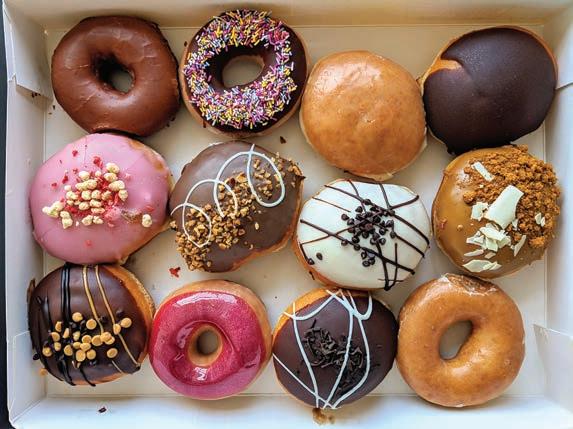
Factorsareusefulforsplittingupobjectsevenly,suchasaboxof doughnuts.
Lessonstarter:Usingfactorstoplanaparty
Shaynawantseveryoneatherparty(includingherself)tohavethesamenumberofdoughnuts.
Dad bought 3 boxes of 12 doughnuts for my party!
I hope no-one else comes. That way, we get a whole box each!
If four more people come, can we still share the doughnuts equally?
• What‘partysizes’arepossiblesoeveryonehasthesamenumberofdoughnuts?Forexample, apartysizeof 12 meansthatShaynainvites 11 friendsandeveryonegets 3 doughnutseach (12 groupsof 3 equals 36).
• Listthefactorsof 36 inascending(increasing)order.(Youcouldarrange 36 countersintovariousgroups ofequalsizetofindallthepossiblefactors.)
• IfShaynawantsjustonedoughnut,thenstillwantstheremainingfriendsatthepartytohaveanequal number,howmanyfriendsshouldsheinvite?
Keyideas
Factors ofanumberdivideexactlyintothatnumber.
Forexample: 20 ÷ 4 = 5 exactly,so 4 isafactorof 20
• Factorsof 20 listedinpairs: 1 × 20 = 20, 2 × 10 = 20, 4 × 5 = 20
• Factorsof 20 in ascending order: 1, 2, 4, 5, 10, 20
1 is the smallest factor of any number.
The largest factor of any number is the number itself.
Multiples ofanumberaremadewhenthatnumberismultipliedbywholenumbers.
• Forexample,themultiplesof 5 inascendingorderare 5, 10, 15, 20, ...
• Anotherwaytofindmultiplesof 5 istostartwith 5 andkeepadding 5
+ 5 + 5 + 5
5,10, 15, 20, ...
The smallest multiple of a number is the number itself.
Multiples just keep on getting bigger.
• A remainder isanumberleftoverfromdivision.
Exercise2A
Und er stand ing 1–4 4
1 Thinkaboutarranging 24 countersintoarectanglewith 2 rowsof 12 counters.
a
b
Copyandcompletethefactorpairsforthisrectangle.
12 × = 24 or × 12 = 24
Usingall 24 counterseachtime,thinkaboutthreedifferent-sizedrectanglesandwritedownafactor pairforeach.
2 Copyandcomplete:
a 1 × = 5
1 × = 12, 2 × = 12, 3 × = 12
Thefactorsof 12 are 1, , , , , 12
Thefactorsof 5 are , b
1 × = 30, 2 × = 30, 3 × = 30, 5 × = 30
Thefactorsof 30 are , , , , ,
3 Copyandcomplete:
Thefirstsixmultiplesof 5 are 5, , 15, , 25, a
Thefirstsixmultiplesof 10 are 10, , 30, , , b
Thefirstsixmultiplesof 7 are 7, , , 28, , 42 c

Q2Hint:Listthe factorsinascending order(fromsmallest tolargest).

Q3Hint:Tomake multiplesof 5,start with 5 andkeep adding 5.
4 Copyandcomplete:
b
7 × 6 = 42 so 7 and 6 are of 42 a Tomakemultiplesof 6,multiply 6 bywholenumbers.Forexample:
1 × 6 = 6, × 6 = 12, × 6 = 18, × 6 = 24
Thefirstfivemultiplesof 6 are 6, , 18, , c
Ifyoustartwith 6 andthenkeepadding 6,youwillproducealistof of 6 d Fluency
Example1Findingfactors
Findthecompletesetoffactorsforeachofthesenumbers.
15 a 40 b
a Factorsof 15 are 1, 3, 5, 15 1 × 15 = 15, 3 × 5 = 15
b Factorsof 40 are: 1, 2, 4, 5, 8, 10, 20, 40. 1 × 40 =
,
,
Therearenoothernumbersthatdivideinto 40 withzeroremainder.
Q5Hint:Listthe factorsinascending order(smallestto largest). 10 a 24 b 17 c
Example2Listingmultiples
Writedownthefirstsixmultiplesforeachofthesenumbers.
11 a 35 b
Solution
a 11, 22, 33, 44, 55, 66
b 35, 70, 105, 140, 175, 210
Explanation
Thefirstmultipleisalwaysthegivennumber. Addonthegivennumbertofindthenextmultiple. Repeatthisprocesstogetmoremultiples.
Startat 35 (thegivennumber)andrepeatedlyadd 35 to continueproducingmultiples.

Nowyoutry
Writedownthefirstsixmultiplesforeachofthesenumbers. 9 a 21 b
6 Writedownthefirstsixmultiplesforeachofthefollowingnumbers.

Q6Hint:Listthemultiplesin ascendingorder.
7 Fillinthegapstocompletethesetoffactorsforeachofthefollowingnumbers. 181, 2, , 6, 9,
Example3Identifyingincorrectmultiples
Whichnumberisthe wrong multipleinthesequence 7, 14, 20, 28, 35?Writethecorrectsequence.
Solution Explanation 20 isincorrect.
7, 14, 21, 28, 35 14 + 7 = 21 or 3 × 7 = 21 Amultipleof 7 mustbeawholenumbertimes 7
Nowyoutry
Whichnumberisthe wrong multipleinthesequence 8, 16, 24, 34, 40, 48?Writethecorrectsequence.
8 Findthe wrong multipleineachofthefollowing.Writethecorrectsequence.
Problem-solving and reasoning
Example4Findingfactorpairs
Express 96 asaproductoftwofactors,bothofwhicharegreaterthan 6
Solution
Explanation 96 = 8 × 12 Divide 96 bynumbersgreaterthan 6 tofindalargefactor.
Nowyoutry
Express 72 asaproductoftwofactors,bothofwhicharegreaterthan 7
9 Expresseachofthefollowingnumbersasaproductoftwofactors, bothofwhicharegreaterthan 4

Q9Hint:Forsome numbers,thetwo factorswillbethe samenumber.
10 ZaneandMattarebothkeenrunners.Zanetakes 4 minutesto jogaroundarunningtrackandMatttakes 5 minutes.Theystart togetheratthesametimeandjog 6 lapsfortraining.
a Copyandcomplete: WhenZanejogged 6 lapsaroundthetrack,hecrossed thestart/finishlineafter 4, 8, , , and minutes.
Q10Hint:Useadiagramshowing 30 minutes: 012. . .30
ii
i Mattcrossedthestart/finishlineafter , ,
, and minutes.
b Howmanylapshadeachboyjoggedwhentheycrossedthelinetogether?
c Forhowlonghadtheboysjoggedbeforetheycrossedthelinetogether?

11 Ansonispreparingforhistwelfth birthdayparty.Hehasinvited 5 friendsandismakingeachofthem a‘lollybag’totakehomeafterthe party.Tobefair,hewantstomake surethateachfriendhasthesame numberoflollies.Ansonhasatotal of 67 lolliestoshareamongthelolly bags.
a
b

HowmanylolliesdoesAnsonput ineachofhisfriends’lollybags?
HowmanylolliesdoesAnson haveleftovertoeathimself?
Ansonthendecidesthathewantsa lollybagforhimselfalso.
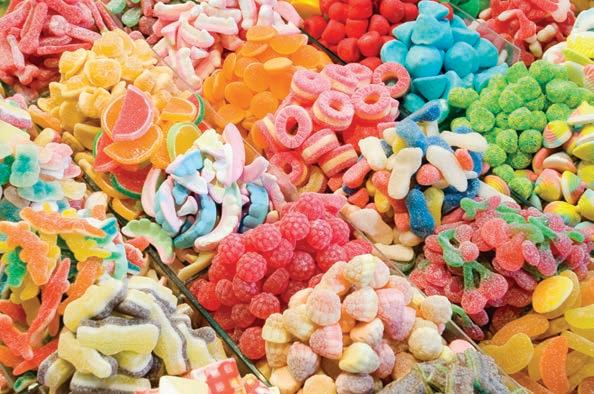
c With 6 lollybags,arethereanylolliesleftover? d
Howmanylollieswillnowgointoeachofthe 6 lollybags?
12 Joannaisavet.Shewantstobuyseveralpensforseparatingsickanimals.Therearesquareorrectangular pensavailable,allwithsidesthatare 1, 2, 3 or 4 metreslong.

a Joannawantstobuyatleasttwoequal-sizedpenstocoveranareaof 12 m2.Twopossibilitiesare shownbelow.FindtheotherfourwaysJoannacouldbuypens.
Option1:Buy 3 squarepens.
Eachpenhas:L = 2 m, W = 2 m,A = 4 m2
Totalarea = 3 × 4 = 12 m2
Option2:Buy 2 rectangularpens.
Eachpenhas:L = 2 m,W = 3 m,A = 6 m2
Totalarea = 2 × 6 = 12 m2

Q12aHint:Usegridpaper anddrawthepens.Note that 2 m × 3 mpensare thesameas 3 m × 2 m pens,sodon’tcountthem twice.
b Workoutthenumberofequal-sized square pensandtheirsizessoallthesepensjoinsidebyside tocoveranareaof:
32 m2 i 54 m2 ii
c Workoutthenumberofequal-sized rectangular pensandtheirsizessoallthesepensjoinsideby sidetocoveranareaof:
32 m2 i 54 m2 ii
d Azoovetwantstobuyseverallarger,equal-sizedpenstocover 150 m2.Findallthepossibilitieswith whole-numbersidesfrom 2 to 25 metres.
CONSOLIDATING
2B 2B Highestcommonfactorandlowest commonmultiple
Learningintentions
• Tobeableto ndthehighestcommonfactoroftwonumbers.
• Tobeableto ndthelowestcommonmultipleoftwonumbers.
Keyvocabulary: factor,multiple,highestcommonfactor(HCF),lowestcommonmultiple(LCM)
Inthelastsection,weworkedwithfactorsandmultiples.Inthissection,welookatcommonfactorsor multiplesthataresharedbytwonumbers.
Itisoftenusefultobeabletofindthehighestcommonfactor(HCF)orlowestcommonmultiple(LCM) andtheseareimportantinhigherlevelsofmathematics.
Lessonstarter:Findingspecialnumbers
My factors are 1, 2, 4, 8, 16.
My factors are 1, 2, 3, 4, 6, 8, 12, 24.
Wesharesomecommonfactors.Whatarethey?
Whichisthehighest(biggest)commonfactorweshare?
My multiples are 10, 20, 30...
Wesharesomecommonmultiples.Whatarethey?
Whatisthelowest(smallest)multipleweshare?
My multiples are 6, 12, 18...
Keyideas
HCF standsfor highestcommonfactor.Itisthelargest factor sharedbythetwoormore numbersbeingconsidered.
• Forexample:FindtheHCFof 24 and 40
Factorsof 24 are 1 , 2 , 3, 4 , 6, 8 , 12 and 24
Factorsof 40 are 1 , 2 , 4 , 5, 8 , 10, 20 and 40
Wecanseethatthehighestcommonfactoris 8 sowewriteHCF = 8
LCM standsfor lowestcommonmultiple.Itisthesmallest multiple thattwoormorenumbers divideintoevenly.
• Forexample:FindtheLCMof 20 and 12
Multiplesof 20 are 20, 40, 60 , 80, 100, 120, 140,
Multiplesof 12 are 12, 24, 36, 48, 60 , 72, 84, 96,
Wecanseethatthelowestcommonmultipleis 60 sowewriteLCM = 60
Exercise2B
1 Copyandcompletethefollowing.
HCFstandsfor a
b
TofindtheHCF,wefirstlistallthe ofeachnumber.
LCMstandsfor c
d
TofindtheLCM,welist ofeachnumber.
2 Thefactorsof 12 are 1, 2, 3, 4, 6, 12.Thefactorsof 16 are 1, 2, 4, 8, 16
Whatarethecommonfactorsof 12 and 16? a
Whatisthehighestcommonfactorof 12 and 16? b
3 Thefirst 10 multiplesof 8 are 8, 16, 24, 32, 40, 48, 56, 64, 72, 80
Thefirst 10 multiplesof 6 are 6, 12, 18, 24, 30, 36, 42, 48, 54, 60.
Whataretwocommonmultiplesof 8 and 6? a
Whatisthelowestcommonmultipleof 8 and 6? b
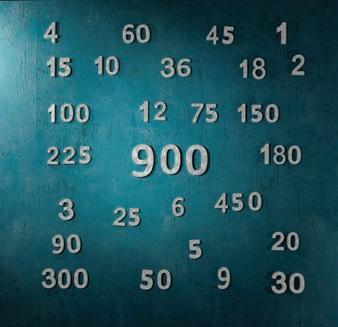

Q1Hint:Lookbackatthe Keyideas

Q2Hint:Commonfactors: numbersinbothlists.
Fluency
Example5Findingthehighestcommonfactor(HCF)
Findthehighestcommonfactor(HCF)of 36 and 48
Solution
Factorsof 36 are:
1 ,
2 , 3 , 4 , 6 , 9, 12 , 18 and 36
Factorsof 48 are:
1 , 2 , 3 , 4 , 6 , 8, 12 , 16, 24 and 48
HCF = 12
Nowyoutry
Explanation
Findthefactorsof 36 (1 × 36 = 36, 2 × 18 = 36, etc.)andlisttheminorder.
Findthefactorsof 48 (1 × 48 = 48, 2 × 24 = 48,etc.)andlisttheminorder.
Circlecommon(shared)factors.Pickthe HCF (highestsharedfactor).
Findthehighestcommonfactor(HCF)of 24 and 32
4 FindtheHCFofthefollowingnumbers.
4 and 5 a 8 and 13 b 2 and 12 c 3 and 15 d 16 and 20 e 15 and 60 f 20, 40 and 50 g 12, 15 and 30 h 5, 7 and 11 i
Example6Findingthelowestcommonmultiple(LCM)
Findthelowestcommonmultiple(LCM)of 6 and 10
Solution
6, 12, 18, 24, 30 , 36, …
10, 20, 30 , 40, LCM = 30
Nowyoutry

Q4Hint:Firstlistthefactorsof eachnumber.
Explanation
Listmultiplesofeachnumber.
Circlethefirstcommon(shared)multiple. Thisisthe LCM
Findthelowestcommonmultiple(LCM)of 8 and 12
5 FindtheLCMofthefollowingnumbers.
4 and 5 a 3 and 7 b 5 and 6 c 8 and 10 d 4 and 6 e 5 and 10 f
2, 3 and 5 g 3, 4 and 5 h 2, 3 and 7 i

Q5Hint:Firstlistsomemultiples ofeachnumber.
Problem-solving and reasoning
6 Atrail(line)ofredantsrunsalongsideatrailofblackants. Assumetherearenogapsbetweenantsinatrail.
Q6Hint:Therecanonlybe wholeantsineachtrail!

a Howlongwouldthattrailbe?
Whatisthesmallestnumberofredantsandthesmallestnumberofblackantsthatwould makethetrailsequalinlength?
b
7 Alineoflargespoonsisnexttoalineofsmallspoons.


Whatisthesmallestnumberofeachtypeofspoonthatwouldmakethelinesequalinlength? a Howlongwouldthatlinebe? b Theanswertopart b iscalledthe of 14 and 21 c
8 Alineofpinkthongsisnexttoalineofgreenthongs.
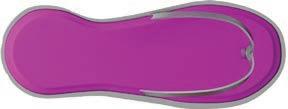
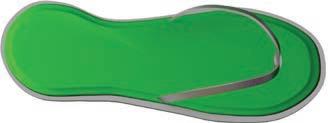

Q8Hint:RememberthatLCM meanslowestcommonmultiple.
Supposethatthetwolinesofthongsarethesamelength.Howlongcouldeachlinebe?Findthree possibleanswers. a Whichoftheanswersinpart a istheLCMof 20 and 25? b
9 Wendyisafloristwhoismakingupsmallbunchesofrosesforsale.Shehas 36 redroses, 42 pinkroses and 30 creamroses. Wendyusesonlyonecolourforeachbunch.Shewantstousealltheroses. Eachbunchmusthavethesametotalnumberofroses.
WhatisthelargestnumberofrosesWendycanputineachbunch? a Theanswertopart a iscalledthe of 36, 42 and 30 b Howmanybunchesofeachcolourcanshemake? c
10 GiventhattheHCFofapairofdifferentnumbersis 8,findthe twonumbers:
Q10Hint:Remember,HCFmeans ifbothnumbersarelessthan 20 a whenonenumberisinthe 20sandtheotherinthe 30s b

Cyclinglaps
11 Threegirlsareridingtheirbikesaroundacirculartrack.Theyallstarttogether.
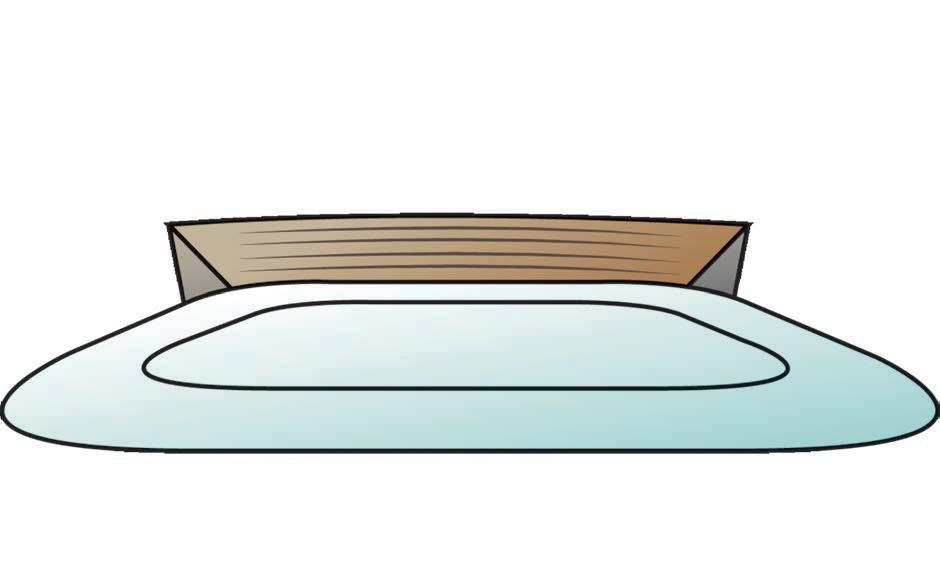
I take 6 minutes to cycle a lap.
I take 4 minutes to cycle a lap.
I take 3 minutes to cycle a lap.
Lillitakes 3 minutestocycleeachlap.(Thatis,shecrossesthestartinglineevery 3 minutes.) Aliyahtakes 4 minutesforeachlapandCiaratakes 6 minutes.
Thisbargraphshowsthetimeeachgirltakesforthefirsttwolaps.
a Ongridpaper,copythegraphandextendittoshowthenumberoflapseachgirlcompletesin 24 minutes.(Drawarectangleforeachlapcycled.)
b Whendoallthreegirlsfirstcrossthestartinglinetogether?(Giveyouranswerasthenumberof minutesafterthestart.)
c Howmanyfulllapshaseachgirlcompletedafter 24 minutes?(Countwholelapsonly.)
d Supposethateachgirlrides 15 laps.HowmanyminutesafterLilliwill: Aliyahfinish? i Ciarafinish? ii
Ciara Aliyah
Lilli
Ciara Aliyah
2C Divisibility
Learningintentions
• Tounderstandthattestscanbeusedtocheckifanumberisdivisiblebyanothernumberwithoutactuallydividing.
• Tobeabletotestfordivisibilityby 2, 3, 4, 5, 6, 8, 9 and 10
Keyvocabulary: factor,divisible,remainder,divisibilitytest
Itisoftenusefultoknowwhetheranumberisexactlydivisiblebyanothernumber.Forexample, 20 is divisibleby 2 because 20 ÷ 2 = 10 withnoremainder.However, 20 isnotdivisibleby 3 because 20 ÷ 3 = 6 withremainder 2.
Therearesimpledivisibilitytestsforeachofthesingle-digitnumbers,withtheexceptionof 7
Lessonstarter:Exploringremainders
Workwithapartnertosortthesedivisionsintotwogroups:
• Divisionswithnoremainder
• Divisionswitharemainder
Keyideas
Divisibilitytests arewaystoworkoutwhetherawholenumberisdivisiblebyanotherwhole number,withoutactuallydoingthedivision. Allnumbersaredivisibleby 1
4


or
Exercise2C
Und er stand ing
1 Writethemissingwordsornumbers.
Wesaythat 24 is by 3 because 24 ÷ 3 = 8 withno a Evennumbersarealldivisibleby b Evennumbersendin , , , or c 432 is by 3 becausethesumofthedigits is + + = and isdivisibleby 3 d 432 isanumberdivisiblebyboth 2 and 3 soitisalso divisibleby e
2 WhoamI?Matcheachcorrectdescription(A to C)toitsclue(a to c). Thesumofmydigitsisdivisibleby 3 a Iamdivisibleby 2 A Iamanevennumber. b Iamdivisibleby 3 B Iamevenandthesumofmydigitsis divisibleby 3 c Iamdivisibleby 6 C
3 Writethemissingwordsornumbers.

Q1Hint:Lookbackatthe Keyideas
Anumberthatendsin 0 isdivisiblebyboth and ,aswellasby 2 a Anumberthatendsin 5 isdivisibleby b Thelasttwodigitsof 316 formthenumber ,and isdivisibleby 4,so 316 isalsodivisible by c Thelastthreedigitsof 5328 formthenumber ,and isdivisibleby 8,so 5328 isalsodivisible by d
4 Writethemissingwordsornumbers.
In 2583,thesumofthedigitsis + + + = a 2583 is by 3 becausethesumofitsdigits, ,isdivisibleby b 2583 isalso by 9 becausethesumofitsdigits, ,isdivisibleby c 2583 isnotdivisibleby 6 becauseitisan number. d
Example7Usingdivisibilitytestsfor 2, 3, 6 and 8
Whichofthenumbers 148, 63, 462, 6387, 7168 aredivisibleby: 2? a 3? b 6? c 8? d
SolutionExplanation
a 148, 462, 7168 Onlyevennumbersaredivisibleby 2.Thenumbers 63 and 6387 areodd.
b 63, 462, 6387 Divisibleby 3 whenthesumofdigitsisdivisibleby 3 For 148: 1 + 4 + 8 = 13 but 13 ÷ 3 = 4 withrem. 1 ✘ For 63: 6 + 3 = 9 and 9 ÷ 3 = 3 ✔ Inasimilarway,test 462 ✔ 6387 ✔ and 7168 ✘
c 462 Divisibleby 6 whenevenandthesumofthedigitsisdivisibleby 3 4 + 6 + 2 = 12 and 12 ÷ 3 = 4 ✔
d 7168 Divisibleby 8 whenthenumberformedfromlast 3 digitsisdivisibleby 8 168 ÷ 8 = 21 ✔
5
Nowyoutry
Whichofthenumbers 37, 126, 216,and 13914 aredivisibleby: 2? a 3? b 6? c 8? d
a
Whichofthesenumbersaredivisibleby 2?
3, 6, 13, 14, 8, 17, 21, 54, 22, 34, 33, 50, 18, 35, 46

c
d
Whichofthesenumbersaredivisibleby 3?
b Whichofthesenumbersaredivisibleby 6?
12, 14, 18, 20, 22, 30, 27, 23, 54, 50, 36, 42, 13, 24, 43
12, 24, 28, 38, 63, 60, 87, 225, 54, 252, 36, 92, 66, 84, 143
Whichofthesenumbersaredivisibleby 8?
35, 168, 7168, 40, 5032, 9338, 248, 7831, 6400, 9568
Q5Hint:
Divisibilitytests:
2: lastdigiteven
3: sumofdigitsis divisibleby 3
6: divisibleby 2 and 3
8: numberformedfrom last 3 digitsisdivisible by 8 orendsin000.
Example8Usingdivisibilitytestsfor 4, 5, 9 and 10
Whichofthenumbers 540, 918, 8775, 3924 aredivisibleby: 10? a 5? b 4? c 9? d
Solution
a 540
b 540, 8775
c 540, 3924
d 540, 918, 3924, 8775
Explanation
Divisibleby 10 whennumberendsin 0
Divisibleby 5 whennumberendsin 0 or 5.
Divisibleby 4 whenlasttwodigitsdivisibleby 4
For 540: 40 ÷ 4 = 10 ✔
For 918: 18 ÷ 4 = 4 rem.2 ✘
Inasimilarway,test 75 ✘ and 24 ✔
Divisibleby 9 whensumofdigitsdivisibleby 9
For 540: 5 + 4 + 0 = 9 and 9 ÷ 9 = 1 ✔
For 918: 9 + 1 + 8 = 18 and 18 ÷ 9 = 2 ✔
Inasimilarway,test 8775 ✔ and 3924 ✔
Nowyoutry
Whichofthenumbers 62, 570, 2112, 5617 aredivisibleby: 10? a 5? b 4? c 9? d
6
Whichofthesenumbersaredivisibleby 5?
35, 52, 125, 13, 15, 100, 113, 112, 32, 515, 408, 730, 105 a
b
c
d
Whichofthesenumbersaredivisibleby 10?
20, 64, 800, 98, 290, 610, 85, 265, 590, 52, 39, 90, 160
Whichofthesenumbersaredivisibleby 4?
16, 32, 220, 10, 12, 28, 213, 432, 72, 316, 424, 1836, 135
Whichofthesenumbersaredivisibleby 9?
27, 432, 456, 88, 99, 387, 63, 55, 720, 85, 253, 2799
Example9Applyingdivisibilitytests

Q6Hint:Divisibilitytests: 5:lastdigit 5 or 0
10:lastdigit 0
4:numberformedfromlast twodigitsisdivisibleby 4 9:sumofdigitsisdivisible by 9
Workoutwhetherthefollowingcalculationsarepossiblewithoutleavingaremainder. 54327 ÷ 3 a 765146 ÷ 8 b
Solution
Explanation
a Digitsum = 21 Yes, 54327 isdivisibleby 3. 5 + 4 + 3 + 2 + 7 = 21 21 isdivisibleby 3.
b 8 18 ) 1466 rem. 2 No, 765146 isnotdivisibleby 8
Nowyoutry
Checkwhetherthenumberformedbythelast threedigitsisdivisibleby 8
Workoutwhetherthefollowingcalculationsarepossiblewithoutleavingaremainder. 4168 ÷ 4 a 3142 ÷ 9 b
7 Workoutwhetherthefollowingcalculationsarepossiblewithoutleavingaremainder.
23562 ÷ 3 a 39245678 ÷ 4 b 1295676 ÷ 9 c 213456 ÷ 8 d 3193457 ÷ 6 e 2000340 ÷ 10 f 51345678 ÷ 5 g 215364 ÷ 6 h 9543 ÷ 6 i 25756 ÷ 2 j 56789 ÷ 9 k 324534565 ÷ 5 l 2345176 ÷ 8 m 329541 ÷ 10 n 225329 ÷ 3 o 356781276 ÷ 9 p 164567 ÷ 8 q 2002002002 ÷ 4 r 8
Copythetable.Carryoutthedivisibilitytestsonthegivennumbers, fillinginthetablewithticksorcrosses.

Q7Hint:Applythe divisibilitytests ratherthandoing theentiredivision.

Q8Hint: ✔ ifdivisible. ✘ ifnotdivisible.
by 9
by 10
9
Problem-solving and reasoning
Giveareasonwhy:
8631 isnotdivisibleby 2 a 31313 isnotdivisibleby 3 b
426 isnotdivisibleby 4 c 5044 isnotdivisibleby 5 d 87548 isnotdivisibleby 6 e 214125 isnotdivisibleby 8 f 3333333 isnotdivisibleby 9 g 56405 isnotdivisibleby 10 h
10
Givetheremainderwhen:
326 isdividedby 3 a 21154 isdividedintogroupsoffour b 72 isdividedintosixgroups c 45675 issharedintofivegroups d
11 Thegameof‘clusters’involvesagroupgettingintosmaller-sized groups.Playersgetintogroupsasquicklyaspossibleoncethe clustersizehasbeencalledout.Ifayearlevelconsistsof 88 students,whichclustersizeswouldmeanthatnostudentsare leftoutofagroup?Giveallpossibleanswers.

Q9Hint:Thinkabouttherules fordivisibility.

Q10Hint:Theremainderisthe amountleftoverafterthedivision.

Q11Hint:Think: groups of make 88.

12 Blake’sageisatwo-digitnumber.Itisdivisibleby 2, 3, 6 and 9.HowoldisBlakeifyouknowthatheis olderthan 20 butyoungerthan 50?
13 Isthenumber 968362396392139963359 divisibleby 3? a
Manyofthedigitsinthenumberabovecanactuallybeignoredwhencalculatingthedigitsum. Whichnumberscanbeignoredandwhy? b Todetermineifthenumberaboveisdivisibleby 3,onlyfiveofthe 21 digitsactuallyneedtobeadded together.Findthis‘reduced’digitsum.
d
c Makealistoflargenumbers.Includesomenumbersthataredivisibleby 3 andothernumbersthat arenot.
e
Swaplistswithaclassmate.Seehowquicklyyoucanfindeachother’snumbersthatare divisibleby 3.
2D 2D Primenumbersandcompositenumbers
Learningintentions
• Tobeabletodeterminewhetheranumberisprimebyconsideringitsfactors.
• Tobeableto ndtheprimefactorsofagivennumber.
• Toknowthat1isneitherprimenorcomposite.
Keyvocabulary: factor,primenumber,compositenumber
Aprimenumberhasonlytwofactors.Forexample, 5 isaprime numberbecauseitscompletelistoffactorsincludesonly 1 and 5 Compositenumbershavemorethantwofactors.Forexample, 9 isacompositenumberbecauseitsfactorsare 1, 3 and 9
Primenumbershavemanyimportantusesineverydaylife, suchasinternetsecurity.Therearesomeinterestingprime numberswithremarkablepatternsintheirdigits,suchas 12345678901234567891.Youcanalsogetprimessuchas 111191111 and 123494321 whicharethesameifyoureadthem forwardsorbackwards.Thesearecalledpalindromicprimes. Belowisapalindromicprimenumberthatreadsthesameupside downorwhenviewedinamirror.
I88808I80888I
Lessonstarter:Findtheprimenumbers
Eliseistryingtodecidewhichofthefollowingareprimenumbers.

Primenumbersareusedininternet securitytoencryptdatalikepasswords.
• Whichnumberscouldsheeliminatestraightaway?Why?
• HowcouldEliseusedivisibilityteststoeliminatesomeoftheother numbers?
• Whichofthenumbersdoyouthinkareprime?
Keyideas
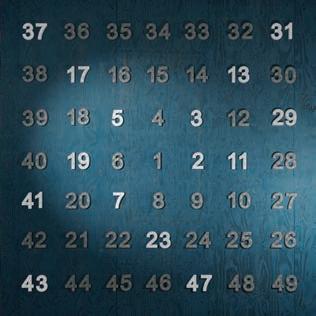
A primenumber isapositivewholenumberthathasonlytwo factors: 1 anditself.
• Thesmallestprimenumbersinclude 2, 3, 5, 7, 11, 13, 17, 19, 23, 29,
Anumberthathasmorethantwofactorsiscalleda compositenumber
Exercise2D
Und er stand ing 1–4 4
1 Copyandcompletethefollowing. A numberhasonlytwofactors:
and . a Anumberthathasmorethantwofactorsisa number.
2 Thefactorsof 12 are 1, 2, 3, 4, 6 and 12.Is 12 aprimenumber?
a Thefactorsof 13 are 1 and 13.Is 13 aprimenumber? b
3a Listthefirst 10 primenumbers.
Q2Hint:Lookatthe Keyideas b
b Listthefirst 10 compositenumbers.
4a Whatisthefirstprimenumbergreaterthan 10?
b Whatisthefirstcompositenumbergreaterthan 10?
Fluency
Example10Decidingifanumberisprimeorcomposite
Whichofthesenumbersareprimeandwhicharecomposite: 22, 35, 17, 11, 9, 5?
Solution
Prime: 5, 11, 17
Explanation
Composite: 9, 22, 35 5, 11, 17 haveonlytwofactors(1 anditself). 9 = 3 × 3, 22 = 2 × 11, 35 = 5 × 7
Nowyoutry
Whichofthesenumbersareprimeandwhicharecomposite: 7, 25, 39, 43, 58, 73?
5 Labeleachofthefollowingasaprime (P) oracomposite (C) number.


Q5Hint:Aprimenumberhas onlytwofactors: 1 anditself.
Example11Findingprimefactors
Findtheprimenumbersthatarefactorsof 30
Solution Explanation
Factorsof 30 are: 1, 2, 3, 5, 6, 10, 15, 30
Primefactorsare 2, 3 and 5
Findallthefactorpairs: 1 × 30, 2 × 15, 3 × 10, 5 × 6 Determinewhichfactorsareprime. 1 isnotaprimenumber. 2 = 2 × 1, 3 = 3 × 1, 5 = 5 × 1
Nowyoutry
Findtheprimenumbersthatarefactorsof 48
6 Findtheprimenumbersthatarefactorsof:
Q6Hint:Listallthefactorsfirst.

7 Listthecompositenumbersbetween:
8 Listtheprimenumbersbetween:
Problem-solving and reasoning
9 Thefollowingarenotprimenumbers,yettheyaretheproduct (×) oftwoprimes.Findthetwoprimes thatmultiplytogive: 15 a 21 b 35 c 55 d 143 e 133 f

10 Whichofthefollowinghasacompletesetoffactorsthatare allprimenumbers,exceptfor 1 anditself? 12, 14, 16, 18, 20
Q10Hint:Firstlistallthefactors ofeachnumber.
11 Twinprimesarepairsofprimesthatareseparatedfromeach otherbyonlyonewholenumber.Forexample, 3 and 5 aretwinprimes. Findthreemorepairsoftwinprimes.
Q11Hint: 3, 4, 5
12 Answerthesequestionsforeachofthearrays(a to h)below. Isitpossibletorearrangethecountersintoarectanglewithtwoormore equalrows? i Ifitispossible,statethedimensionsofthenewrectangle. ii Statethenumberofcountersandwhetherthisisaprimeoracompositenumber. iii

Q12Hint:The‘dimensions’arethe numberofrows andthe number ofcolumns

13
Playthisgamewithaclassmate.Youwillneedalargesheetofpaper,adieandtwo‘racecars’(counters orerasers).
• Onthesheetofpaper,drawacurvylineforyourracetrack.
• Writethenumbers 1 to 50 alongyourtrackandcirclealltheprimenumbers.Forexample:
• Startwithbothcarson 1.Taketurnstorollthe dieanddriveyourcarthatnumberofplaces alongthetrack.
• Ifyourcarlandsonaprimenumber,itneedsa pitstop(flattyre,lowfuel,etc.)andyoumissa turn.
• Thecarthatwinsreachesthefinishlinefirst. (Youmustrollthecorrectnumbertoland exactlyon 50.)
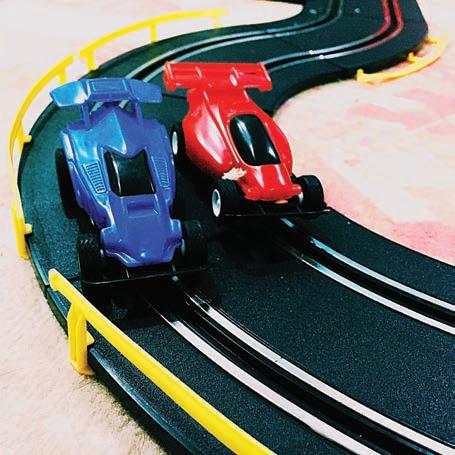
2E 2E Indexform
Learningintentions
• Tounderstandwhatanexpressionlike 85 means.
• Tobeabletowriteaproductinindexformiftherearerepeatedfactors.
• Tobeabletoevaluatenumericexpressionsinvolvingpowersusingmultiplication.
Keyvocabulary: base,power,index(plural:indices),expandedform,factorform,indexform,raised
Whenanumberismultipliedbyitself,weoftenwritethat productinindexform.
Forexample:
1000 = 10 × 10 × 10 (expandedform) = 103 (indexform)
For 103 wesay‘10 tothepowerof 3’.
Lessonstarter:Aneasierway
Whatisaneasierwayofwriting:
• 10 × 10 × 10 × 10,otherthan 10000?
• 10 × 10 × 10 × 10 × 10 × 10,otherthan 1000000?
• 2 × 2 × 2 × 2 × 2 × 2 × 2 × 2 × 2 × 2,otherthan 1024?
Computermemoryandhard-drivestorage aremeasuredinbytes.Doyouknowthe sizeoftheharddriveofyourcomputer atschool?Howmanybytesdoesithave? Copyandcompletethistableofcomputer storageunits.
Keyideas
Usingindexformmakesiteasiertowrite verylargenumberslike 1024
Numberofbytes kilobytekB
Wecanwritetheproductofrepeatedfactorswitha base numberandan index number. Thisiscalledwritinganexpressionin indexform Forexample:
32 768 = 8 × 8 × 8 × 8 × 8 85 number or value expanded form index form index or power = base
The power orindexshowsthenumberofrepeatedfactors.Itisthenumberthatabaseis raised to. 85 reads‘8 tothepowerof 5’.
Numbersinindexformareevaluatedfirstintheorderofoperations.
Forexample: 3 + 2 × 42 = 3 + 2 × 16
= 3 + 32 = 35
Notethat 23 = 2 × 2 × 2 = 8.
23 does not mean 2 × 3 = 6
Exercise2E
Und er stand ing 1–4 4
1 Writethemissingwords.
Theproduct 2 × 2 × 2 iscalledthe formof 8. a
23 iscalledthe formof 8 b
23 reads:‘2tothe of 3’. c
In 23,thespecialnameforthe 2 isthe number. d In 23,thespecialnameforthe 3 isthe or e
2 Copyandcompleteeachproductofrepeatedfactors.
32 = 3 × a
24 = 2 × × × b
53 = 5 × × c
85 = × × × × d
3 Copyandcompletethetable.
5 × 5 × 5
Copyandcompletethetable.
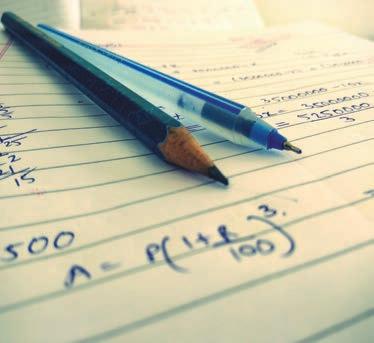

Q1Hint:Choosefromthewords: index, expanded, base, power

Fluency
Example12Convertingtoindexform
Simplifytheseproductsbywritingtheminindexform. 5 × 5 × 5 × 5 × 5 × 5 a 3 × 3 × 2 × 3 × 2 × 3 b
Solution
a 5 × 5 × 5 × 5 × 5 × 5 = 56
Explanation
Thefactor 5 isrepeatedsixtimes.
b 3 × 3 × 2 × 3 × 2 × 3 = 22 × 34 2 isrepeatedtwotimes. 3 isrepeatedfourtimes.
Nowyoutry
Simplifytheseproductsbywritingtheminindexform. 7 × 7 × 7 × 7 × 7 a 5 × 2 × 2 × 5 × 2 × 2 × 5 b
5 Simplifytheseproductsbywritingtheminindexform.
Q5Hint:Thebaseis thefactor.Thepower isthenumberof repeats. 3 × 3 × 3
Example13Expandingexpressionsinindexform
Writeeachofthefollowinginfactorformandfindthevalue.
Solution
a 24 = 2 × 2 × 2 × 2 = 16
b 23 × 52 = 2 × 2 × 2 × 5 × 5 = 8 × 25 = 200
Nowyoutry
Explanation
Thedigit 2 isrepeatedfourtimes. Calculatethevalue.
Thedigit 2 isrepeatedthreetimes,then multiply 5 by 5 Calculatethevalue.
Writeeachofthefollowinginfactorformandfindthevalue.
6 Writeinexpandedfactorformandfindthevalue.

7 Copyandcompletethefollowing.
a 3 × 2 = but 32 = × =
b 2 × 4 = but 24 = × × × =
c 5 × 2 = but 52 = × =
d 6 × 2 = but 62 = × =
8 Writeinexpandedform.(Donotfindthevalue.)
Example14Evaluatingexpressionswithindexform
Evaluate:
Solution
a 72 −62 = 7 × 7−6 × 6 = 49−36 = 13
b 2 × 33 + 102 + 17
= 2 × 3 × 3 × 3 + 10 × 10 + 1 × 1 × 1 × 1 × 1 × 1 × 1
= 54 + 100 + 1 = 155
Nowyoutry
Evaluate:
9 Evaluate:
Explanation
Writepowersinfactorform.
Domultiplicationbeforesubtraction.
Writepowersinexpandedform.
Domultiplicationfirst,thenaddition.

10 Findtheindexnumberforeachofthefollowing.
11 Writeoneofthesymbols <, = or > intheboxtomakethefollowingstatementstrue.

Q11Hint: < meanslessthan. > meansgreaterthan.
12 Fivefriendsreceivethesametextmessageatthesametime.Eachofthefivefriendsthenforwards ittofiveotherfriendsandeachofthesepeoplealsosendsittofiveotherfriends.Howmanypeople doesthetextmessagereach?

Thepowerofemail
13 Achainemailissentto 10 people.Fiveminuteslater,eachofthemsends itto 10 otherpeople.Thatis,after 10 minutes, 110 people (10 + 100) willhavereceivedtheemail.Fiveminuteslater,eachofthemsendsit ontotenotherpeople,etc.
a Howmanypeoplewillhavereceivedtheemailafter: 15 minutes? i 30 minutes? ii
b Iftheemailalwaysgoestoanewperson,howlong wouldittakeuntileveryoneinAustraliahasreceived themessage?(Australiahasapproximately 24.5 million people.)Rounduptothenext 5 minutemark.
c Howlongwouldittakeuntileveryoneintheworld hasreceivedthemessage?(Theworldpopulationis approximately 8 billionpeople.)

Q13Hint:Assume thateveryoneuses emailandeveryone canread!
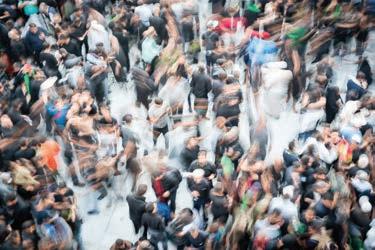
2F 2F Primefactors
Learningintentions
• Tounderstandthatcompositenumberscanbebrokendownintoprimefactors.
• Tobeabletouseafactortreeto ndtheprimefactorsofanumber(includingrepeatedfactors).
• Tobeabletoexpressaprimedecompositionusingpowersofprimenumbers.
Keyvocabulary: factor,compositenumber,primefactor,factortree
Everycompositenumbercanbewrittenastheproductofprimenumberfactors. Factortreeshelpustoworkouttheprimenumberfactors.Whentherearerepeatedfactors,wewrite thatproductinindexform.
Lessonstarter:Factortrees
Forhomework,JarrodandMatteachdrewafactortree.Thentheirlittlebrotherrubbedoutsomeof thenumbers.
• Canyoufindthemissingnumbers?Copyandcompleteeachfactortree.
• Whatwastheboys’homeworkquestion?
• HowisJarrod’sfactortreedifferentfromMatt’s?
• Whatisthesameaboutbothfactortrees?
• Canyoudrawadifferentfactortreethatanswersthehomeworkquestioncorrectly?
Keyideas
Every compositenumber canbewrittenasaproductofits primefactors
Wecanusea factortree orrepeateddivisiontofindtheprimefactorsofacompositenumber. Itisadiagramshowingthebreakdownofanumberintoitsprimefactors.
withprimefactors
Itishelpfultowritetheprimefactorsinascending(increasing)order,usingpowers.
Forexample:
Exercise2F
Und er stand ing
1 Sortthefollowinglistofnumbersintotwogroups: compositenumbersandprimenumbers. 15, 13, 7, 5, 8, 9, 27, 23, 11, 4, 12, 2, 3
2 Copyandcompletethefollowingfactortrees.
3 Copyandcompletetheserepeateddivisionswithprimenumbers.

Q1Hint:Aprimenumberhas twofactors: 1 anditself.
4 Rewritethesewiththeprimefactorsinascendingorder. Thenwriteusingpowers.

Q4Hint:Ascendingmeans smallesttolargest.
Example15Usingafactortreetofindprimefactors
Drawafactortreeforthenumber 120.Thenwrite 120 astheproductofprimefactors.(Use indexform.)
Solution Explanation
Startwith 120.Findanypairoffactors.
Allfactorsarenowprimes. Useindexformforrepeatedfactors. Thepower (3) showsthatthefactorof 2 is repeated 3 times.
Nowyoutry
Drawafactortreeforthenumber 300.Thenwrite 300 astheproductofprimefactors.(Use indexform.)
5 Foreachnumber,useafactortreetowritetheprimefactorisation ofthenumber.
Q5Hint:Writeprime factorsinascending order.Usepowersfor repeatedfactors.

6 Foreachnumber,useafactortreetowritetheprimefactorisation ofthenumber.
Example16Usingrepeateddivisiontofindprimefactors
Userepeateddivisionwithprimenumberstofindtheprimefactorsof 126.Thenwrite 126 asa productofprimefactorswithpowers.
Nowyoutry
Userepeateddivisionwithprimenumberstofindtheprimefactorsof 495.Thenwrite 495 asaproduct ofprimefactorswithpowers.
7 Userepeateddivisionwithprimenumberstofindtheprimefactorsof 96 Thenwrite 96 asaproductofprimefactorswithpowers.
8 Userepeateddivisionwithprimenumberstohelpyouwriteeach ofthesenumbersasaproductofprimefactorswithpowers.
Q7Hint:Youcouldstartby dividing 96 by 2
Problem-solving and reasoning
9 Matchthecorrectcompositenumber(a to d)toitssetofprime factors(A to D).

Q9Hint:Lookforeasywaystomultiply 10 2 × 3 × 5 × 5 15
10 Drawfourdifferentfactortreesthateachshowtheprimefactorsof 24.(Fortwotreestobedifferent, theymustshowdifferentcombinationsoffactors,notjustthesamefactorsinadifferentorder.)
11a Express 144 and 96 inprimefactorform.
b DeterminetheHCFof 144 and 96.Theprimefactorformmayhelp.
12 Onlyoneofthefollowingisthecorrectsetofprimefactorsfor 424

a Whyisoption C wrong?
Explainwhy A and B arewrong.
b
c
Showthatoption D isthecorrectanswer.
Q12Hint:Remembertherules fordivisibility.
Fourdifferentprimefactors 13
13 Only 16 compositenumberssmallerthan 1000 havefourprimefactors.Forexample: 546 = 2 × 3 × 7 × 13
Byconsideringtheprimefactorpossibilities,seehowmanyoftheother 15 compositenumbersyoucan find.Expresseachoftheminprimefactorform.
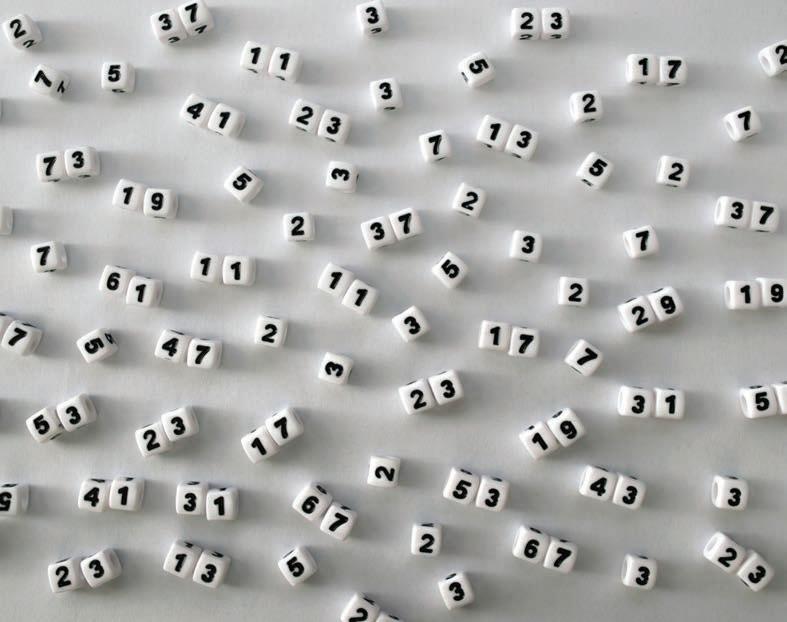
2G 2G Squaresandsquareroots
Learningintentions
• Tounderstandthatasquarenumbercanbethoughtofintermsoftheareaofasquare,orthenumberofitemsin asquarearray.
• Tobeableto ndthesquareofanumber.
• Tobeableto ndthesquarerootofaperfectsquare.
Keyvocabulary: squarenumber,squareroot,perfectsquare
Wecanpictureasquarenumberastheareaofasquareorthenumberofobjectsinasquarearray.
Forexample:









Numberofstrawberries = 3 rowsof 3 = 3 × 3 = 32 = 9 9 isasquarenumber. 16 isasquarenumber.
Findingasquarerootofanumberistheoppositeofsquaringanumber.Weusethesymbol √ toshow thesquarerootofanumber.
Thepicturesaboveshowthat √16 = 4 and √9 = 3
Lessonstarter:Shadingsquares
Youwillneedasheetof 1-cmgridpaper.
• Shadeasmanydifferent-sizedsquaresasyoucanfitontothepage.
• Writeeachareainindexform.Forexample, 62 = 36, 42 = 16,etc.
• Finally,oneachsquarewritethesidelengthasthesquarerootofthearea.Forexample, 6 = √
Keyideas
Ifyoumultiplyawholenumberbyitself,theresultisa squarenumber
Forexample: 52 = 5 × 5 = 25,so 25 isasquarenumber.
• Squarenumbersarealsoknownas perfectsquares
• Thefirst 12 squarenumbersare:
The squareroot ofagivennumbermultipliedbyitselfresultsinthegivennumber.
• Thesymbolforsquarerootis √
• Findingasquarerootofanumberistheoppositeofsquaringanumber.
Forexample: 42 = 16,so √16 = 4.
Wereadthisas‘4 squaredequals 16,so,thesquarerootof 16 equals 4’.
• Wecanlocateanysquarerootbetweentwopositiveintegersbyconsideringitssquare.
Forexample, √31 mustbebetween 5 and 6 because 31 isbetween 52 = 25 and 62 = 36
Orderofoperations
• Squaresarepowers,soevaluatefirst.Forexample:
• Squarerootsactlikebrackets.Forexample:
Exercise2G
1 Statethemissingwordornumber.

2 Copyandcompletethistableofsquarenumbers.
3 Copyandcompletethistableofsquareroots.
Example17Findingsquaresandsquareroots
Writethevalueofeachofthese:
42 a 7 squared b (3)2 d 5 tothepowerof 2 c squarerootof 36 e sidelengthofsquarewitharea 64 cm2 f
Solution
Explanation
a 42 = 16 42 = 4 × 4
b 7 squared = 49 7 squaredisthesameas 72
c (3)2 = 9 (3)2 = 3 × 3 = 9
d 5 tothepowerof 2 = 25 5 tothepowerof 2 isthesameas 52 , and 52 = 5 × 5 = 25
e squarerootof 36 = 6 √36 = 6 because 6 × 6 = 36
f sidelength = 8 cm sidelength = √64 and 8 × 8 = 64
Nowyoutry
Writethevalueofeachofthese:
a
4 Evaluate:
5 Evaluate: √25 a squarerootof 16 b √100 c thesidelengthofasquarethathasanareaof 49 cm2 d
6 Findthevalueof:

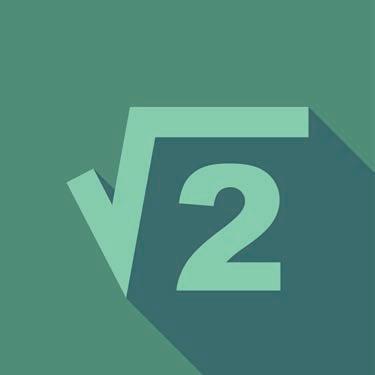
Example18Evaluatingsquareroots
Findthevalueof:
a √64 = 8
64 = 8 because 8 × 8 = 64
1600 = 40 because 40 × 40 = 1600
Nowyoutry
Findthevalueof:
7 Findthevalueof:

Example19Locatingsquarerootsbetweenpositiveintegers
Statewhichconsecutivepositiveintegersareeithersideof:
a 6 and 7 62 = 36 and 72 = 49 43 liesbetweenthesquarenumbers 36 and 49, so √43 liesbetween 6 and 7
b 11 and 12 112 = 121 and 122 = 144
130 liesbetweenthesquarenumbers 121 and 144,so √130 liesbetween 11 and 12
Nowyoutry
Statewhichconsecutivepositiveintegersareeithersideof:
8 Statewhichconsecutivepositiveintegersareeithersideof:
Example20Evaluatingexpressionsinvolvingsquaresandsquareroots
Evaluate:
Solution Explanation
a
Findsquarerootsfirst. Thenadd.
Thesquarerootsignislikeabracket:
Multiplyandaddtogive:
Evaluatesquaresandsquarerootsfirst.
Nowyoutry
Evaluate:
9 Evaluate:

Q9Hint:Remembertheorder ofoperations
10 Thisarrangementofdotsshowsthat 9 isasquarenumber.
a Show,usingdots,that 16 isasquarenumber.
b Show,usingdots,that 6 is not asquarenumber.
11 Listallthesquarenumbersbetween 50 and 101.
12 Listallthesquarenumbersbetween 101 and 200.Hint:Thereareonlyfour.
13a Showthat 32 + 42 = 52
b Does 52 + 62 = 72?
c Does 62 + 82 = 102?
d Findsomeothertruesumsofsquarenumbersliketheoneinpart a
Numberdotpatterns
14 Foreachofthefollowing:
Copythedotpatternanddrawthenextthreeterms. i Howmanydotsareaddedeachtime? ii Whatpatternsdidyounotice? iii oddnumbers a
1 3 5 evennumbers b
2 4 6 squarenumbers c
1 4 9 triangularnumbers d
1 3 6
15 Canyouseeaconnectionbetweentriangularnumbersandsquarenumbers?

1 2A Findthecompletesetoffactorsforeachofthesenumbers. 20 a 36 b
2 2A Writedownthefirstfivemultiplesofeachofthesenumbers. 12 a 21 b
3 2B Findthehighestcommonfactor(HCF)ofthefollowingnumbers. 24 and 40 a 35 and 70 b 18 and 42 c
4 2B Findthelowestcommonmultiple(LCM)ofthefollowingnumbers. 8 and 12 a 11 and 7 b 3, 5 and 10 c
5 2C Whichofthenumbers 75, 14, 141, 52, 88, 1234 aredivisibleby: 2? a 3? b 4? c 5? d
6 2C Workoutwhetherthefollowingcalculationsarepossiblewithoutleavingaremainder. 32689 ÷ 3 a 456336 ÷ 8 b
7 2D Whichofthesenumbersareprime(P)andwhicharecomposite(C)? 15, 23, 31, 39, 51, 80, 91
8 2D Findtheprimenumbersthatarefactorsof:
9 2E Simplifytheseproductsbywritingtheminindexform. 4 × 4 × 4 × 4 × 4 a 6 × 5 × 5 × 6 × 5 × 5 × 6 b
10 2E Writeeachofthefollowinginexpandedformandfindthevalue. 34 a 23 × 52 b 62 −23 c
11 2F Writethefollowingnumbersasaproductoftheirprimefactors,usingpowers. 40 a
12 2G Findthevalueof:
2H 2H Numberpatterns CONSOLIDATING
Learningintentions
• Tounderstandwhatanumberpattern(ornumbersequence)is.
• Tobeabletodescribeapatternwherenumbersareincreasingordecreasingbya xedamount.
• Tobeabletodescribeapatternwherenumbersaremultipliedordividedbya xedamount.
Keyvocabulary: pattern,sequence,term,rule,increasing,decreasing
Numberpatternscanbefoundinallsortsofnaturaland artificialsituations.Forexample,ifbacteriacellsdivideintwo everyhour,thenthenumberofbacteriafollowsthepattern 1, 2, 4, 8, 16, 32, 64, 128,andsoon.Ascientistcouldusethis patterntopredictthenumberofbacteriaafteracertaintime.
Itishelpfultofindtherulethatdescribesanumberpattern. Enteringrulesintoaspreadsheetmakesiteasytoperform calculationswithlargenumbers.Scientists,accountantsandmany otherpeopleusenumberpatternsandrulestohelpthemanalyse dataandmakepredictions.
Lessonstarter:Whichruleiswhich?

Numberpatternsappearallthroughout nature,suchasincelldivision.
• Workwithapartnertomatcheachofthesenumberpatternstothecorrectrule.Discussthethinking youused.
Numberpattern Rule
A 7, 12, 17, 22, 27, P Startwith 96 andkeepdividingby 2
B 96, 48, 24, 12, 6, … Q Startwith 7,add 5,add 6,add 7,etc.
C 96, 92, 88, 84, … R Startwith 7 andkeepadding 5
D 7, 12, 18, 25, 33, 42, … S Startwith 96,add 4,take 10,etc.
E 96, 100, 90, 94, 84, 88, 78, … T Startwith 96 andkeepsubtracting 4
• Makeupsomenumberpatternsofyourown.Thenswappatternswithanothergroup.Seeifyoucan workouteachother’srules.
Keyideas
Alistofnumbersarrangedinorderaccordingtosomeruleiscalledanumber pattern ora sequence
Eachseparatenumberinthesequenceiscalleda term
Tofindthetermsofasequence,followthepattern rule.Forexample:therule‘startwith 3 andadd 2 toeachterm’gives 3, 5, 7, 9, 11, ...
Tofindthepatternruleforasequence,ask:
• Isthesequence increasing or decreasing byafixedamount? 25, 28,31, 34, ...
+ 3 + 3 + 3 50, 45,40, 35, ... 5 5 5
• Iseachtermbeingmultipliedordividedbythesameamount? 4,12,36, 108, ...
2 ÷ 2 ÷ 2
× 3 × 3 × 3 64, 32, 16,8, ...
Exercise2H
Und er stand ing
1 Writethemissingwords/number.
Whenalistofnumbersfollowsapatternthatcanbe describedbyarule,itiscalleda a
Eachseparatenumberinasequenceiscalleda b
Themissingnumberinthesequence , 2, 4, 6, 8 is c
Themissingnumberinthesequence , 2, 4, 8, 16 is d
2 Listthenextthreetermsineachofthesesequences.
Q1Hint:Lookbackatthe Key ideas

64,32,16,
3 Listthefirstfivetermsofthesequenceforeachofthesepatternrules.
Startwith 8 andkeepadding 3 a Startwith 32 andkeepsubtracting 1. b
Startwith 52 andkeepsubtracting 4 c Startwith 123 andkeepadding 7 d
4 Listthefirstfivetermsofthefollowingnumberpatterns. Startwith 3 andkeepmultiplyingby 2 a
Startwith 5 andkeepmultiplyingby 4 b
Startwith 240 andkeepdividingby 2 c
Startwith 625 andkeepdividingby 5 d Fluency
Example21Findingpatternsthatchangebyafixedamount
Findthenextthreetermsforthesenumberpatterns.
6, 18, 30, 42, , , a 99, 92, 85, 78, , , b
Solution
a 54, 66, 78
b 71, 64, 57
Explanation
Thesamenumberisbeingaddedtoeachterm. Keepadding 12 tofindthenextthreeterms. 6,18,30,42,54,66,
Keepsubtracting 7 tofindthenextthreeterms. 99,92,85,78,71,64, 7 7 7 7 7 7 57
Nowyoutry
Findthenextthreetermsforthesenumberpatterns.
3, 7, 11, 15, , , a 126, 115, 104, 93, , , b
5 Findthenextthreetermsforthesesequences.
3, 8, 13, 18, , , a
4, 14, 24, 34, , , b
26, 23, 20, 17, , , c
106, 108, 110, 112, , , d
63, 54, 45, 36, , , e
9, 8, 7, 6, , , f
101, 202, 303, 404, , , g
h
75, 69, 63, 57, ,

Q5Hint:Lookforafixednumber thatisaddedorsubtracted.
Example22Findingpatternsthatinvolvemultiplicationordivision
Findthenextthreetermsforthefollowingnumberpatterns.
2, 6, 18, 54, , , a 256, 128, 64, 32, , , b
Solution
a 162, 486, 1458
b 16, 8, 4
Explanation
Eachtermisbeingmultipliedbythesamenumber. Keepmultiplyingby 3 tofindthenextthreeterms.
2,6,18,54,162,486, × 3 × 3 × 3 × 3 × 3 × 3 1458
Keepdividingby 2 tofindthenextthreeterms.
256,128,64,32,16,8,
4
Nowyoutry
Findthenextthreetermsforthefollowingnumberpatterns.
5, 20, 80, 320, , , a 729, 243, 81, 27, , , b
6 Findthenextthreetermsforthefollowingnumberpatterns.
2, 4, 8, 16, , , a
5, 10, 20, 40, , , b
96, 48, 24, , , c
1215, 405, 135, , , d
11, 22, 44, 88, , , e
7, 70, 700, 7000, , , f
256, 128, 64, 32, , , g
1216, 608, 304, 152, , , h
7 Findthemissingnumbersineachofthefollowingnumberpatterns.
62, 56, , 44, 38, , a
15, , 35, , , 65, 75 b
4, 8, 16, , , 128, c
3, 6, , 12, , 18, d 88, 77, 66, , , , 22 e
2997, 999, , , 37 f
Q6Hint:Iseachterm beingmultipliedor dividedbythesame number?

Q7Hint:These patternscaninvolve + or or × or ÷.

Example23Describingpatternsinwords
Foreachofthesesequences,writethepatternruleinwords.
2, 10, 50, 250, a 6, 10, 14, 18, b 32, 16, 8, 4, c 32, 28, 24, 20, d
Solution
Explanation
a Startwith 2 andmultiplyeachtermby 5 2, 10, 50, 250, ... × 5 × 5 × 5
b Startwith 6 andadd 4 toeachterm. 6, + 4 + 4 + 4 10,14, 18, ...
c Startwith 32 anddivideeachtermby 2 32, 16, 8, 4, ...
d Startwith 32 andsubtract 4 fromeachterm. 32, 28, 24, 20, ... 4 4 4
Nowyoutry
Foreachofthesesequences,writethepatternruleinwords.
3, 12, 48, 192, a 11, 14, 17, 20, b 625, 125, 25, c 123,
, d
8 Usewordstowritethepatternruleforeachsequence.
,
Problem-solving and reasoning
9 Writethenextthreetermsineachofthefollowingsequences.
a 3, 5, 8, 12, , ,
b 1, 2, 4, 7, 11, , , c 10, 8, 11, 9, 12, , , d 25, 35, 30, 40, 35, , ,
10 Afroghasfallentothebottomofawellthatis 6 metresdeep.
• Onthefirstdaythefrogclimbs 3 metresupthewall ofthewell.
• Ontheseconddayitslidesback 2 metres.
• Onthethirddayitclimbsup 3 metres.
• Onthefourthdayitslidesback 2 metres.
Q9Hint:Lookathowmucheach termincreasesordecreases.


Q10Hint:Drawadiagramof thewell.Usearrowstoshow themovementofthefrog.
Thefrogcontinuesfollowingthispatternuntilitreachesthetopofthewellandhopsaway.
a Writeasequenceofnumberstoshowthefrog’sheightabovethebottomofthewellattheendof eachday.
b Howmanydaysdoesittakethefrogtogetoutofthewell?
11 Foreachofthefollowingsequences,describethepatternrule.
4, 12, 36, 108, 324, a 19, 17, 15, 13, 11, b 212, 223, 234, 245, 256, … c 8, 10, 13, 17, 22, … d 64, 32, 16, 8, 4, … e 5, 15, 5, 15, 5, … f 2, 3, 5, 7, 11, g
12 Copyandcompleteeachofthefollowing.Givethespecialname foreachtypeofnumbers.
1, 4, 9, 16, 25, 36, , , a
1, 1, 2, 3, 5, 8, 13, , , b
1, 8, 27, 64, 125, , , c 2, 3, 5, 7, 11, 13, 17, , , d
4, 6, 8, 9, 10, 12, 14, 15, , , e 121, 131, 141, 151, , , f

Q12Hint: Choosefrom: compositenumbers, cubenumbers,evennumbers, Fibonaccinumbers,negative numbers,oddnumbers,palindromes, primenumbers,squarenumbers, triangularnumbers
13 Whenmakingahumanpyramid,eachrowhasonelesspersonthan therowbelow.Thepyramidiscompletewhenthereisarowofonly onepersononthetop.
Q13Hint:Drawadiagram. Writedownanumberpatternforahumanpyramidwith 10 students onthebottomrow.Howmanypeopleareneededtomakethis pyramid?


2I 2I Patternswithshapesandnumbers
Learningintentions
• Tounderstandthatspatialpatternsarerelatedtonumberpatterns.
• Toknowthataspatialpatternstartswithastartingdesignandhasarepeatingdesign.
• Tobeabletocontinueaspatialpatterngiventhe rstfewshapes.
• Tobeabletodescribeandusearulerelatingthenumberofshapesandthenumberofobjectsrequiredto makethem.
Keyvocabulary: spatialpattern,geometricalshapes,patternrule,numbersequence,tableofvalues
Repeatedgeometricshapesforminterestingspatialpatterns. Architectsoftenusespatialpatternsinthedesignofbuildings. Artistsalsouserepeatedgeometricshapesindesignstobe printedoncurtains,tilesandwallpaper.
Lessonstarter:Stickpatterns
Copytheseshapesusingmatchsticksortoothpicks.Then buildthenextthreeshapesinthepattern.

Patternswithgeometricshapesareused widelyinbuildingdesign.
Howmanystickswouldyouneedtomaketheshapewith:
• 10 triangles?
• 100 triangles?
Ifyouknowthenumberoftriangles,howcouldyoufindthenumberofsticks?Discussthiswithapartner andthenwriteyouranswer.
Usesimilarstepstoexplorethenumberofsquaresinthefollowingpattern.
Keyideas
A spatialpattern isasequenceof geometricalshapes.Forexample:
• Thenumberof‘diamonds’ineachtermmakesa numbersequence.
• Thenumberofsticksineachtermmakesanothernumbersequence.
A tableofvalues showsthenumberofshapesandthenumberofsticks.
4 8 12 16 20
A patternrule tellshowmanysticksareneededforacertainnumberofshapes. Forexample:numberofsticks = 4 × numberofshapes
Exercise2I
Und er stand ing
1 Jackusedmatchstickstobeginapatternofrectangles.
diagram 1 diagram 2 diagram 3
Writethemissingwordsornumbersforeachofthese.
a Theshapeofthefirstdiagramiscalleda
b Diagram 1 has rectangle,diagram 2 has rectanglesanddiagram 3 has rectangles.
c Diagram 1 has sticks,diagram 2 has sticksanddiagram 3 has sticks.
d Thesediagramsfollowasequencethatiscalleda pattern.
2 Janeusedmatchstickstomakeaspatialpatternofhouses.

Q2Hint:Howmanyextra sticksareneededtochange 1 houseinto 2 houses? Copyandcompletethistable.
Numberofhouses 1 2
Numberofsticks
3 Drawthenexttwotermsforeachofthesespatialpatterns.

Q3Hint:Whatshapeisbeing addedeachtimetomakethe nextdiagram?
Example24Findingageneralruleforaspatialpattern
a Drawthenexttwoshapesinthisspatialpattern.
b Completethetable.
Numberoftriangles 1 2 3 4 5
Numberofsticks 3
c Completethispatternrule:numberofsticks = × numberoftriangles
d Howmanystickswouldyouneedfor 20 triangles?
Solution
Explanation
a Followthepatternbyaddingonetriangle eachtime.
b Numberoftriangles 1 2 3 4 5
Anextra 3 sticksarerequiredtomakeeach newtriangle.
c Numberofsticks = 3 × numberoftriangles 3 sticksarerequiredpertriangle.
d Numberofsticks = 3 × 20 triangles = 60 sticks 20 triangles × 3 stickseach
Nowyoutry
Drawthenexttwoshapesinthisspatialpattern. a Completethetable.
NumberofLshapes 1 2 3 4 5
b Completethispatternrule:numberofsticks = × numberofLshapes c Howmanystickswouldyouneedfor 30 Lshapes? d
Numberofsticks 2
4a Drawthenexttwoshapesforthisspatialpattern.
b Copyandcompletethistable.
Numberofcrosses 1 2 3 4 5
Numberofsticks

Q4Hint:Forpart c,checkthat yourpatternruleworksforall valuesinthetable.
c Copyandcompletethispatternrule:numberofsticks = × numberofcrosses.
d Howmanystickswouldyouneedfor 10 crosses?
5a Drawthenexttwoshapesforthisspatialpattern.
b Copyandcompletethistable.
Numberofsquares 1 2 3 4 5
Numberofsticks
c Copyandcompletethepatternrule:numberofsticks = × numberofsquares
d Howmanystickswouldyouneedfor 12 squares?
6a Drawthenexttwoshapesforthisspatialpattern.
b Copyandcompletethistable.
Numberofhexagons 1 2 3 4 5
Numberofsticks
c Copyandcompletethepatternrule: numberofsticks = × numberofhexagons
d Howmanystickswouldyouneedfor 20 hexagons?

Q6cHint:Howmanyextra stickswouldyouneedtoadd anotherhexagon?
Problem-solving and reasoning
7 Listtheshapes(A to D)inthecorrectordertomakeaspatialpattern.(Startwiththesmallestshape.) Thendrawthenextshapeinthesequence.
Example25Findingmore-challengingrules
a
Drawthenexttwoshapesforthisspatialpattern.
b
Copyandcompletethetable.
Copyandcompletetheruleforthepattern: numberofsticks = 1 +× numberofsquares
c Howmanysticksareneededtomake 30 squaresthisway?
e
d Howmanysquarescouldbemadefrom 25 sticks?
Solution
a
b
c Numberofsticks = 1 + 3 × numberofsquares
d 91 sticks
e 8 squares
Explanation
Add 3 sticksatatimeto completeeachnewsquare.
Countthesquares. Completethecalculations, thencountsticksinthe diagramstocheck.
Thenumberofsticksis 1 morethan 3 timesthe numberofsquares.
Nowyoutry
Drawthenexttwoshapesinthisspatialpattern. a
b
Copyandcompletethetable.
Copyandcompletetheruleforthepattern: numberofsticks = 1 + × numberofhexagons c Howmanysticksareneededtomake 12 hexagons? d Howmanyhexagonscouldbemadefrom 41 sticks? e
8a Drawthenexttwoshapesforthisspatialpattern.
b Copyandcompletethistable.

Q8Hint:Howmanyextra sticksareneededtomake 1 stickintoatriangle?
c Copyandcompletetheruleforthispattern: numberofsticks = 1 + × numberoftriangles.
d Howmanysticksareneededtomake 12 trianglesthisway?
e Howmanytrianglescouldbemadefrom 81 sticks?
9a Drawthenexttwoshapesinthisspatialpattern.
b Copyandcompletethistable.
c Copyandcompletetheruleforthispattern: numberofsticks = 1 + × numberofshapes
d Howmanysticksareneededtomake 20 shapesthisway?
e Howmanyshapescouldbemadefrom 86 sticks?
Q9Hint:Copythelast shapeandaddmore stickstomakethe nextshape.

10a Drawthenexttwoshapesinthisspatialpattern.
0 fence sections 1 fence section planks 2 fence sections
b Copyandcompletethistable. Numberoffencesections 0 1 2 3 4
1 + =
c Copyandcompletethepatternrule: numberofplanks = 1 + × numberoffencesections.
d Howmanyplankswouldyouneedtomake 9 fencesections?
e Howmanyfencesectionscanbemadefrom 43 planks?
11 Whichrulecorrectlydescribesthisspatialpattern?
A Numberofsticks = 7 × numberof‘hats’
B Numberofsticks = 7 × numberof‘hats’ + 1
C Numberofsticks = 6 × numberof‘hats’ + 2
D Numberofsticks = 6 × numberof‘hats’
12 Whichrulecorrectlydescribesthisspatialpattern?
A Numberofsticks = 5 × numberofhouses + 1
B Numberofsticks = 6 × numberofhouses + 1
C Numberofsticks = 6 × numberofhouses
D Numberofsticks = 5 × numberofhouses
Designyourownspatialpattern 13
13 Designaspatialpatterntofitthefollowingnumberpatterns.
a 4, 7, 10, 13,
b 4, 8, 12, 16,
c 3, 5, 7, 9, …
d 3, 6, 9, 12, …
e 5, 8, 11, 14, …
f 6, 11, 16, 21, …
2J 2J Tablesandrules
Learningintentions
• Tounderstandthataruleconnectstwovaryingquantities.
• Tobeabletocompleteaninput-outputtablegivenarule.
• Tobeableto ndaruleintheforminput=? × output+?foraninput-outputtable.
Keyvocabulary: input,output,tableofvalues,rule,substitute
Inthelastsection,weinvestigatedrulesforspatialpatterns.Rulesarealsousefulformanyother everydaysituations.
Itcanbehelpfultothinkofaruleasa‘machine’.Youfeedinonenumber(theinput),andanother number(theoutput)comesout.Forexample,Marywas 3 yearsoldwhenherbrotherTimwasborn.Ifyou knowTim’sage(theinput),whatisaruleforfindingMary’sage(theoutput)?
Showingsomevaluesinatablemakesiteasyto‘see’therule.
Tim’sage(input) 0 1 7 3 + 3
Mary’sage(output) 3 4 10 6
Lessonstarter:What’sthestory?
Rule: Mary’sage = Tim’sage + 3
output = input + 3
Eachofthefollowingstoriestellshowaninputandoutputarerelated.
Story input output
1 Connoris 5 yearsyoungerthan hisbrotherDeclan. Declan’sage Connor’sage
2 Liamearns $5 foreverycarhe washes. numberofcarswashed amount ($) earned
3 Jayceand 4 friendssharesome lolliesequally. totalnumberoflollies numberoflollieseachpersongets
• Whichstorymatchesthefollowingtableofinputandoutputvalues?Howdidyoudecide?
• Howwouldyoufindthemissingvalues?
• Pickoneoftheotherstoriesandmakeupyourowntableofvalues.
Keyideas
A rule showstherelationshipbetweentwoamountsthatcanvary.Itisused tocalculatethe output (answer)fromthe input (startingnumber).
A tableofvalues showsinputsandoutputs.Tomakeatableofvalues:
• choosesomeinputvalues
• usetheruletocalculatetheoutputvalues.
Tofindtherulefromatableofvalues,trydifferentoperations (+, , ×, ÷) untilyoufindarule thatworksfor all thevalues.Forexample:
Togettheoutputsinthetableabove,hasthesamenumberbeen:
• addedtoeachinput?(no)
• subtractedfromeachinput?(no)
• multipliedbyeachinput?(yes)
Theruleis: output = 3 × input
Exercise2J
1 Hereisaspatialpattern.Each‘flower’ismadewith 4 sticks.
1 flower 2 flowers 3 flowers
a Copyandcompletethisrule: output (sticks) = 4 × input ( )
b Copyandcompletethistableofvalues.
Numberofflowers(input) 1 2 3 4 5 × 4
Numberofsticks(output)
2 Ebonyis 3 yearsolderthanJos ´ e.
a Copyandcompletethisrule: output ( ) = input (Jos ´ e’sage) + 3
b Copyandcompletethistableofvalues.
Jos ´ e’sage(input) 1 3 7 12 15 + 3
Ebony’sage(output)
3 Jakeearns $8 anhour.
a Copyandcompletethisrule: output (amountearned) = 8 × (hoursworked)
b Copyandcompletethistableofvalues.
Hoursworked(input) 1 2 3 4 5 × 8
Amountearned(output)
4 Useeachruletofindtheoutputwhentheinput = 8 output = input × 2 a output = input −2 b output = input + 2 c output = input ÷ 2 d
Example26Completingatableofvalues
Completeeachtableforthegivenrule.
b
output = input −2 input 3 5 7 12 20 output a output = (3 × input) + 1 input 4 2 9 12 0 output
Solution Explanation
a output = input −2 input 3 5 7 12 20 output 1 3 5 10 18
b output = (3 × input) + 1
4 2 9 12 0
13 7 28 37 1
Nowyoutry
Completeeachtableforthegivenrule.
Puteach input value,inturn,intotherule.
e.g.When input is 3: output = 3−2 = 1
Puteach input value,inturn,intotherule.
e.g.When input is 4: output = (3 × 4) + 1 = 13
output = input + 5 input 0 1 5 10 12 output a output = (input ÷ 3) + 1 input 93
5 Copyandcompleteeachtableforthegivenrule.
Q5Hint:Substituteeachinput numberintotherule. output = input + 3 input 4 5 6 7 10 output a output = input × 2 input 5 1 3 21 0 output
b output = input −8 input 11 18 9 44 100 output c output = input ÷ 5 input 5 15 55 0 100 output d

6 Copyandcompleteeachtableforthegivenrule.
a output = (input ÷ 2) + 4 input 6 8 10 12 14 output
Q6Hint:Remembertocalculate bracketsfirst. output = (10 × input) −3 input 1 2 3 4 5 output
b output = (3 × input) + 1 input 5 12 2 9 0 output
d
c output = (2 × input) −4 input 3 10 11 7 50 output
Example27Findingarulefromatableofvalues
Findtheruleforeachofthesetablesofvalues.
Solution
Explanation
a output = input + 9 Each output valueis 9 morethanthe input value.
b output = input × 7 or output = 7 × input Byinspection,itcanbeobservedthateach output valueis 7 timesbiggerthanthe input value.
Nowyoutry
Findtheruleforeachofthesetablesofvalues.
7 Statetheruleforeachofthesetablesofvalues.
Q7Hint:Thesame rulemustworkfor eachinput/output pairinatable.


Problem-solving and reasoning
8 Copyandcompletethemissingvaluesinthetableandstatetherule.
Q9Hint:Therulemustbetruefor eachinputnumberinthetable.

9 Matcheachrule(A to D)withthecorrecttableofvalues(a to d).
Rule A: output = input −5
=
:
+ 1 Rule C: output = 4 × input
10 WhenZacwasborn,hisgrandfatherplaced $100 inaspecialaccounttosaveforhiseducation. Headds $50 totheaccounteverytimeZachasabirthday.
a CopyandcompletethistableforZac’sbirthdayaccount: Zac’sageinyears(input) 0 1 2 3
Amount($)inaccount(output)
b CopyandcompletethisruleforZac’sbirthdayaccount: output = × input +
c HowmuchwillbeintheaccountwhenZacturns 18?

11 Cindyhas $64 savedsofarfortheschoolskitrip.Shehasjuststartedworkingatthelocalvets,helping tocleanoutpensandfeedtheanimals.Cindygetspaid $8 anhourandsavesallherwages towardstheskitrip.
a CopyandcompletethistableforCindy’ssavings:
Hoursworked(input) 0 2 5 10 Cindy’stotalsavings(output)
b CopyandcompletethisruleforCindy’ssavings: output = × input +

Q11Hint:Forpart c, firstworkouthow muchmoreCindy needstoearn.
c Cindywantstosave $200 topayfortheskitrip.Howmanyhourswillsheneedtowork?
12 Completethesetwodifferentrulessothattheyeachgiveanoutputof 7 whentheinputis 3
a output = × input +
b output = × input
Findingharderrules
13,14
13 Thefollowingrulesallinvolvetwooperations.Findtheruleforeachofthesetablesofvalues.
= × input
a output = × input +
4
6 7 8
5 7 9 11 13
= × input
1 2 3 4 5
5 9 13 17 21
c output = input ÷ + input 6 18 30 24 66
10 8 3 1 14
49 39 14 4 69
3 5 7 6 13
e output = × input input 1 2 3 4 5
output = × input + input 4 5 6 7 8 output 43 53 63 73 83
0 4 8 12 16
14 UseaspreadsheettomakeeachofthetablesinQuestion 13.Eachtime,enter aformulasothatthecomputercalculatesalltheoutputvalues. Hereisanexampleoftheformulasfor a above.Tryextendingyour tablesbyusingotherinputnumbers.
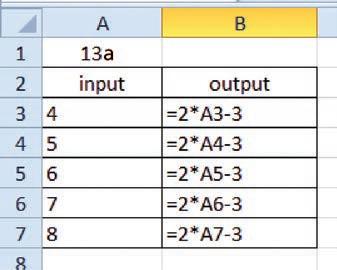

Q14Hint: Whenenteringformulas: – alwaysstartwith = – use*for × – insteadoftyping‘A3’justclick oncellA3 – tocopytheformulaintoother cells,filldownbydragging.
2K 2K TheCartesianplaneandgraphs
Learningintentions
• Tobeabletointerpretthelocationofapointdescribedbyitscoordinates,e.g. (x, y)(2, 4)
• Tobeabletoplotoneormorepointsgiventheircoordinates.
• Tobeabletodrawagraphofaruleusingatable.
Keyvocabulary: Cartesianplane, x-axis, y-axis,origin,plot,coordinates,input,output
Inearliersectionswelookedatnumbersequencesandspatialpatterns.Weusedrulesandtablesof valuestodescribethem.Anotherwayofshowingapatternisbyplottingpoints.Forexample,wecould useanumberlinetoshowthesimplepattern 3, 6, 9, 12, … 4
However,whenweworkwithtwosetsofvalues(inputsandoutputs)weneedtwodimensions. Insteadofanumberline,weuseanumberplane.
Lessonstarter:Locatingpoints
Thisgridshowsapatternofpointsonanumberplane.
• Describethebehaviourofthe y valuesasthe x valuesincrease.
• Bycontinuingthepattern,whatwouldbethe y valuefor x = 7 or x = 0?
• Howwouldyouwritearulelinking y (theoutput)with x (theinput)?
• Howisthenumberplanelikeastreetmap?Howisitdifferent?
Keyideas
A Cartesianplane isagridfor plotting points.Importantfeaturesofanumberplaneare:
• The x-axis and y-axis:thesearehorizontalandverticalnumberlines.
• The origin:wherethe x-axisand y-axismeetat (0, 0)
the y-axis the x-axis the origin y x
Pointsarelocatedbyagrid-referencesystemof coordinates.
• Thepoint (x, y) means(x unitsacrossfromtheorigin, y unitsup).
• For (2, 4) the x-coordinateis 2 andthe y-coordinateis 4
Toplotthispoint,startattheoriginandgo 2 unitsacross,then 4 unitsup.
Foraruledescribingapatternwith input and output,the x-value isthe input andthe y-valueisthe output
Exercise2K
1 Copyandcompletethefollowingsentences.
a Thehorizontalaxisisknownasthe
b The istheverticalaxis.
c Thepointatwhichtheaxesintersectiscalledthe
d The x-coordinateisalwayswritten
e Thesecondcoordinateisalwaysthe
(2, 4)

Q1Hint:Lookatthe Key ideas
f Theletter comesbefore inthedictionary,andthe -coordinatecomesbeforethe -coordinateonthenumberplane.
2 Matcheachpointonthegridwithitscorrectcoordinates.

Q2Hint:Startat 0 andthen moveacrossandup.
Example28Plottingpointsonanumberplane
Drawanumberplaneandplotthesepointsonit.
A(2, 5) B(4, 3) C (0, 2)
y x
Nowyoutry
Explanation
Drawanumberplanewithbothaxeslabelledfrom 0 to 5 Thenumbersgoonthegridlines,notinthespaces.
Labelthehorizontalaxis x andtheverticalaxis y (2, 5) meansgoacross 2 from 0 (alongthe x-axis)andthen goup 5 units.Plotthepointandlabelit A
B(4, 3) means (4 across, 3 up) C (0, 2) means (0 across, 2 up) so C isonthe y-axis.
Drawanumberplaneandplotthesepointsonit.
A(1, 4) B(5, 0) C (3, 3)
3 Copyandcompletethecoordinatesforeachpointshownonthisnumberplane.
A(5,?) a
B(?, 5) b
C (?,?) c
D(3,?) d
E (?,?) e F (?, 4) f
4 Ongridpaper,drawanumberplane,withthenumbers 0 to 6 markedoneachaxis.Plotandlabel thesepoints:
A(3, 5) B(4, 2) C (0, 3) D(1, 0) E (6, 6)
5 Usegridpaperto drawanumberplanewiththe x-and y-axisnumberedfrom 0 to 10.Ploteachgroup ofpointsandjointheminorder,usingaruler.
(4, 10), (2, 8), (5, 9) a
Namethistypeofangle,lessthan 90°
(2, 6), (4, 6), (4, 3) b Namethistypeofangle,equalto 90°
(6, 8), (8, 8), (8, 5), (6, 5), (6, 8) c Namethisshape.
(5, 1), (6, 4), (7, 1), (5, 1) d
Namethistypeoftriangle.
(0, 0), (0, 3), (3, 0), (0, 0) e Namethistypeoftriangle.
(7, 3), (9, 3), (10, 6) f
Namethistypeofangle,lessthan 180°
6 Drawanumberplanefrom 0 to 8 onbothaxes.Plotthefollowingpointsonthegridandjointhemin theordertheyaregiven.
(2, 7), (6, 7), (
7 Writedownthecoordinatesofeachoftheselabelledpoints.

Q7Hint:Thecoordinatesare (x, y)or(across,up).
Example29Drawingagraph
Fortherule output = input + 1:
Copyandcompletethetableofvalues. a
b
Listthecoordinatesofeachpoint.
Ploteachpairofpointsonthenumberplane. c
Solution
a
Explanation
Usetheruletofindeach output valueforeach input value.Theruleis: output = input + 1,soadd 1 toeach input value.
b (0, 1), (1, 2), (2, 3) and (3, 4) Thecoordinatesofeachpointare(input, output). c
Ploteach (x, y) pairasapoint: (x unitsacrossfrom 0, y unitsup).
Nowyoutry
Fortherule output = input −1:
Copyandcompletethetableofvalues. a
Listthecoordinatesofeachpoint. b
Ploteachpairofpointsonthenumberplane. c
8 Forthegivenrule output = input + 2:
a Copyandcompletethegiventableofvalues.
b Listthecoordinatesofeachpoint.
c Ploteachpointonanumberplaneliketheonebelow.
9 Forthegivenrule output = input × 2:
a Copyandcompletethegiventableofvalues.
b Listthecoordinatesofeachpoint.
c Ploteachpointonanumberplaneliketheonebelow.
10 Drawanumberplanefrom 0 to 5 onbothaxes.Placeacross oneachpointwithcoordinatesthathavethesame x valueand y value.

Q8Hint:Coordinatesare (input, output) = (x, y)

11a Whichofthefollowingisthecorrectwaytodescribethepositionof point X ?
A 21
B 2, 1
C (2, 1) D (x2, y1) E (2x, 1y )
b Whichofthefollowingisthecorrectsetofcoordinatesfor point Y ?
A (2, 4)
B 4, 2 C (4, 2)
(2, 4)
a Plotthefollowingpointsonanumberplane.Jointhe pointsintheordergiventodrawthebasicshapeofahouse. (1, 5), (0, 5), (5,
b Drawadoorandlistthecoordinatesofthefourcornersofthedoor.
Q12Hint:Drawanumberplane with 0 to 10 onbothaxes.

c Drawawindowandlistthecoordinatesofthefourcornersofthewindow.
d Drawachimneyandlistthecoordinatesofthefourpointsneededtodrawthechimney.
Secretmessages
13 Agridsystemcanbeusedtomakesecretmessages.
Jakedecidestoarrangethelettersofthealphabetona numberplaneinthefollowingmanner.

a DecodeJake’sfollowingmessage:
b Codetheword‘secret’.
Toincreasethedifficultyofthecode,Jakedoesnotincludebracketsorcommasandheusestheorigin toindicatetheendofaword.
c Whatdothefollowingnumbersmean? 13515500154341513400145354001423114354.
d Codethephrase:‘Behereatseven’.
Computertechnician
Computertechniciansandcomputerengineers arepeoplewholovetechnologyanditsuses. Theirjobsrangeindifficulty,hoursandpay. Buttheyallneedtohaveanunderstanding ofpatternsandmathematics.
Thecomputerindustryisalwaysevolving.New devicesandapplicationsrequirelargerand largerstorage.Electronicdataisrepresentedin digitalformusingthedigits 0 and 1,whichare called‘bits’ofdata.A‘byte’is 8 bits,for example,thecapitalletterBis 1 bytestoredas ‘01000010’,whichhas 8 bitsofdata.
• A‘bit’ (1 b) isthesmallestdataunit(eithera 1 or 0 ).

• A‘byte’ (1 B) is 8 bits. Becausethereareonlytwopossiblebits(i.e. 0 or 1),computerstoragedataiscalledbinarydata andcanbewrittenaspowersof 2.Notethat‘bi’meanstwoofsomething,forexample,abicycle has 2 wheels.
1 Rememberingthatabytehas 8 bits,writeeachofthe followinginbytes.
16 bits(i.e. 16 b) a
2 Otherunitsarealsousedinfilestorage.Completethetable belowtofindthenumberofbytesforeachofthesestorageamounts.

Q1Hint:numberof bits ÷ 8 = number ofbytes.

3 Useafactortreeorrepeateddivisiontodeterminethefollowingstorageamountsaspowersof 2 64 GB a 512 GB b 2048 GB (= 2TB) c
4 Usethequestion 2 answerstohelpyouwriteeachofthefollowingin kilobytes (kB)
1 MB a 3 MB b
25 MB c 100 GB d
5 Intheearlydaysoftheinternet,downloadspeedswerequiteslow. Adial-upinternetspeedcouldbe 56 kb/s(kilobits persecond).
Determinetheunknownvaluesinthefollowingtableto findthedownloadtimesforthegivendatafiles.

Q4Hint: 1 MB = 1048576 1024 = ?kB

Q5Hint:Convert 56 kb/stokB/s 56 ÷ 8 = ?kiloBytes/s
Q5Hint:ConvertMBtokiloBytes 21 MB = 21 × 1024 = ?kiloBytes
Speedin kilobits/s Speed inkB/s (kiloBytes/s) Filesize inMB (MegaBytes) Filesize inkB (kiloBytes) Download timein seconds Download timetothe nearesthour
a 56
26 MBmusic video
b 56 152 MBgame
c 56 740 MBmovie
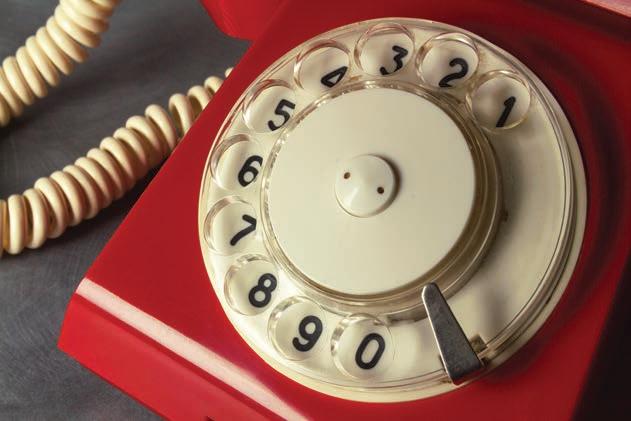

Usingtechnology
ComputerdownloadtimesdependonthespeedoftheInternetServiceProvider(ISP),thesizeofthe databeingdownload,thetypeandqualityoftheinternetconnection,theamountoftrafficusinga website,etc.
6 Inthisquestion,youwilluseaspreadsheettocalculatethedownloadtimesforvariousBroadband internetspeeds,whicharemeasuredinMb/s(Megabits persecond).
a Setupthefollowingspreadsheet.FormatalltheshadedcellsasNumber/1 d.p.

b IncolumnC,enterformulastocalculateMegabits.Recallthat thereare 8 bitsforeachbyte,so 8 Megabitsforeach Megabyte.
c IncolumnsDtoH,enterformulastocalculatethedownload timesinsecondsforeachdatafileforeachofthedifferent speeds.
d Howmuchfaster,inseconds,istheAppdownload timeat 100 Megabits/scomparedto 8 Megabits/s?
e Howmuchfaster,inminutesandseconds,isthemovie downloadtimeat 100 Megabits/scomparedto 8 Megabits/s?

Q6bHint:CellC5 formula = B5*8

Q6cHint:Formulasfordownload times:
Use $ signstofixtheaddressof thespeedcellforeachcolumn.
CellD5formula = C5/$D$3
CellE5formula = C5/$E$3
Tofillformulasdownthe column,dragthefillhandle down.
Plungepooltiling
TheAustralianPlungePoolCompanyoffersafreetiledpath aroundeachplungepoolconstructed.Thestandardwidthof eachplungepoolis 2 metres,butthelengthcanvary(itmust beawholenumberofmetres).
Thetilingiscompletedusing 1 metresquaretilesaroundall sidesofthepool.Thisdiagramshowsthetilingforapoolof length 3 metres.

Presentareportforthefollowingtasksandensurethatyoushowclearmathematicalworkings, explanationsanddiagramswhereappropriate.
1Preliminarytask
a Usethediagramabovetocountthenumberoftilesrequiredfora 2 metreby 3 metreplunge pool.
b Drawanaccuratediagramofarectanglewhichis 2 metresby 6 metres.Ifpossibleusegrid paper.
c Onyourdiagram,accuratelydraw 1 metresquaretilesaroundtheoutsideoftherectangle.
d Useyourdiagramtofindhowmanytileswouldberequiredfora 2 metreby 6 metreplunge pool.
2Modellingtask
Theproblemistofindarulerelatingthe numberoftiles requiredtothe lengthofthepool.
a Writedownalltherelevantinformationthatwillhelpsolvethisproblem.
b Usediagramstoillustratethefollowing 4 pools.
i 2 mby 2 m
ii 2 mby 3 m
iii 2 mby 4 m
iv 2 mby 5 m
c Useatableliketheoneshowntosummarisethenumberoftilesrequiredforvaryingpoollengths.
d Ifthepoollengthincreasesby 1 metredescribetheeffectonthenumberoftilesrequired.
e Ifapoolcouldhavealengthofonly 1 metrehowmanytileswouldneedtobeused?
f Determinetherulelinkingthenumberoftilesandthelengthofthepool.
Evaluate and verify
g Usingyourrulefrompart f above,findthenumberoftilesrequiredforaplungepooloflength: 8 metres i 15 metres ii
h Usingyourrulefrompart f above,findthelengthofaplungepoolifthenumberoftiles usedis:
22 i 44 ii
i Useyourruletoexplainwhytherewillalwaysbeanevennumberoftilesrequired.
Communicate
j Summariseyourresultsanddescribeanykeyfindings.
3Extensionquestions
Supposetheluxuryplungepoolscanhaveawidthof 3 metresinstead of 2 metres.Thelengthcanstillvary,howeveritmustbeawhole numberofmetres.
Useatableliketheoneshownbelowtosummarisethenumber oftilesrequiredforvaryingpoollengthswhenthepoolwidth is 3 m.
Poollength(m) 2 3 4 5 6
b
Determinetherulelinkingthenumberoftilesandthelengthofthesepools.
Statethedifferencebetweenthisnewruleandtherulefoundwhenthewidthis 2 metres. c

Makingpatterns (Keytechnology:Spreadsheets)
Numberpatternsmightseemlikeaneasythingtogeneratebutdescribingrelationshipswithinpatterns isatthefoundationofalgorithmsandcomplexmathematicalfunctions.Suchalgorithmscanhelpusto writecomputerprogramsandfindrulestohelpestimatesolutionstocomplexproblems.Twokeywords usedinthisinvestigationare‘sequence’and‘term’.Thepattern 3, 5, 7, 9, 11,forexample,isasequence offivetermsandcouldbedescribedasthelistofoddnumbersfrom 5 upto 11.Wewillusetheletter n todescribewhichtermwearetalkingabout.So, n = 2 referstothe 2ndterm,whichinthisexampleis 5

1Gettingstarted
a Thistableshowsninetermsoftheevennumbersequencestartingat 2
Whatisthe 4thterminthesequenceofevennumbers? i Whichtermisequalto 16? ii
b Method1:Onewaytogeneratethesequenceofevennumbersistoadd 2 tothepreviousterm. So,inthissequence,the 6thtermis 12 andsothe 7thtermis 12 + 2 = 14
Usethisideatofindthe 10thterminthesequence. i Whatwillbethe 13thterminthesequence? ii
c Method2:Anotherwaytofindtermsistousearuleandthevalueof n correspondingtothe termyouarefinding.Forexample:The 5thtermis 2 × 5 = 10 andthe 7thtermis 2 × 7 = 14 and so,ingeneral,the nthtermisgivenby 2 × n
Usethisideatofindthe 11thterminthesequence. i Whatwillbethe 17thterminthesequence? ii Whatwillbethe 29thterminthesequence? iii
2Applyinganalgorithm
Let’slookatgeneratingthelistofoddnumbersstartingat 1 using Method1 Lookatthisflowchartwhichgeneratesthesequence.
a Workthroughtheflowchartandwritetheoutputsintothistable
n 1 2 3
Term, t 1
b Whydoesthisalgorithmonlydeliver 5 valuesfor n and t?
c Anotherwayofgeneratingthelistofoddnumbersistousetherule: Term (t) = 2 × n −1.Thisis Method2 asdescribedinpart 1. Checkthisrulebyconfirmingthetermsinthetableabove. i Usethisruletofindthe 8thterm. ii Drawaflowchartthatoutputsthefirst 8 termsoftheoddnumbersequence usingthisrule. iii
3Usingtechnology
Wewilluseaspreadsheettogeneratetheoddnumbersequenceusingbothmethodsdescribed above.

a Createaspreadsheetasfollows.The n valueisincolumnAandthesequenceisgeneratedin columnsBandCusingthetwodifferentmethods.
b FilldownatcellsA5,B5 andD4 togenerate 8 terms.
c Describetheadvantagesanddisadvantagesofbothmethods.
d Nowconstructaspreadsheettogeneratethefollowingsequencesusingbothmethod1and2. Asequencestartingat 1 andincreasingby 3 eachtime. i Asequencestartingat 20 anddecreasingby 2 eachtime. ii

1 Toplay PrimeDrop withapartner,youwillneedanumberchart(withcirclesaroundtheprime numbers,andsquarenumberscolouredin)andadie.
3 WhatnumberamI?
a Readthefollowingcluestoworkouteachmysterynumber. Ihavethreedigits. Iamdivisibleby 5
Iamodd.
Theproductofmydigitsis 15
Thesumofmydigitsislessthan 10 Iamlessthan 12 × 12 i Ihavethreedigits.
Ihavethreedigits.
Iamoddanddivisibleby 5 and 9.
Theproductofmydigitsis 180
Thesumofmydigitsislessthan 20 Iamgreaterthan 302 iii
Thesumofmydigitsis 12
Mydigitsarealleven. Mydigitsarealldifferent. Iamdivisibleby 4
Thesumofmyunitsandtensdigitsequals myhundredsdigit.
b Makeuptwoofyourownmysterynumberpuzzlesandsubmityourcluestoyourteacher.
20: 1, 2, 4, 5, 10, 20 15: 1, 3, 5, 15
20: 20, 40, 60, 80, ... 15: 15, 30, 45, 60, 75, ...
Lowest common multiple LCM = 60 Multiples
5: factors 1 and 5
17: factors 1 and 17
A prime number only has two factors: 1 and itself. Prime numbers
Factor trees
10: factors 1, 2, 5, 10 62: factors 1, 2, 31, 62
Composite numbers are not prime. Composite numbers 0 and 1 are neither prime number nor composite.
Number properties
90 = 2 × 3 × 3 × 5 90 = 2 × 32 × 5
Highest common factor HCF = 5 Factors 10: last digit 0
8 = 2 × 4
9 = 2 × 4 + 1 Division 8 ÷ 2 = 4 no remainder 9 ÷ 2 = 4 remainder 1 243 = 3 × 3 × 3 × 3 × 3 = 35 Powers
Divisibility tests
2: last digit even or 0
3: sum digits ÷ 3 4: last two digits ÷ 4
5: last digit 0 or 5
6: ÷ by 2 and 3
8: last 3 digits ÷ 8 or are 000 9: sum digits ÷ 9
Sequence
A set of numbers ordered according to a rule
2, 4, 6, 8, ...
↑↑↑↑ terms
Spatial pattern: ...
Number pattern: 4 8 12 ...
Pattern rule:
Number of sticks = 4 × number of diamonds
output = 4 × input
Chapterchecklist
AversionofthischecklistthatyoucanprintoutandcompletecanbedownloadedfromyourInteractiveTextbook.
2A 1
Icanlistpairsoffactorsofanumber. e.g.Writethepairsoffactorsfor 18
2A 2 Icanlistthefactorsofanumber.
e.g.Findthecompletesetoffactorsforthenumber 40.
2A 3
2A 4
2B 5
Icanlistthemultiplesofanumber(uptoacertainlimit). e.g.Writedownthefirstsixmultiplesofthenumber 11
Icanidentifyanincorrectmultiplewithinasequence. e.g.Whichnumberisthewrongmultipleinthesequence 7, 14, 20, 28, 35?
Icanlistcommonfactorsandcommonmultiplesoftwonumbers. e.g.aListthecommonfactorsof 8 and 20.bListtwocommonmultiplesof 2 and 3.
2B 6 Icanfindthehighestcommonfactor(HCF)oftwonumbers. e.g.Findthehighestcommonfactor(HCF)of 36 and 48
2B 7 Icanfindthelowestcommonmultiple(LCM)oftwonumbers. e.g.Findthelowestcommonmultipleof 6 and 10
2C 8 Icandetermineifanumberisdivisibleby 2, 3, 5 and/or 10. e.g.Statewhether 2, 3, 5 and/or 10 arefactorsof 48569412
2C 9 Icandetermineifanumberisdivisibleby 4, 6, 8 and/or 9. e.g.Statewhether 4, 6, 8 and/or 9 arefactorsof 48569412
2D 10 Icandeterminewhetheranumberisprimebyconsideringitsfactors. e.g.Explainwhy 17 isprimebut 35 isnotprime.
2D 11
2E 12
2E 13
2E 14
Icanfindtheprimefactorsofanumber. e.g.Findtheprimefactorsof 30
Icanconvertanexpressiontoindexform. e.g.Write 3 × 3 × 2 × 3 × 2 × 3 inindexform.
Icanconvertanexpressiontoexpandedform. e.g.Write 24 inexpandedform.
Icanevaluateexpressionsinvolvingpowersusingtheorderofoperations. e.g.Evaluate 72 −62
2F 15 Icanexpressacompositenumberinprimefactorformusingafactortree. e.g.Drawafactortreeforthenumber 120.Thenwrite 120 astheproductofprimefactorsinindexform.
2F 16 Icanexpressacompositenumberinprimefactorformusingrepeated division.
e.g.Userepeateddivisionwithprimenumberstofindtheprimefactorsof 126.Thenwrite 126 asa productofprimefactorsinindexform.
2G 17 Icanfindthesquareofanumber.
e.g.Writethevalueof 42
2G 18 Icanfindthesquarerootofanumber.
e.g.Find √64,thesquarerootof 64.
2G 19 Icanlocatesquarerootsbetweenconsecutivepositiveintegers. e.g.Statewhichconsecutivepositiveintegersareeithersideof √43.
2G 20 Icanevaluateexpressionsinvolvingsquaresand/orsquareroots.
e.g.Evaluate √82 + 62
2H 21 Icanfindthenexttermsinanumberpatternthatchangebyafixedamount. e.g.Findthenextthreetermsforthenumberpattern 6, 18, 30, 42, …
2H 22 Icanfindthenexttermsinanumberpatternthatinvolvemultiplicationor division.
e.g.Findthenextthreetermsforthenumberpattern 256, 128, 64, 32,
2H 23 Icandescribeapatternintermsofthestartingvalueandtheoperationused togetfromeachvaluetothenext.
e.g.Writethepatternruleinwordsforthesequence 2, 10, 50, 250,
2I 24 Icandrawanddescribetermswithinaspatialpattern.
e.g.Drawthenexttwoshapesinthisspatialpatternanddescribetheruleintermsofhowmanysticks arerequiredtomakethefirstterm,andhowmanyareaddedeachtime.
2I 25 Icandescribeandusearuleforspatialpatterns.
e.g.Byfirstdrawingatable,findapatternruleconnectingthenumberofsticksrequiredtothenumberof triangles.Thenusethisruletofindthenumberofsticksfor 20 triangles.
2J 26
Chapter checklist
Icancompleteatableofvaluesforagivenrule.
e.g.Filloutthetablefortherule output = (3 × input ) + 1 input 4 2 9 12 0 output
2J 27 Icanfindaruleforatableofvalues.
e.g.Findtheruleforthetableofvaluesshown.
2K 28
Icanplotpointsonanumberplane.
e.g.Plotthepoints
2K 29 Icandrawagraphofarulebycompletingatableofvalues.
e.g.Fortherule output = input + 1,constructatableofvaluesusing input valuesof 0, 1, 2 and 3.Use thetableofcoordinatestoplotagraph.
Short-answerquestions
1 2A Copyandcomplete.
Thefactorpairsof 12 are 1 × = 12, × 6 = 12, × 4 = 12 a
Thefactorsof 12 inascendingorderare: , , , , , b
2 2A
2B
3
4 2B
Listallthefactorsof 24 inascendingorder.(Hint:Firstwritethefactorpairs.) a
Listthefirst 6 multiplesof 5.(Hint:Startwith 5 andcountinfives.) b
Listthefactorsof 16 a
Listthefactorsof 20. b
Circlethecommon(shared)factorsof 16 and 20 c
WhatdothelettersHCFstandfor? d
WritetheHCFof 16 and 20 e
Listthefirstfivemultiplesof 6 a
WhatdothelettersLCMstandfor? c
5 2C Writethemissingwordsornumbers.
Listthefirstfivemultiplesof 8 b
StatetheLCMof 6 and 8 d
Anumberthatendsin 0 isdivisiblebyboth and ,aswellas 2 a 264 is by 3 becausethesumofthedigitsis + + = and isdivisibleby 3 b 576 is by 9 becausethesumofthedigitsis + + = and is by 9 c 344 is by 4 becausethelasttwodigitsare and is by 4 d
6 2C 206, 48, 56, 621, 320, 85, 63, 14, 312
Fromthelistofnumbersabove,writethenumbersthataredivisibleby: 2
7 2D Answerthesequestions.
Isthenumber 1 aprimenumber? a
Isthenumber 1 acompositenumber? b
5 hasonlytwofactors, 1 and 5.Is 5 aprimenumber? c
Listthefactorsof 10.Is 10 aprimeorcompositenumber? d
Sortthesenumbersintoprimeorcompositenumbers: 2, 3, 8, 7, 11, 15, 20 e
Writethefactorsof 20 intwogroups,primeandcompositenumbers. f
Listtheprimenumbersbetween 15 and 25 g
8 2E/F Answerthesequestions.
For 16 = 42,whatnumberisthebase?Whatnumberistheindexorpower? a
Writetheproduct 5 × 5 × 7 × 7 × 7 inindexform. b Write 23 × 32 infactorformandfindthenumbervalue. c
Evaluate: 32 + 52 −3 × 2 (showsteps). d
Findthemissingpowers: 125 = 5 ; 32 = 2 ; 100000 = 10 e
9 2F Foreachnumber,drawafactortree.Thenwritethenumberwithpowersofprimefactors.
50 a 16 b 2400 c
10 2G
Copyandcompleteeachofthesetables.
11 2E/G
Findthevalueof:
12 2H
thesidelengthofasquarethathasarea = 25 cm2 j thesidelengthofasquarethathasarea = 400 cm2 k
Listthenextfourtermsforthesesequences.
Startwith 3 andkeepadding 4 a
Startwith 64 andkeepdividingby 2
13 2I
Drawthenexttwoshapesinthisspatialpattern. a
Copyandcompletethistable.
Numberofsticks 3 b Writethepatternrule. c Howmanystickswouldbeneededfor 12 triangles? d
14 2I Lookatthisspatialpattern.
a
Copyandcompletethistable.
Copyandcompletetheruleforthispattern: numberofsticks = 1 + × numberofsquares b
Howmanysticksareneededtomake 10 squaresthisway? c
Howmanysquarescouldbemadefrom 82 sticks? d
15 2J
Copyandcompleteeachtableforthegivenrule. output = input + 5 a input 3 5 7 12 20
output = 2 × input + 7 b
16 2J Writethepatternruleforeachofthesetables. output = × input a
3 4 5
15 20 25
= input b
15 20 28
9 14 22
17 2K
Statethecoordinatesofeachpointplottedonthisnumberplane. a Statethecoordinatesoftheorigin. b
Whichaxisispoint (0, 5) on? c Nametheverticalaxis. d
Whichaxisisthepoint (3, 0) on? e
Namethehorizontalaxis. f
Statethecoordinatesofapoint C sothat ABCD isasquare. g
18 2K Fortherule: output = 2 × input −1
Copyandcompletethistableofvalues.
Listthecoordinatesofeachpoint. b Ploteachpointonanumberplaneliketheone totheright.
19 2K Writearule(e.g. output = input × 2)thatwouldgivethesegraphs.
Multiple-choicequestions
1 2A
Whichnumberisthewrongmultipleforthefollowingsequence?
24, 27, 30
2 2A
Whichgroupofnumberscontainseveryfactorof 20?
3 2D
Whichofthefollowingnumbersisaprimenumber?
Whichofthefollowinggroupsofnumbersincludesoneprimeandtwocompositenumbers?
2F Theprimefactorformof 48 is:
2A Factorsof 189 include:
11 2C Whichnumberis not divisibleby 3?
E 12 2K Whichsetofpointsisinahorizontalline? (5, 5), (6, 6), (7, 7) A (3, 2), (3, 4), (3, 11) B (2, 4), (3, 6), (4, 8) C (5, 4), (6, 4), (8, 4), (12, 4) D (1, 5), (5, 1), (1, 1), (5, 5) E
Extended-responsequestions
1 SamisfiveyearsolderthanhissisterMikaela.
Copyandcompletethisrulefortheirages:Sam’sage = Mikaela’sage + a CopyandcompletethistableshowingSam’sageandMikaela’sageinyears.
Mikaela’sage 0 37
Sam’sage
c
b Ongridpaper,drawhorizontalandverticalaxesandlabeleachwiththenumbersfrom 0 to 20 (Becarefultomarkthenumbersnexttothegridlines,notinthespaces.)Labeltheaxesas follows.
Sam’s age Mikaela’s age
d
Onyourgraph,plotthepointsfromthetableabove.(Hint:Mikaela’sagegoes across,Sam’s agegoes up.)
2 AtNorthParkPrimarySchool,theclassroomshavetrapezium-shapedtables.MrsGreenearranges herclassroom’stablesinstraightlines,asshown.
a Copyandcompletethisrule:
Copyandcompletethistableforupto 5 tablesjoinedtogether.
Numberoftables 1 2 3 4 5
Numberofstudents
b
c
d
numberofstudents = × numberoftables +
Checkthattheruleworksforthenumbersinyourtable. Theroomallowsseventablestobearrangedinastraightline.Howmanystudentscansit aroundthetables?
Thereare 80 studentsinGrade 6 atNorthParkPrimarySchool.MrsGreenewouldliketo arrangethetablesinonestraightlineforanoutsidepicniclunch.Howmanytableswillshe need?
3 Fractionsand percentages

Essentialmathematics:whyworkingwithfractionsand percentagesisimportant
Vetsandnursesusefractionskillstodeterminemedicationdosages;forexample,adogneeds 12 1 2 mLofamedicationeveryfourhours.Fora 24-hourperioditrequires: 12 1 2 mL × 6 = 75 mL.
Nursescanusefractionskillstocalculatethetimeneededforanintravenousdriptofullydrain intoapatient’sarm;forexample, 2 3 4
hourperlitre = 5 1 2 hours.
Artists,housepainters,interiordecoratorsandDIYenthusiastscanuseratiostomixdesiredpaint colours.Forexample,mixingyellow:blueintheratio 15 : 1 formsalightshadeofgreen.
Engineersandbuildersworkattimeswithfractionsofaninch,asImperialmeasurementisusedin theUnitedStates.Forexample,aviationengineersandmechanicscalculateprecisemeasurements to 1 1000 ofaninch.
Shoppersusefractionandpercentageskillstocalculatediscountsandfindthebestbuy.

Inthischapter
3AIntroductiontofractions (Consolidating)
3BEquivalentfractionsandsimplifiedfractions
3CMixednumeralsandimproperfractions (Consolidating)
3DOrderingfractions
3EAddingfractions
3FSubtractingfractions
3GMultiplyingfractions
3HDividingfractions
3IFractionsandpercentages
3JFindingapercentageofanumber
3KIntroductiontoratios
3LSolvingproblemswithratios
AustralianCurriculum9.0
NUMBER
Findequivalentrepresentationsofrationalnumbersand representrationalnumbersonanumberline(AC9M7N04)
Usethe4operationswithpositiverationalnumbers includingfractions,decimalsandpercentagestosolve problemsusingefficientcalculationstrategies (AC9M7N06)
Recognise,representandsolveproblemsinvolvingratios (AC9M7N08)
Usemathematicalmodellingtosolvepracticalproblems involvingrationalnumbersandpercentages,including financialcontexts;formulateproblems,choosing representationsandefficientcalculationstrategies,using digitaltoolsasappropriate;interpretandcommunicate solutionsintermsofthesituation,justifyingchoicesmade abouttherepresentation(AC9M7N09)
MEASUREMENT
Usemathematicalmodellingtosolvepracticalproblems involvingratios;formulateproblems,interpretand communicatesolutionsintermsofthesituation,justifying choicesmadeabouttherepresentation(AC9M7M06)
©ACARA
Onlineresources
Ahostofadditionalonlineresourcesareincludedaspart ofyourInteractiveTextbook,includingHOTmathscontent, videodemonstrationsofallworkedexamples, auto-markedquizzesandmuchmore.
1 Inwhichofthefollowingisone-thirdoftheareashaded?
Warm-up
2 Howmanyofthesmallersquareswouldyoushadeforeachgivenfraction?
3 Writethefollowingasfractions.
4 Whichofthefollowingis not equivalentto(thesamevalueas)onewhole?
5 Whichofthefollowingis not equivalenttoone-half?
6 Find:
7 Find:
8 TomeatshalfablockofchocolateonMondayandhalfoftheremainingblockonTuesday. HowmuchchocolateisleftforWednesday?
9 Findthenextthreetermsinthesenumbersequences.
10 Write 1, 3 or 4 ineachboxtomakeatruestatement.
11 Find:
12 Statewhethereachofthefollowingistrue(T)orfalse(F).
3A 3A Introductiontofractions CONSOLIDATING
Learningintentions
• Tounderstandwhatafractionis.
• Toknowwhatthenumeratoranddenominatorofafractionrepresentindifferentsituations.
• Tounderstandhowafractionrelatestotheshadedareaofashape.
• Tobeabletorepresentfractionsonanumberline.
Keyvocabulary: fraction,denominator,numerator,vinculum,properfraction,improperfraction,mixednumber
ThewordfractioncomesfromtheLatinword‘frangere’, whichmeans‘tobreakintopieces’.Fractionsarepartsof awhole.
Weallusefractionseveryday.Theyareusedin cooking,shopping,sportandbuildingconstruction.

Lessonstarter:Whatstrengthdoyoulikeyourcordial?
• Tomuses 40 mLofcordialand 120 mLofwater.
• Sallyuses 40 mLofcordialwith 200 mLofwater.
Manyrecipes usefractions whenlisting ingredients.
• Wholikestheirdrinkthestrongest?Howcanfractionsbeusedtodescribethestrengthsofcordial?
Keyideas
A fraction isanumbermadeupofanumerator(up)anda denominator (down).
Forexample: 3 5 numerator denominator
• The denominator tellsyouhowmanypartsthewholeisdividedupinto.
• The numerator tellsyouhowmanypartswearetalkingabout.
• Thehorizontallineseparatingthenumeratorandthedenominatoriscalled the vinculum
A properfraction hasthenumeratorlessthanthedenominator.
Forexample: 2 7 isaproperfraction.
An improperfraction hasthenumeratorgreaterthanorequaltothedenominator.
Forexample: 5 3 isanimproperfraction.
Wholenumberscanberepresentedasfractions.
Forexample: 1 = 4 4 , 1 = 3 3 , 2 = 8 4
Mixednumbers haveawholenumberandafraction.
Forexample: 1 2 3 isamixednumber.
Wecanrepresentfractionsonanumberline. Thisnumberlineshowsthewholenumbers 0, 1 and 2.Eachunithasthenbeendividedequally intofoursegments,thereforecreating‘quarters’.
Exercise3A
1a Statethedenominatorofthisproperfraction: 2 9
b Statethenumeratorofthisimproperfraction: 7 5
2 Groupthefollowinglistoffractionsintoproperfractionsorimproperfractions.Alsostatewhich onesarewholenumbers.

Q2Hint:
Properfractions: Numeratorislessthandenominator. Improperfractions: Numeratorisgreaterthanorequalto thedenominator.
3 Statethemissingpartsinthefollowingtable.
Thewhole(divided intoequalparts)
Numberofequal partsinthewhole (denominator)
Numberofshaded equalparts (numerator) Fractionshaded Nameoffraction
4 Whatfractionsareindicatedbythedotsonthesenumberlines? a 3 12 0
b 3 12 0
Fluency
Example1Representingfractionsonanumberline
Showthefractions 3 5 and 9
5 onanumberline.
Solution
021 3 5 9 5
Nowyoutry
Showthefractions 3 4 and 5 4 onanumberline.
Explanation

Q4Hint:Writeany improperfractions asmixednumbers ifyouwish.
5–75,6(½),7,8
Drawanumberlinestartingat 0 andmarkonit thewholenumbers 0, 1 and 2
Divideeachwholeunitintofivesegmentsof equallength.Eachofthesesegmentshasa lengthofone-fifth.
5 Representthefollowingfractionsonanumberline.
6 Writethefollowingaswholenumbers.
Q5Hint:Toshowsevenths,rulea 7 cmlineforonewholeandmark eachcmforoneseventh. c
7 Shade 3 4 ofeachofthefollowingdiagrams. a b c d e

8 Writethenextthreefractionsforeachofthefollowingfractionsequences. 3 5 , 4 5 , 5 5 , 6 5 , , , a 5 8 , 6 8 , 7 8 , 8 8 , , , b 1 3 , 2 3 , 3 3 , 4 3 , , , c 11 7 , 10 7 , 9 7 , 8 7 ,,
9 Whatfractionmatcheseachofthedifferentshapes( , and )onthesenumberlines?

Q9Hint:Writeany mixednumbersas improperfractions aswell.
10 Matcheachofthefollowingdiagramstooneofthefractionsintheboxbelow.
11 Foreachofthefollowing,writethefractionthatisdescribingpartofthetotal.
a Afteronedayofa 43-kilometrehike,thestudentshadcompleted 12 kilometres.
b From 15 starters, 13 wentonandfinishedtherace.
c Rainfallfor 11 monthsoftheyearwasbelowaverage.
d Oneeggisbrokeninacartonthatcontainsadozeneggs.
e Twoplayersinthesoccerteam(with 11 players)scoredagoal.
f Thelunchstopwas 144 kilometresintothe 475-kilometretrip.
g Sevenmembersintheclassof 20 havevisitedAustraliaZoo.
h Oneofthecartyres(notincludingthespare)iswornandneedsreplacing.
i Itrainedthreedaysthisweek.
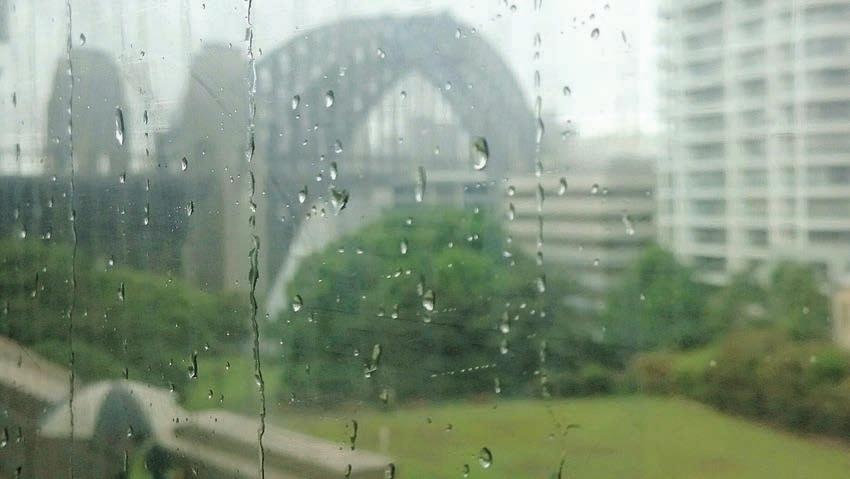
12 Whichdiagramhasone-quartershaded?
Adjustingconcentration 13
13a Callumpours 20 mLofwaterintothisbeaker.Whatfractionof 200 mListhat?
b Callumaddsacidtothesamebeakeruntilitholds 200 mL.How muchaciddidheadd?Whatfractionof 200 mListhat?
c Rosahasa 200 mLbeakerthatis 1 4 fullofwater.Howmuchacid willsheneedtoaddtofillthebeaker?
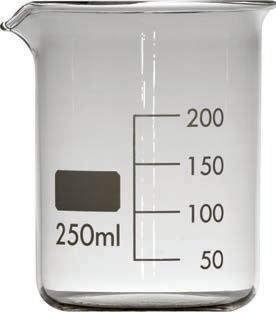
3B 3B Equivalentfractionsandsimplifiedfractions
Learningintentions
• Tounderstandwhatitmeansfortwofractionstobeequivalent.
• Tobeabletosimplifyfractions.
Keyvocabulary: equivalentfractions,highestcommonfactor,simplify
Fractionsmaylookverydifferentbutstillhavethesame value.Forexample,inanAFLfootballmatch,‘half-time’is thesameas‘theendofthesecondquarter’.Wecansaythat 1 2 and 2 4 areequivalentfractions.
Consideragroupoffriendseatingpizzasduringa sleepover.Thepizzasarehomemadeandeachpersoncuts uptheirpizzaastheylike.Thegreenshadingshowsthe amounteatenbeforeitistimetostartthesecondmovie.
Bylookingatthepizzas,itiscleartoseethatTrevor, Jackie,TahliaandJaredhavealleatenthesameamount ofpizza.
Thismeansthat 1 2 = 2 4 = 3 6 = 4 8.
Lessonstarter:Oddoneout
• Pickthefractionthatistheoddoneout. 25 100 , 4 16 , 2 8 , 2 5 , 5 20
• Whatcouldwecalltheotherfourfractions?
Keyideas
Equivalentfractions arefractionsthatmarkthesameplaceonanumberline. Forexample: 1 2 and 2 4 areequivalentfractions.
• Equivalentfractionsareproducedbymultiplyingthenumeratoranddenominator bythesamenumber.
• Equivalentfractionscanalsobeproducedbydividingthenumeratoranddenominatorby thesamenumber.
Simplifying fractionsinvolveswritingafractioninits‘simplestform’.Todothis,thenumerator andthedenominatormustbedividedbytheir highestcommonfactor(HCF),thelargestnumber whichdividesintobothnumbers.
• Youshouldusuallywritefractionanswersintheirsimplestform.
Trevor Jackie
Tahlia Jared
Afractionwallcanbehelpfulwhencomparingfractions.
1 UsethefractionwallintheKeyideastofind: fivefractionsequivalentto(equalto) 1 2 a twofractionsequivalentto 1 4 b threefractionsequivalentto 1 3 c onefractionequivalentto 4
2 Copyandcompletethefollowing.
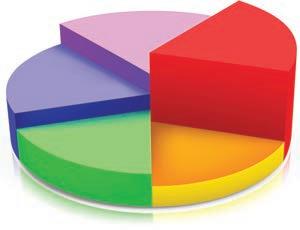
3 Fillinthegapstoreducethesefractionstotheirsimplestform. a 10 30
HCF = i 10 30 = 1 × 3 × . Therefore, simplestformis 3
Q3Hint: HCF means Highest Common Factor. ii

b 4 18
HCF = i 4 18 = 2 × 9 × Therefore,simplestformis 9 ii
c 4 28 HCF = i 4 28 = 1 × 7 × . Therefore,simplestformis 1 ii
d 9 15
3 bymultiplyingthenumeratoranddenominatorby 2, 3, 4 and 5
Nowyoutry
Writefourequivalentfractionsfor 4 5 bymultiplyingthenumeratoranddenominatorby 2, 3, 4 and 5
4 Writefourequivalentfractionsfor 2 7 bymultiplyingthenumeratorand denominatorby 2, 3, 4 and 5
5 Writefourequivalentfractionsfor 3 4 bymultiplyingthenumerator anddenominatorby 3, 5, 10 and 11

Q4Hint:Showthesteps eachtime.Forexample:
6 Fillinthemissingnumberstocompletethefollowingstringsofequivalentfractions.
7 Copyandcompletetheseequivalentfractions.

numerator(up)and denominator (down)bythesamenumber.
Example3Convertingtosimplestform
Writethesefractionsinsimplestform.
Explanation a 12 20 = 3 × ✁ 41 5 × ✁ 41 = 3 5
TheHCFof 12 and 20 is 4 Boththenumeratorandthedenominatoraredividedby theHCFof 4 4 ÷ 4 = 1
TheHCFof 7 and 42 is 7 The 7 is‘cancelled’(i.e. 7 ÷ 7 = 1)fromthenumeratorand thedenominator.
Nowyoutry
Writethefractionsinsimplestform.
8 Writethefollowingfractionsinsimplestform.
9 Bywritingeither = or ¢ inthebox,statewhethereachpairof fractionsisequivalentornotequivalent.Thefirstonehasbeen doneforyou.


Problem-solving and reasoning
10 Ineachgroup,choosethefractionthatisnotinitssimplestform.Whatshoulditbe? 1 3 , 3 8 , 5 9 , 7 14 a 2 5 , 12 16 , 15 19 , 13 37 b 12 19 , 4 42 , 5 24 , 6 61 c 7 63 , 9
11 Whichofthefollowingfractionsareequivalentto 8 20?
12 Afamilyblockofchocolateconsistsof 6 rowsof 6 individualsquares.Taniaeats 16 individualsquares. Whatfractionoftheblock,insimplestterms,hasTaniaeaten?
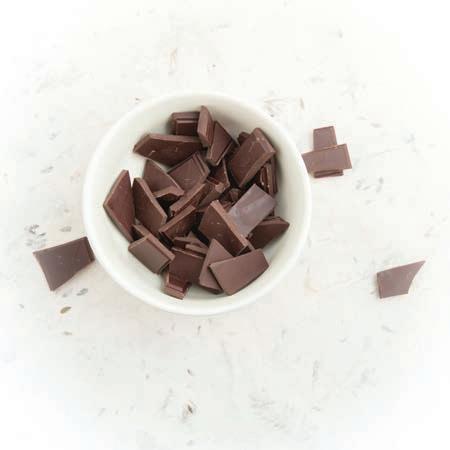
13 Jason,JoannaandJackaresharingalargepizzafordinner.Thepizzahas beencutinto 12 equalpieces.Jasonwouldlike 1 3 ofthepizza,Joannawould like 1 4 ofthepizzaandJackwilleatwhateverisremaining. HowmuchdoesJackeat?
14 Afractionwhensimplifiediswrittenas 3 5 Whatcouldthefractionhavebeenbeforeitwassimplified? Showyourfractiononadiagram.Isyourfractionthesameasthefractionofthestudentsitting nexttoyou?
3C 3C Mixednumeralsandimproper fractions
CONSOLIDATING
Learningintentions
• Tounderstandwhatimproperfractionsandmixednumeralsare.
• Tobeabletoconvertfromamixednumeraltoanimproperfraction.
• Tobeabletoconvertfromanimproperfractiontoamixednumeral.
Keyvocabulary: properfractions,improperfractions,mixednumerals,wholenumbers,remainder
Aswehaveseeninthischapter,afractionisa commonwayofrepresentingpartofawhole. Forexample,aparticularcartripmayrequire 2 3 ofatankofpetrol.
Onmanyoccasions,youmayneedwhole numbersplusapartofawholenumber. Forexample,alonginterstatecartripmay require 2 1 4 tanksoffuel.Whenyouhavea combinationofawholenumberanda fraction,wecallthisamixednumeral.
Lessonstarter:Pizzafrenzy
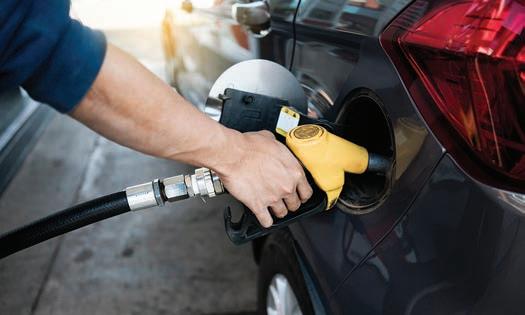
Alongcartripmayrequiremorethanonewholetankoffuel.
Tomate 1 1 2 pizzas.Chandraate 3 2 ofapizza.Whoatethemost?Discuss,showingeachperson’spizzas onaseparatediagram.
Keyideas
Anumberissaidtobea mixednumeral whenitisamixofa wholenumber plus a properfraction is
2 3 5
Improperfractions (fractionswherethenumeratorisgreaterthanorequaltothedenominator) canbeconvertedtomixednumeralsorwholenumbers.
Mixednumeralscanbeconvertedtoimproperfractions.
Anumberlinehelpsshowthedifferenttypesoffractions.
Exercise3C
1 Betweenwhichtwowholenumbersdothefollowingmixednumeralslie?
2 Themixednumeral 2 3 4 canberepresentedin‘windowshapes’as 2 3 4 = ++
Representthefollowingmixednumeralsusing‘windowshapes’.
3 A‘windowshape’consistsoffourpanesofglass.Howmanypanes ofglassarethereinthefollowingnumberof‘windowshapes’?
Q1Hint:Drawanumberlineto helpyoudecide.

4 Whatmixednumeralscorrespondtotheletterswrittenoneachnumberline?
Example4Convertingmixednumeralstoimproperfractions
Convert 3 1 5 toanimproperfraction.
Solution
Method1
Explanation
3 1 5 = 1 + 1 + 1 + 1 5 = 5 5 + 5 5 + 5 5 + 1 5 = 16 5 3 1 5 = 3 wholes + 1 5 ofawhole
Method2
3 1 5 = 15 5 + 1 5 = 16 5
Method3
Short-cutmethod:
Step 1:Multiplythewholenumberpartbythe denominator.
Step 2:Thenaddthenumerator: 3 × 5 + 1 = 16
3 1 5 = 3 × 5 + 1 5 = 16 5 5 3 1 5 3 1 5 = This is: 3 × 5 + 1
Step 1: Step 2: Then add 1.
3 × 5
Thedenominatorremains 5,aswearetalking aboutfifths.
Nowyoutry
Convert 2 3 4 toanimproperfraction.
5 Convertthesemixednumeralstoimproperfractions.
Example5Convertingimproperfractionstomixednumerals
Convert 11 4 toamixednumeral.
Solution
Explanation Method1 11 4 = 8 + 3 4 = 8 4 + 3 4 = 2 + 3 4 = 2 3 4
3 4 Method2 4 2 ) 11 rem. 3 = 2 3 4
Nowyoutry
Convert 22 7 toamixednumeral.
Dividethebottom(denominator)intothetop(numerator). Theremainderbecomesthefractionpart.
6 Converttheseimproperfractionstomixednumerals.
7 Foreachofthesediagrams,write:
Problem-solving and reasoning
8 10 4 simplifiesto 5 2 whichequals 2 1 2
Writethefollowingfractionsintwodifferentways.
9 Copythenumberlineandshowthefractionsonit.
10 Rewriteeachofthesepatterns,usingimproperfractions whereneeded.
11 Fourfriendsorderthreelargepizzasfortheirdinner.Eachpizzaiscut intoeightequalslices.Simonehasthreeslices,Izabellahasfourslices, MarkhasfiveslicesandAlexhasthreeslices.
a Drawcirclestoshowthethreepizzasordered.
b Howmanypizzaslicesdotheyeatintotal?

Q8Hint:It’seasiertosimplify first.

Q9aHint:Thisnumberlineis markedinthirds.

Q9bHint:Thisnumberline showsfifths.

Q11Hint:Remember,each pizzahas 8 equalslices.
c Howmuchpizzadotheyeatintotal?Giveyouranswerasamixednumeral.
d Howmanypizzaslicesareleftuneaten?
e Howmuchpizzaisleftuneaten?Giveyouranswerasamixednumeral.
Writingfractions
12 Whatdifferentfractionscanyouwriteusingonlythe digits 1, 2 and 3?Whoinyourclasswrotethemost? Assumethateachdigitcanonlybeusedonce ineachfraction.
12
Hint:Youcanincludeimproper fractionsandmixednumerals.You don’tneedtouseallthreedigits.

3D 3D Orderingfractions
Learningintentions
• Tobeabletocomparetwofractionsanddecidewhichoneisbigger.
• Tobeabletousethesymbols<or>tocomparetwonumbers.
• Tobeabletoorderalistoffractionsinascendingordescendingorder.
Keyvocabulary: lowestcommondenominator(LCD),equivalentfractions,ascending,descending
Justlikewholenumbers,fractionscanbewritteninorder.Wecanusetheideasfromsection 3Btohelp. Rememberthat > means isgreaterthan and < means islessthan Afractionisgreaterthananotherfractionifitliestotherightofthatfractiononanumberline.
3 4 > 1 2 1 0 1 2 3 4
Lessonstarter:Theorderoffive
• Asawarm-upactivity,askfivevolunteerstudents toarrangethemselvesinalphabeticalorder,thenin heightorderand,finally,inbirthdayorder.
• Eachofthefivestudentsreceivesalargefraction cardanddisplaysittotheclass.
Forexample, 1 2 , 1 10 , 2 10 , 10 2 , 2 3
• Therestoftheclassmustthenattempttoorder thestudentsinascendingorder,accordingtotheir fractioncard.Itisagroupdecisionandnoneofthe fivestudentsshouldmoveuntiltheclassagreesona decision.
Keyideas

Toorder(orarrange)fractionswemustknowhowtocomparedifferentfractions.There arethreecasestoconsider.
1 Ifthenumeratorsarethesame,thesmallestfractionistheonewiththelargest denominator,asthewholehasbeendividedupintothemostpieces.
Forexample: 1 7 < 1 2
2 Ifthedenominatorsarethesame,thesmallestfractionistheonewiththesmallest numerator.
Forexample: 3 10 < 7 10
3 Otherwise,use equivalentfractions tomakefractionswiththesamedenominator.(The lowestcommondenominator(LCD) isbest.)Thencomparenumeratorsasabove.
Ascending orderiswhennumbersareorderedgoing up,fromsmallest tolargest.
Descending orderiswhennumbersareorderedgoing down,from largesttosmallest.
Exercise3D
Und er stand ing
1 Statethelargestfractionineachofthefollowinglists.
Q1Hint:Whenthedenominators arethesame,comparenumerators: 6 7 ismorethan 5 7,justas 6 is morethan 5 3
2 Statethelowestcommonmultipleofthefollowingsetsofnumbers.
3 Statethelowestcommondenominatorofthefollowingsetsoffractions.



4 Fillinthegapstoproduceequivalentfractions.
Q3Hint:FindtheLCMofthe denominators.
Fluency
Example6Comparingfractions
Denominatorsarethesame,thereforecompare numerators.
b 1 3 > 1 5
Numeratorsarethesame. Thesmallerfractionhasthelargerdenominator. So 1 3 > 1 5
Nowyoutry
Write < or > ineachboxtomakeatruemathematicalstatement.
5 Write < or > tomaketruestatements.
6 Write < or > tomaketruestatements. 1 4
Example7Comparingfractionsbyusingacommondenominator
Whichislarger, 2 3 or 3 5 ?
Solution Explanation
2 3 = 10 15
3 5 = 9 15
2 3 > 3 5
Nowyoutry
Whichislarger, 3 5 or 4 7 ?
Findacommondenominator. Thelowestcommonmultiple (LCM) of 3 and 5 is 15
Produceequivalentfractionswiththatdenominator.
Comparenumerators:
7 Decidewhichfractionisthelargestineachpair. 1 2 and 2 3 a
and
3 2 and 5 4 d
Example8Orderingfractions

and
Q7Hint:Firstwrite eachpairof fractionswiththe samedenominator. f
Writethefractions 3 4 , 4 5 , 2 3 inascendingorder.
SolutionExplanation
45 60 , 48 60 , 40 60 LCDof 3, 4 and 5 is 60.Produceequivalentfractionswithdenominatorof 60
40 60 , 45 60 , 48 60 Orderfractionsinascendingorder.(Lookatthetopofeachfraction.)
2 3 , 3 4 , 4 5
Nowyoutry
Rewritefractionsbackinoriginalform.
Writethefractions 1 1 3 , 5 6 , 1 1 5 inascendingorder.
8 Placethefollowingfractionsinascendingorder.
Problem-solving and reasoning
9 Placethefollowingcakefractionsindecreasingorderofsize.
Spongecakesharedequallybyfourpeople = 1 4 cake A
Chocolatecakesharedequallybyelevenpeople = 1 11 cake
Carrotandwalnutcakesharedequallybyeightpeople = 1 8 cake C
Q8Hint:Ascendingorderis fromsmallesttolargest.


10 SallyandDionorderedtwolargepizzas. Sallyate 2 3 ofherpizza.Dionate 5 8 ofhispizza.
a Showeachperson’spizzasonaseparatediagram.
b Whoatethemostpizza?
c Shouldtheyhaveorderedonlyonepizza?
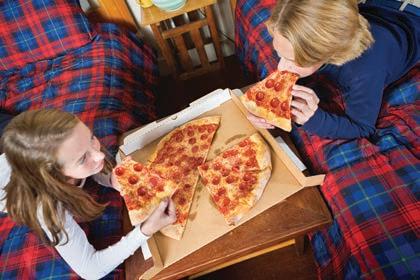
11 Rewritethefractionsineachsetwiththeirlowestcommondenominator.Thenwritethenexttwo fractionsthatwouldcontinuethepattern.
12 Writeafractionthatliesbetweenthefollowingpairsoffractions.

13a Foreachofthediagramsshown,workoutwhatfractionoftherectangleiscolouredpurple. ii i
b Createyourownrectangulardesignthatisthree-quarterspurpleoverall.
3E 3E Addingfractions
Learningintentions
• Tounderstandthataddingfractionsrequiresacommondenominator.
• Tobeabletoaddtwofractionsbyconsideringtheirlowestcommondenominator.
• Tobeabletoaddtwomixednumerals.
Keyvocabulary: lowestcommondenominator(LCD),equivalentfractions,simplify
Fractionswiththesamedenominatorcanbeeasilyaddedtogether.
Fractionswithdifferentdenominatorscannotbeaddedtogethersoeasily.
Butwithacommondenominatoritispossible.
+ three-twelfths = seven-twelfths
Lessonstarter:‘Like’addition
Asaclass,discusswhichofthefollowingpairsofnumberscanbesimplyaddedtogetherwithouthaving tochangetheminsomeway.
6 goals, 2 goals a 11 goals, 5 behinds b 56 runs, 3 wickets c 6 hours, 5 minutes d 21 seconds, 15 seconds e 47 minutes, 13 seconds f 15 cm, 3 m g 2.2 km, 4.1 km h 5 kg, 1680 g i 2 7 , 3 7 j
Youcanseethat,whenadding,theunitsneedtobethesame.Withfractions,the‘units’arethe denominators.
Keyideas
Fractionscanbe simplified usingadditioniftheyare‘like’fractions;thatis,iftheyhavethe samedenominator.
Ifthedenominatorsareequal,addthenumeratorsandretainthedenominator.
Forexample: 3 7 + 2 7 = 5 7
Ifthedenominatorsarenotthesame:
• findthe lowestcommondenominator(LCD)
• convertfractionsto equivalentfractions usingtheLCD
• addthenumeratorsandretaintheLCD
• simplifytheanswerifpossible.
Forexample: 2 3 + 4 5 = 10 15 + 12 15 = 22 15 or 1 7 15
Exercise3E
1 Copythefollowingsentencesandfillinthegaps.
a Toaddtwofractionstogether,theymusthavethe same
b Whenaddingfractionstogether,iftheyhavethesame ,yousimplyaddthe
c Whenaddingtwoormorefractionswherethe aredifferent,youmustfindthe

Q1Hint:Choosefrom: denominator, common,lowest,simplify,multiple, numerators,denominators
d Aftercarryingouttheadditionoffractions,youshouldalways youranswer.
2 Usewordstocompletetheseadditions.
one-third + one-third = thirds a one-quarter + two = three-quarters b three-tenths + tenths = seven-tenths c one-fifth + three-fifths = four d half + half = two-halves(onewhole) e
3 Copyandcompletethefollowingbyshadingtheshapeontherightside. a += b += c
d
4 Answertrue(T)orfalse(F)foreachofthefollowing.
Fluency
Example9Adding‘like’fractions
Addthefollowingfractionstogether.
b 3
Nowyoutry
Addthefollowingfractionstogether.
5 Copyandcomplete.
Thedenominatorsarethesame(‘like’),so simplyaddthenumerators. one-fifth + three-fifths = four-fifths
Denominatorsarethesame,soaddthe numerators.
Weareaddingelevenths.
Converttoamixednumberifrequired.
6 Addthesefractionsandwriteyouranswersusingmixednumbers.
Q6Hint:Whenyou addthesefractions, thedenominator staysthesame. i

Example10Adding‘unlike’fractions
Addthefollowingfractionstogether.
Solution
a 1 5 + 1 2 = 2 10 + 5 10 = 7 10
bc 3 4 + 5 6 = 9 12 + 10 12 = 19 12 = 1 7 12
Nowyoutry
Addthefollowingfractionstogether.
Explanation
LCDis 10
WriteequivalentfractionswiththeLCD. 1 5 × 2 2 = 2 10 1
Denominatorsarethesame,soaddnumerators.
LCDis 12
WriteequivalentfractionswiththeLCD. 3 4 × 3 3 = 9 12 5 6 × 2 2 = 10 12
Denominatorsarethesame,soaddnumerators. Writeasamixednumber,ifrequired.
7 Copyandcompletethefollowingadditions.
8 Addthefollowingfractions.

Q8Hint:Usesimilarstepsto question 7 l
Example11Addingmixednumerals
Simplify:
Solution
a 3 + 4 + 2 3 + 2 3 = 7 + 4 3 = 8 1 3
Alternatively
Explanation
Addthewholenumberpartstogether. Addthefractionpartstogether.
Notingthat 4 3 = 1 1 3,simplifytheanswer.
Firstconverttoanimproperfraction.
Addthenumerators.
Addthewholenumberpartstogether. LCDof 6 and 4 is 12 WriteequivalentfractionswithLCD.
Addthefractionpartstogether.
Notingthat 19 12 = 1 7 12,simplifytheanswer. Alternatively
Firstconverttoanimproperfraction.
ConvertusinganLCDof 12
Addthenumerators. Nowyoutry Simplify:
Problem-solving and reasoning
11 Dadgaveyou 2 5 ofthemoneyforamovieticketandMumgaveyou 1 5
a Whatfractionoftheticketdidyourparentspayfor?
b Whatfractionwasleftforyoutopay?
c Iftheticketcost $10,howmuchdidyoupay?
12 Julieowns 1 3 ofacompanyandSeanowns 1 4
a Whatfractionofthecompanydotheyowntogether?
b Whatfractionofthecompanyisleft?

13 Markspends 1 3 ofthedayatschooland 3 8 ofthedayasleep.
a Whatfractionofthedayhasbeenused?
b Whatfractionofthedayisleftforfun?
c Howmanyhoursoffundoesheget?
14 Tofindthenumberineachsquare,addthefractionsinthetwocirclesthatarejoinedtoit. Fillinthefollowingfractionnetworks.

15 Nowfindthefractionsinthecircleswithinthefollowingfractionnetworks. 11
3F 3F Subtractingfractions
Learningintentions
• Tounderstandthatsubtractingfractionsrequiresacommondenominator.
• Tobeabletosubtracttwofractionsbyconsideringtheirlowestcommondenominator.
• Tobeabletosubtracttwomixednumerals.
Keyvocabulary: lowestcommondenominator(LCD),equivalentfractions,simplify
Therulesforsubtractingfractionsareverysimilartoaddingfractions.Beforeyoucansubtract,weaimto writethefractionswiththesamedenominator.
Lessonstarter:Subtractiononanumberline
Copythenumberlineanduseittofind:
Keyideas
Fractionscanbe simplified easilyusingsubtractioniftheyare‘like’fractionswiththe samedenominator.
Therulesforsubtractingfractionsaresimilartothoseforaddingfractions. Whensubtractingmixednumbers,youmayneedtoborrowawhole. Forexample:
7 1 8 −2 3 8 1 8 isnotbigenoughtohave 3 8 subtractedfromit.
6 9 8 −2 3 8 Therefore,wechoosetoborrowawholefromthe 7 (6 + 1 = 7) Alternatively,firstconvertthemixednumeralstoimproperfractions.
Exercise3F
Und er stand ing
1 Copythefollowingsentencesandfillintheblanks.
a Tosubtractonefractionfromanother,youmusthaveacommon
b TheLCDof 6 and 12 is
c TheLCDof 3 and 5 is
2 Copyandcompletethefollowingsubtractions.
a three-tenths two-tenths = tenth
b three-quarters quarters = one-quarter
c four three-fifths = one-fifth
d onewhole two-fifths = fifths
e five-eighths two = three-eighths
Example12Subtracting‘like’and‘unlike’fractions
Denominatorsarethesame,thereforewearereadyto subtractthesecondnumeratorfromthefirst.
FindtheLCD,whichis 12 WriteequivalentfractionswiththeLCD.
Wehavethesamedenominatorsnow,sosubtractsecond numeratorfromthefirst.Thedenominatorstaysthesame (twelfths).
Nowyoutry
5 Simplify:
6 Simplify:

Q6Hint:Firstwriteeachfraction usingtheLCD.
Example13Subtractingmixednumerals
Explanation
Amixednumeralsistheadditionofawholenumberand aproperfraction.
Groupwholenumbersandgroupproperfractions. Simplifywholenumbers.
Makedenominatorsthesame.
Borrowingawholewasnotrequired.
Firstconverttoimproperfractions.
FindandusetheLCD.
Subtractthenumerators.
Converttotwentieths:
Borrowawholefromthe 8 sothatthenumeratorscanbe subtracted.
Subtractwholenumbers,subtractfractions.
Firstconverttoimproperfractions.
FindandusetheLCD.
Subtractthenumerators.
7 Simplify:
8 Simplify:

Q7Hint:Forsomeofthese,youwill firstneedtomakedenominators thesame.

Q8Hint:Youwillneedto‘borrow awhole’forsomeofthese.
Problem-solving and reasoning
9 Afamilyblockofchocolateismadeupof 60 smallsquaresofchocolate.Marciaeats 10 squares,Jon eats 9 squaresandHollyeats 5 squares.Whatfractionoftheblockofchocolateisleft?
10 Threefriendssplitarestaurantbill.Onepays 1 2 ofthebillandonepays 1 3 ofthebill.Whatfractionof thebillmustthethirdfriendpay?

11 Afullcontainerofflourweighs 4 5 kg.Theemptycontainerweighs 1
20 kg.Howmuchdoesthe flourweigh?
12 Copyandcompletethesetwosubtractions,whichusetwodifferenttechniques.Statewhich techniqueyouprefer,givingreasons.
Findingfractions 13
13 Twofractionshaveasumof 23 24 andadifferenceof 7 24 Canyoufindthetwofractions?

Q13Hint:Startbythinkingoftwo numbersthataddto 23 andhave adifferenceof 7
3G 3G Multiplyingfractions
Learningintentions
• Tounderstandthatmultiplyingfractionsiseasierifyou rstcancelcommonfactorsfromnumeratorsand denominatorsineachfraction.
• Toknowthatawholenumbercanbewrittenasafractionwithadenominatorof 1
• Tobeabletomultiplyfractions,mixednumeralsand/orwholenumbers,givingananswerinsimplestform.
Keyvocabulary: factor,simplify,mixednumeral,improperfraction
Whenwemultiplywholenumberstogether,weendupwithanumberlargerthan(orequalto)theones westartedwith.
2 × 3 = 65 × 7 = 3515 × 1 = 15
Butwhenwemultiplyfractionstogether,thingscanbedifferent.Considerhalfofhalfanapple,forexample, whichresultsinasmallerfractioncomparedtotheoriginalfractions.
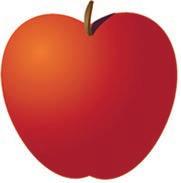
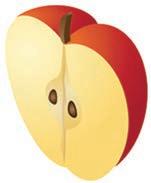
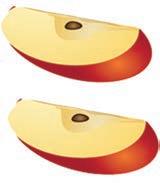
Lessonstarter:Partsofacircle
•
Howdoesthisdiagramshowhalfofhalfacircle?
• Whatishalfofthree-quartersofacircle?
Usediagramstoinvestigateotherfractionmultiplications. Whatshortcut(orrule)canyoufindtohelpmultiplyfractionstogether?
Keyideas
Fractionsdo not needtohavethesamedenominatortobemultipliedtogether. Tomultiplyfractions,multiplythenumeratorstogetherandmultiplythedenominatorstogether.
• Insymbols: a b × c d = a × c b × d
Ifpossible,‘simplify’or‘cancel’fractionsbeforemultiplying. (Remember,youcanonlycancelnumeratorswithdenominators.)
Mixednumerals mustbechangedto improperfractions beforemultiplying. Finalanswersshouldbewritteninsimplestform.
Exercise3G
Und er stand ing
1 Copythesesentencesandfillintheblanks.
a Aproperfractionhasavaluethatisbetween and b Animproperfractionisalwaysgreaterthanorequalto c Amixednumeralconsistsoftwoparts, a partand a part.
2 Copythegridshownhere.
a Onyourdiagram,usebluetoshade 1 3 of thegrid.
b Nowuseredtoshade 1 4 oftheshadedblue.
c Youhavenowshaded 1 4 of 1 3.Whatfractionis thisoftheoriginalgrid?

Q1Hint:Choosefrom: fraction, whole, number, 0, 1,and proper
3 If 1 3 of • = 4,whatis 2 3 of •? a If 1 10 of = 7,whatis 3 10 of ? b If 1 2 of = 4,whatis 3 2 of ? c If 1 5 of 10 = 2,whatis 4 5 of 10? d If 1 100 of 200 = 2,whatis 21 100 of 200? e If 1 10 ofP = 3,whatis 10 10 ofP? f
Fluency
Example14Findingasimplefractionofaquantity
Find 2 3 of 15 bananas.
Solution
2 3 of 15 bananas
= ( 1 3 of 15) × 2
= 5 × 2
= 10 bananas
Nowyoutry
Find 2 5 of 20 cars.
Explanation
Divide 15 bananasinto 3 equalgroups. Therefore, 5 ineachgroup. Take 2 ofthegroups.
Answeris 10 bananas.
4 Usedrawingstoshowtheanswertotheseproblems.
1 3 of 12 lollies a 1 5 of 10 pencils b
2 3 of 18 donuts c 3 4 of 16 boxes d
3 8 of 32 dots e 3 7 of 21 triangles f 1 10 of $20 g 3 5 of 10 kg h
4 7 of 21 triangles i 4 5 of 15 stars
5 Find: 1 3 of 18 a 1

Q4Hint:Thedenominatortellsyou howmanyequalgroupstomake. Thenumeratortellsyouhowmany ofthosegroupstocircle.

Example15Multiplyingproperfractions
Evaluate:
Multiplythenumeratorstogether. Multiplythedenominatorstogether. Theanswerisinsimplestform.
Cancelfirst. Thenmultiplynumeratorstogetherand denominatorstogether.
Nowyoutry
Evaluate:

Q6Hint:Wherepossible, cancelfirstsothatyou multiplysmallernumbers. Rememberthat‘of’ meansmultiply.
7 Find:

Q7Hint:Multiplyimproper fractionsjustasiftheywere properfractions,thensimplify youranswer.
Example16Multiplyingmixednumerals
Find:
Explanation a
Writetheanswerasamixednumeralifrequired. Convertmixednumberstoimproperfractions. Multiplynumeratorstogether. Multiplydenominatorstogether.
Writetheanswerinsimplestform. Converttoimproperfractions. Simplifyfractionsbycancelling. Multiplynumeratorsanddenominatorstogether.
Nowyoutry
Find:
8 Find:

Q8Hint:Firstconvertmixed numberstoimproperfractions.
Problem-solving and reasoning
9 Atonesecondarycollege, 2 5 oftheYear 7 studentsareboys.
a WhatfractionoftheYear 7 studentsaregirls?
b Ifthereare 120 Year 7 students,howmanyboysandgirlsarethere?
10 Juliewasinjuredduringthenetballseason.Shewasabletoplayonly 2 3 ofthematches.Theseason consistedof 21 matches.HowmanygamesdidJuliemissasaresultofinjury?

11a Blakespends 3 4 ofanhouronhisMathshomework. Howmanyminutesisthis?
b Performthiscalculation: 60 ÷ 4 × 3.Whatdoyou notice?
c Nowfindthenumberofminutesin 2 3 ofanhourina similarway.

12 ThediagramshowsaplanofJoel’sgarden.Theshadedsectionisgrass.Therestispaved.
a Whatfractionofthegardenisgrass?
b Ifhalfthegrassisremovedandreplacedwithpavers,whatfractionofthegardenwillremaingrass?
Missingproducts 13
13a Tofindthenumberineachsquare,multiplythenumbersinthetwo nearestcircles.

b Challengeyourself.Whatdoes a + b + c equal?Checkusingacalculator.
3H 3H Dividingfractions
Learningintentions
• Tounderstandthatdividingfractionsinvolvesmultiplyingbyareciprocal.
• Tobeableto ndthereciprocalofafractionoramixednumber.
• Tobeabletodividefractions,mixednumeralsand/orwholenumbers,givingananswerinsimplestform.
Keyvocabulary: reciprocal,mixednumeral,improperfraction
Rememberthatdivisionistheoppositeoperationtomultiplication.Thinkingofdivisionas‘howmany’helps ustounderstanddividingfractions.
Forexample,tofind 1 2 ÷ 1 4,think:Howmanyquartersareinahalf?
Considerastripofpaperthatisdividedintofourequalsections.Halfthestripisshaded.
Therearetwoquartersinourhalf.Therefore, 1 2 ÷ 1 4 = 2
Whenitishalf-timeinanAFLgame,youhaveplayedtwoquarters.Thisisanotherwayofshowingthat
Lessonstarter:Usingdivisionpatterns
Usepatternstohelpyoufindthemissingnumbers. 20 ÷ 1 = 20
Canyouseeaneasywaytofindthefollowing?
Keyideas
Weusemultiplicationtohelpwiththedivisionoffractions.
• Dividingby 1 2 islikemultiplyingby 2
Forexample: 20 ÷ 1 2 = 40 and 20 × 2 = 40
A reciprocal isafractioninwhichthenumeratoranddenominatorhavechangedplaces.
• Thereciprocalof x is 1 x
• 2isthereciprocalof 1 2 (andviceversa).
• Thereciprocalof 3 5 is 5 3
• Thereciprocalof 1 4 is 4 1 = 4
Findingareciprocaliscalledinverting,flippingorturningthefractionupsidedown. Todividebyafraction,youcanmultiplybyitsreciprocal.
Forexample: 1 2 ÷ 3 4 = 1 2 × 4 3 2 5 ÷ 1 3 = 2 5 × 3 1
Whendividing,orfindingreciprocals, mixednumerals mustbechangedto improperfractions
Exercise3H
Und er stand ing 1–4 4
1 Copythesesentences,fillingintheblanksasyougo.
a 10 ÷ 5 isthesameas 10 1 5.
b 24 ÷ 1 4 isthesameas 24 ×
c Tofindhalfofanumberyoucan by 2
d The of 3 5 is 5 3

Q1Hint:Choosefrom: flip,divide, 4, ×,reciprocal, improper
e Toinvertafractionyou itupsidedown. f Whendividingfractionswechangeanymixednumeralsinto fractions.
2 Whichofthefollowingisthecorrectfirststepforfinding
? 3 5 × 7 4 A
3 Copyandcomplete.

Q3Hint:Dividingby afractionisthe sameasmultiplying byitsreciprocal. f
4 Makeeachsentencecorrectbyinsertingtheword more or less inthegap.
a 10 ÷ 2 givesananswerthatis than 10
b 10 ÷ 1 2 givesananswerthatis than 10
c 3 4 ÷ 2 3 givesananswerthatis than 3 4
d 3 4 × 3 2 givesananswerthatis than 3 4
e 5 7 ÷ 8 5 givesananswerthatis than 5 7
f 5 7 × 5 8 givesananswerthatis than 5 7
Example17Findingreciprocals
Statethereciprocalofthefollowing.
2 3 a 5 b 1 3 7 c
Solution
a Reciprocalof 2 3 is 3 2
b Reciprocalof 5 is 1 5
c Reciprocalof 1 3 7 is 7 10
Nowyoutry
Statethereciprocalofthefollowing.
5 Whatisthereciprocalofeachofthefollowing?
Explanation
Thenumeratoranddenominatorareswapped. (Flipthefractionupsidedown.)
Thinkof 5 as 5 1 andtheninvert(flip)it.
Convert 1 3 7 totheimproperfraction 10 7 ,and theninvert.
6 Firstchangeeachofthefollowingtoanimproper fraction,thenfinditsreciprocal.

Example18Dividingafractionbyawholenumber Find:
Changethe ÷ signtoa × signandinvert(flip)the 3
Multiplythenumeratorsanddenominators.
Convertthemixednumbertoanimproperfraction. Write 5 asanimproperfraction.
Changethe ÷ signtoa × signandinvertthedivisor. Simplifybycancelling.
Multiplynumeratorsanddenominators. Nowyoutry

Example19Dividingawholenumberbyafraction.
Explanation
Simplify.
8 Find:
Example20Dividingafractionbyafraction
Find:
Solution
Explanation a
Changethe ÷ to × andinvertthedivisor(thefraction after thedivisionsign).
Cancelandsimplify.
Convertmixednumeralstoimproperfractions.
Changethe ÷ signtoa × signandinvertthedivisor.
Cancel,multiplyandsimplify.
Nowyoutry
Find:
9 Find:

Q9Hint:Firstconvertanymixed numberstoimproperfractions.
Problem-solving and reasoning
10 If 2 1 4 leftoverpizzasaretobesharedbetweenthreefriends,whatfractionofpizzawilleach friendreceive?

11 Acartravels 180 kmin 1 1 2 hours.Calculatethiscar’sspeed.Youranswer willbeinkm/h.
12 Ceannacolours 1 4 ofhercirclepink.

Q12Hint: speed = distance ÷ time
Shedividestherestofthecircleintothreeequalsectorsandcoloursthemblue,purpleandgreen.What fractionofthecircleispurple?
Apuzzlingquestion! 13
13 WhydoIlovefractions?
Tofindout,workoutthevalueofeachofthese 15 letters.
1 3A Forthefollowinglistoffractions,determineiftheyareproperfractions(P),improperfractions(I) orwholenumbers(W).
2 3B Writethefollowingfractionsinsimplestform.
3 3B Whichofthefollowingfractionsisequivalentto 5 35?
4 3C Convertthesemixednumberstoimproperfractions.
5 3C Converttheseimproperfractionstomixednumbers.
6 3D Decidewhichfractionisthelargestineachpair.
3
and 5
7 3D Placethefollowingfractionsinascendingorder.
8 3E Addthefollowingfractionstogether.
9 3F Simplify:
10 3G Evaluate:
11 3H Statethereciprocalofthefollowing. 2
12 Evaluate:
3I 3I Fractionsandpercentages
Learningintentions
• Tounderstandthatapercentagecanbethoughtofasafractionwithadenominatorof100.
• Tobeabletoconvertapercentagetoafractioninsimplestform.
• Tobeabletoconvertafractiontoapercentage.
Keyvocabulary: percent,percentage,denominator,equivalentfraction
Percentagesareusedinmanyday-to-daysituationsincludingtest results,discountsandfoodingredients.
Apercentageisanotherwayofwritingafractionwitha denominatorof 100.Forexample, 87 percentsimplymeans 87 outof 100,so:
87%= 87 100
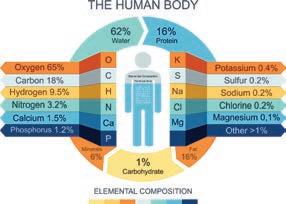
Percentagesofelementsinthe humanbody.
Lessonstarter:Studentranking
FivestudentseachcompletedadifferentMathematicstest.
• Matthewscored 15 outofapossible 20 marks.
• Mengnascored 36 outofapossible 50 marks.
• Mariascored 17 outofapossible 25 marks.
• Marcusscored 7 outofapossible 10 marks.
• Melissascored 128 outofapossible 200 marks.
Changethesetestresultstoequivalentscoresoutof 100,andthereforestatethepercentagetestscorefor eachstudent.Whyarepercentagesusefulinthissituation?
Keyideas
The % symbolmeans percent.ThiscomesfromtheLatin percentum whichmeans ‘outof 100’.
Forexample: 75 percentmeans 75 outof 100.Thatis, 75%= 75 100
Wecanwrite percentages asfractionsbychangingthe % signtoa denominator of 100 (meaningoutof 100)
Forexample: 37%= 37 100
Wecanuse equivalentfractions toconvertfractionstopercentages.
Forexample: 1 4 = 25 100 = 25%
Toconvertanyfractiontoapercentage,multiplyby 100
Forexample: 3 8 × 100 = 3 2 ✁ 8 × ✟✟ 100 25 1 = 75 2 = 37 1 2 Â 3 8 = 37 1 2 % fraction × 100 ÷ 100 percentage
Itisusefultoknowthefollowingcommonpercentagesandtheirequivalentfractions.
1 Changethesetestresultstoequivalentscoresoutof 100,andthereforestatethepercentage.
a 7 outof 10 = outof 100 = %
b 24 outof 50 = outof 100 = %
c 12 outof 20 = outof 100 = %
d 1 outof 5 = outof 100 = %
e 80 outof 200 = outof 100 = %
f 630 outof 1000 = outof 100 = %
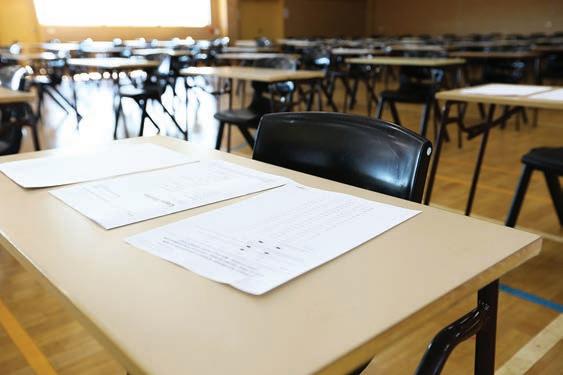
2 Copyandcompletethesepatterns. 1
3a If 14% ofstudentsinYear 7 areabsentduetoillness,what percentageofYear 7 studentsareatschool?
b If 80% oftheGeographyprojecthasbeencompleted,what percentagestillneedstobefinished?

Example21Convertingpercentagestofractions
Expressthesepercentagesasfractionsintheirsimplestform. 17% a 36% b 140% c
Solution
a 17%= 17 100
b 36%= 36 100
= 9 × ✁ 4 25 × ✁ 4 = 9 25
c 140%= 140 100
= 7 × ✚✚ 20 5 × ✚✚ 20 = 7 5 = 1 2 5
Nowyoutry
Explanation
Change % signtoadenominatorof 100
Change % signtoadenominatorof 100
CancelHCF.
Answerisnowinsimplestform.
Change % signtoadenominatorof 100
CancelHCF.
Convertanswertoamixednumeralif required.
Expressthesepercentagesasfractionsintheirsimplestform.
5 Expressthesepercentagesasfractionsintheirsimplestform.
6 Expressthesepercentagesasmixednumbersintheirsimplestform.
Example22Convertingtopercentagesthroughequivalentfractions
Convertthefollowingfractionstopercentages.
× 4 × 4
Denominatorisalready 100,thereforesimply writethenumberasapercentage.
Weneedthedenominatortobe 100 Therefore,multiplynumeratoranddenominator by 4 togetanequivalentfraction.
Nowyoutry
Convertthefollowingfractionstopercentages.
7 Convertthesefractionstopercentages,usingequivalentfractions.

Q7Hint:Firstwritewitha denominatorof 100. p
Example23Convertingtopercentagesbymultiplyingby 100
Convertthefollowingfractionstopercentages.
Nowyoutry
Convertthefollowingfractionstopercentages.
Multiplyby 100 SimplifybycancellingHCF.
Convertmixednumeraltoimproperfraction. Cancelandsimplify.
8 Convertthesefractionstopercentagesbymultiplyingby 100
Problem-solving and reasoning
9 Abottleoflemonadeisonly 25% full.
a Whatfractionofthebottlehasbeenconsumed?
b Whatpercentageofthebottlehasbeenconsumed?
c Whatfractionofthebottleisleft?
d Whatpercentageofthebottleisleft?
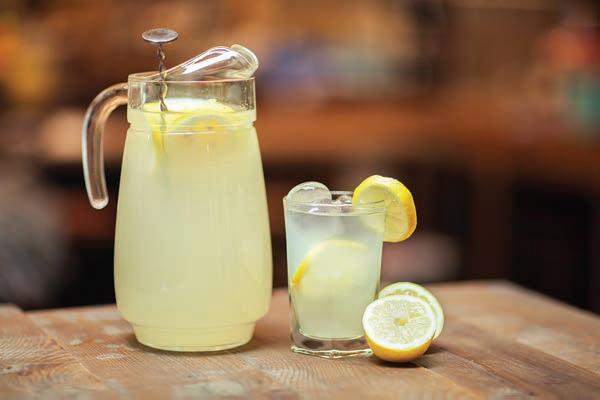
10 Alemontartiscutintoeightequalpieces.Whatpercentageofthetartdoeseachpiecerepresent?
11 Petrinascores 28 outof 40 onherfractionstest.Whatisherpercentagescore?
12 TheHeathmontHornetsbasketballteamhavewon 14 outof 18 games.Theystillhavetwogamesto play.WhatisthesmallestandthelargestpercentageofgamestheHornetscouldwinfortheseason?
More-challengingconversions 13
13a Copyandcomplete:
b Writeeachofthefollowingpercentagesasfractionsusingtheabovetechnique.
3J 3J Findingapercentageofanumber
Learningintentions
• Tounderstandthat ndingpercentagesofanumbergenerallyinvolvesmultiplyingbyafraction.
• Tobeableto ndapercentageofanumber.
• Tobeabletoapplypercentagestowordedproblems.
Keyvocabulary: percentage,‘of’,fraction
Throughoutlifeyouwillcomeacrossmanyexampleswhereyouneedtocalculatepercentagesofaquantity. Examplesincluderetaildiscounts,interestrates,personalimprovementsandsalaryincreases.
Lessonstarter:Percentagesinyourhead
Itisausefulskilltobeabletocalculatepercentagesmentally.Calculating 10% or 1% isoftenagoodstarting point.Youcanthenmultiplyordividethesevaluestoquicklyarriveatotherpercentagevalues.
Withapartner,andusingmentalarithmeticonly,calculate 10% ofeachoftheseamounts.
Howdidyoufind 10% ofanamountmentally?
Keyideas
Tofindthe percentage ofanumber:
1 Expresstherequiredpercentageasa fraction
2 Changethe‘of’toamultiplicationsign.
3 Expressthenumberasafraction.
4 Followtherulesformultiplicationoffractions.
Tomentallyfindapercentageofanumber,findthevalueof 1% or 10% andworkfromthere. Forexample:
Exercise3J
1 Copyandcompletethefollowing.
a Tofind 10% of $20,youcanuse 20 ÷ = 2
b Tofind 25% of $20,youcanuse 20 ÷ 4 =
c Tofind 50% of $20,youcanuse 20 ÷ =
2a If 10% of = 3,find 20% of .
b If 1% of = 7,find 5% of .
c If 50% of • = 8,find 100% of •
3 Usementalstrategiestofind: 10% of $500 a 1% of $900 b 25% of 84 kilograms c 50% of 7 days d 75% of 84 kilograms e 20% of 35 minutes f
4 Whatis 100% of 8 hours?
Example24Findingthepercentageofanumber
Find:
30% of 50 a 15% of 400 b
Solution
a 30% of 50 = 30 2✟✟ 100 × ✚✚ 50 1 1 = 30 2 = 15
Alternatively
10% of 50 = 5
Explanation
Write 30% asafraction. Theword‘of’tellsustomultiply. Cancelandsimplify.
30% of 50 = 15 10% iseasytofindmentally. Multiply 10% by 3 tofind 30%
b 15% of 400 = 15 1✟✟ 100 × ✟✟ 400 4 1 = 15 × 4 1 = 60
Alternatively
10% of 400 = 40, 5% of 400 = 20
15% of 400 = 60
Nowyoutry
Find:
5 Find:
% of 40 e 25% of
6 Find:
7 Matcheachquestionwiththecorrectanswer. Questions Answers a
Write 15% asafraction. ‘Of’means × Cancelandsimplify.
Find 10% mentally.Halvetofind 5%.
Add 10% and 5% tofind 15%

Q5Hint: 50% of140 = 50 100 × 140 1 p

i
8 Find:
30% of $140 a
10% of 240 millimetres b
15% of 60 kilograms c 2% of 4500 tonnes d
20% of 40 minutes e
5% of 30 grams g

80% of 500 centimetres f
25% of 12 hectares h
Q8Hint:Rememberthatthe answersneedtoincludeunits. i
120% of 120 seconds
Problem-solving and reasoning
9 Harryscored 70% onhispercentagestest.Ifthetestisoutof 50 marks,howmanymarks didHarryscore?

10 Inastudentsurvey, 80% ofstudentssaidtheyreceivedtoomuchhomework.If 300 studentswere surveyed,howmanystudentsfelttheygettoomuchhomework?
11 25% ofteenagerssaytheirfavouritefruitiswatermelon.Inasurveyof 48 teenagers,howmanywould writewatermelonastheirfavouritefruit?
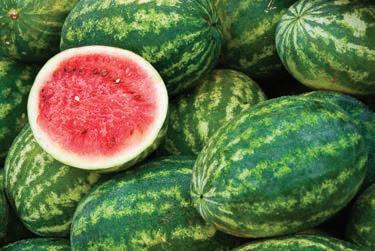
12 AtGladesbrookCollege, 10% ofstudentswalktoschool, 35% ofstudentscatchpublictransportand therestaredriventoschool.Ifthereare 1200 studentsattheschool,findhowmanystudents: walktoschool a catchpublictransport b aredriventoschool c
Percentagechallenge — 13
13a Whichislarger: 60% of 80 or 80% of 60?
b Tomdidthefollowingcalculation: 120 ÷ 4 ÷ 2 × 3.Whatpercentageof 120 didTomfind?
c If 5% ofanamountis $7,whatis 100% oftheamount? i If 25% ofanamountis $3,whatis 12 1 2 % oftheamount?
ii
3K Introductiontoratios
Learningintentions
• Tounderstandthataratiocomparestwoormorerelatedquantitiesinagivenorder
• Tobeabletowritearatiofromadescription
• Tobeabletouseacommonfactortosimplifyaratio
Keyvocabulary: ratio
Ratiosareusedtoshowtherelationshipbetweentwo ormorerelatedquantities.Theycomparequantitiesof thesametypeusingthesameunits.Thenumbersin theratioarethereforewrittenwithoutunits.
Whenreadingorwritingratios,theorderisvery important.Inasport,ateam’swin-lossratioduring theseasoncouldbewrittenas 5 : 2 meaningthata teamhaswon 5 gamesandonlylost 2 games.This isverydifferentfromawin-lossratioof 2 : 5 which wouldmeanthat 2 gameswerewonand 5 games werelost.
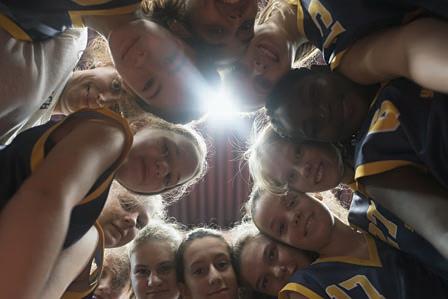
Lessonstarter:Impossiblecupcakes
Liamisbakingcupcakesforagroupoffriendsandplanstomake bananacupcakesandchocolatecupcakesintheratio 2 to 3.This meansthatforevery 2 bananacupcakesthereare 3 chocolate cupcakes.
a HowmanychocolatecupcakeswouldLiammakeifhemakesthe followingnumberofbananacupcakes?
4 i 6 ii 8 iii
b HowmanybananacupcakeswouldLiammakeifhemakesthe followingnumberofchocolatecupcakes?
9 i 15 ii 18 iii
c HowmanycupcakeswillLiammakeintotalifhemakes: i 2 bananacupcakes? ii 6 chocolatecupcakes?
d GivenLiam’scupcakeratio,isitpossiblethathecouldmake 7 cupcakes?Explainwhyorwhynot.
Keyideas
A ratio comparestwoormorerelatedquantities.
• Ratiosareexpressedusingwholenumbersinagivenorder.
• Acolonisusedtoseparatethepartsofaratio.
• Ratiosareexpressedwithoutunits.
Aratiocanbesimplifiedinasimilarwaytoafraction.
• Thefraction 4 6 canbesimplifiedto 2 3 .
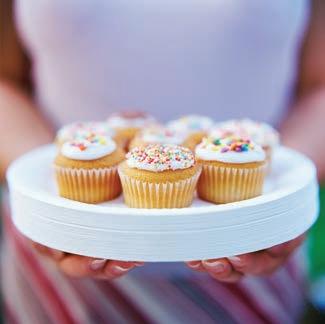
Ratio of dark to white = 2 : 3
Asportingteam’swin-lossperformancecouldbe expressedasaratio.
• Theratio 4 : 6 canbesimplifiedto 2 : 3
• Aratiocanbesimplifiedifthenumbersthatmakeuptheratiohaveacommonfactor.
• Dividingallnumbersinaratiobytheirhighestcommonfactorwillleadtothesimplestform.
Exercise3K
Und er stand ing
1 Ofagroupof 5 counters, 2 ofthemarered and 3 ofthemareblue.
a Whichratiowoulddescribethenumber ofredcounterscomparedtothenumberof bluecounters?
A 2 : 5
B 2 : 3
C 3 : 2
D 3 : 5
E 1 : 2
b Whichratiowoulddescribethenumberofblue counterscomparedtothenumberofred counters?
A 2 : 5
B 2 : 3
C 3 : 2
D 3 : 5
E 1 : 2
c Trueorfalse?Thefractionofredcountersoutofthetotalis 2 3.
d Trueorfalse?Thefractionofbluecountersoutofthetotalis 3
2 Thisrectangleisdividedupinto 12 squares, 4 ofwhichareshaded.
a Howmanysquaresareunshaded?
b Aratiowhichdescribestheratioofshadedtounshaded squarescouldbe:
A 3 : 9
B 4 : 7
C 4 : 8
D 5 : 7
E 4 : 6
c Trueorfalse?Thecorrectratiofrompart b abovecouldalsobewrittenas 8 : 4
d Trueorfalse?Thecorrectratiofrompart b abovecouldalsobewrittenas 1 : 2
e Trueorfalse?Thecorrectratiofrompart b abovecouldalsobewrittenas 2 : 1
Fluency
Example25Expressingasaratio
a Aboxcontains 3 whiteand 4 darkchocolates.Writeeachofthefollowingasaratio.
i theratioofwhitechocolatestodarkchocolates
ii theratioofdarkchocolatestowhitechocolates
b Ashopshelfcontains 2 cakes, 5 slicesand 9 pies.Writeeachofthefollowingasaratio.
i theratioofcakestoslices
ii theratioofcakestoslicestopies
iii theratioofpiestocakes
Solution
ai 3 : 4
ii 4 : 3
bi 2 : 5
ii 2 : 5: 9
iii 9 : 2
Nowyoutry
Explanation
Theorderiswhitetodarkandthereare 3 white and 4 darkchocolates.
Theorderisdarktowhiteandthereare 4 dark and 3 whitechocolates.
Weareonlyconcernedwiththeratioofcakes toslicesandtheorderiscakesthenslices.
Threequantitiescanalsobecomparedusing ratios.Theorderisimportant.
Weareonlyconcernedwithpiesandcakesand theorderispiesthencakes.
a Acontainerhas 2 clearand 5 greymarbles.Writeeachofthefollowingasaratio.
i theratioofclearmarblestogreymarbles
ii theratioofgreymarblestoclearmarbles.
b Acomputershophas 3 laptops, 4 tabletsand 7 phonesonadisplaytable.Writeeachofthe followingasaratio.
i theratiooflaptopstophones
ii theratiooflaptopstotabletstophones
iii theratiooftabletstolaptops.
3a Aboxcontains 5 whiteand 3 darkchocolates.Writeeachofthefollowingasaratio.
i theratioofwhitechocolatestodarkchocolates
ii theratioofdarkchocolatestowhitechocolates
b Atoyshopwindowcontains 3 cars, 7 trucksand 4 motorcycles.Writeeachofthefollowingasa ratio.
i theratioofcarstotrucks
ii theratioofcarstotruckstomotorcycles
iii theratioofmotorcyclestocars
4a Apencilcasehas 8 pencilsand 5 pens.Writeeachof thefollowingasaratio.
i theratioofpencilstopens
ii theratioofpenstopencils
b Acoffeeshopproduces 6 lattes, 7 cappuccinosand 5 flatwhitecoffeesinonehour.Writethefollowingas aratio.
i theratioofcappuccinostoflatwhites
ii theratiooflattestocappuccinostoflatwhites
iii theratioofflatwhitestolattes

5 Eachhour,anewradiostationplanstoplay 3 songsfromthe70s, 4 songsfromthe80s, 7 songsfrom the90sandjustonesongfromthe60s.Writeeachofthefollowingasaratio.
a 80ssongsto70ssongs
b 70ssongsto90ssongs
c 60ssongsto80ssongs
d 70ssongsto60ssongs
e 90ssongsto80ssongsto70ssongs
f 60ssongsto70ssongsto80ssongsto90ssongs
Solution
4 : 10 2 :
3 : 12 : 15
1 : 4 : 5 ÷ 3 ÷ 3
Explanation
Thehighestcommonfactorof 4 and 10 is 2 so dividingbothnumbersby 2 willgivetheratioin simplestform.
Thehighestcommonfactorof 3, 12 and 15 is 3 sodividingallnumbersby 3 willgivetheratioin simplestform.
5 ÷ 5
15 : 10 3 : 2
Nowyoutry
Simplifythefollowingratios.
6 Simplifythefollowingratios. 3 : 6 a 4 : 16 b
Firstusethenumberstowritetheinformation asaratiowithoutunits.Thendivideboth numbersbythehighestcommonfactor 5
7 Simplifythefollowingratios.
8 Simplifythefollowingratios.
6
Problem-solving and reasoning
9 Writearatioofshadedsquarestowhitesquaresinthesediagrams.Simplifyyourratioifpossible.
10 Findthemissingnumber.
11 Ashadeoforangeiscreatedbymixingyellowandredintheratio 2 : 3.
a Explainwhythisisthesameasmixing 4 litresofyellowpaintwith 6 litresofredpaint.
b Decideifthefollowingratiosofyellowpainttoredpaintwillmakethecolourmoreyellowormore redcomparedtothegivenratioabove:
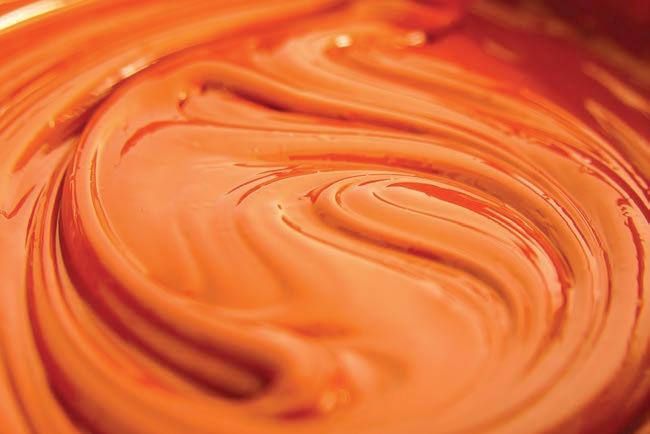
12 Thefollowingcomparequantitieswithdifferentunits.Writethemusingaratioinsimplestformbyfirst writingthemusingthesameunits.
Paintmixing
13 Thethreeprimarycoloursarered,blueandyellow.Mixingthemtogetherindifferentwaysformsa varietyofcolours.Theprimary,secondaryandtertiarycoloursareshowninthischart.
a Thesecondarycoloursareformedbymixingtheprimarycolours.Whatcolourdoyouthinkwillbe formedifthefollowingpairsofprimarycoloursaremixedintotheratio 1 : 1?
i yellowandred
ii yellowandblue
iii redandblue
b Thetertiarycoloursareformedbymixingaprimarycolourandsecondarycolour.Whatcolourdo youthinkwillbeformedifthefollowingpairsofcoloursaremixedintotheratio 1 : 1?
i yellowandorange
ii blueandviolet
iii greenandyellow

3L 3L Solvingproblemswithratios
Learningintentions
• Tounderstandtheconnectionbetweenratios,fractionsandproportions
• Tobeabletosolveproportionproblemsusingratiosandfractions
• Tobeabletodivideagivenquantityinagivenratio
Keyvocabulary: ratio,proportion,fraction
Whenconsideringthemakeupofamateriallike concrete,itisimportanttocorrectlybalancethe proportionsofsand,water,cementandgravel.These ingredientscouldbethoughtofaspartsofthewhole, fractionsofthewholeorasaratio.Youmightsay,for example,thataparticularconcretemixhassand,water, cementandgravelintheratio 3 : 2 : 1 : 4.Thismeansthat outofatotalof 10 parts, 3 ofthemaresand, 2 arewater, 1 iscementand 4 aregravel.Similarly,youcouldsaythat theproportionorfractionofsandinthemixis 3 10 andso ifaloadofconcreteis 40 tonnes,thentheproportionof sandis 3 10 × 40 = 12 tonnes.
Lessonstarter:Makingbread
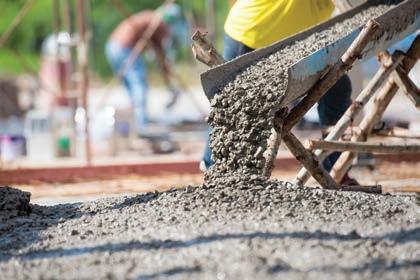
Durableconcreteneedstohavetherightratioof ingredients.
Thetwomainingredientsinbreadareflourandwater.Acommonlyusedratioofflourtowateris 5 : 3
• Howwouldyoudescribetheproportionofflourinabreadmix?
• Howwouldyoudescribethefractionofwaterinabreadmix?
• Iftheratioofflourtowateris 5 : 3,doesthatmeanthatallbreadloavesthataremademusthaveatotal of 8 cupsofingredients?Explain.
• Ifabreadmixconsistedofatotalof 16 cupsofflourandwater,describeamethodforworkingoutthe totalnumberofcupsofflourorwaterrequired.
• Isitpossibletomakealoafofbreadusingatotalof 12 cupsofflourandwater?Describehowyouwould calculatethenumberofcupsofflourorwaterneeded.
Keyideas
Ratioscanbeconsideredasacollectionofparts.
Theratioofvinegartowaterforexamplemightbe 3 : 4,whichmeansthatforevery 3 partsof vinegarthereare 4 partsofwater.
Thetotalnumberofpartscanbecalculatedbyaddingupallthenumbersintheratio.
Thetotalnumberofpartsintheexampleaboveis 3 + 4 = 7
Ratioproblemscanbesolvedbyconsideringtheproportionofonequantitycomparedto thewhole.
Theproportionofvinegaris 3 7 andsoa 210 mLbottlecontains 3 7 × 210 = 90 mLofvinegar.
Todivideaquantityintoagivenratio:
• calculatethetotalnumberofparts(e.g. 3 + 4 = 7)
• calculatetheproportionofthedesiredquantity(e.g. 3 7)
• usefractionstocalculatetheamount(e.g. 3 7 × 210 = 90)
Exercise3L
Und er stand ing 1,2 1,2
1 Acordialmixismadeupof 1 partsyrupto 9 partswater.
a Writethecordialtowatermixasaratio.
b Whatisthetotalnumberofpartsintheratio?
c Whatproportionofthecordialmixissyrup?Writeyouranswerasafraction.
d Whatproportionofthecordialmixiswater?Writeyouranswerasafraction.
e If 400 millilitresofcordialmixismadeup,howmuchofitis: syrup? i water? ii
2 $150 istobedividedintotwopartsusingtheratio 2 : 3 forJacobandSally,inthatorder.
a Whatisthetotalnumberofpartsintheratio?
b WhatfractionofthemoneywouldJacobreceive?
c WhatfractionofthemoneywouldSallyreceive?
d Calculatetheamountofmoneyreceivedby: Jacob i Sally. ii
Fluency
Example27Findingamountsgivenaratio
Drymixcementiscombinedwithwaterinagivenratiotoproduceconcrete.
3,4,6,73,5,8
a Ifthedrymixtowaterratiois 3 : 5,writetheproportionofthefollowingasafraction. drymix i water ii
b If 3 7 oftheconcreteisdrymix,writetheratioofdrymixtowater.
c If 8 litresofdrymixisusedusingadrymixtowaterratioof 2 : 3,whatamountofwateris required?
Solution
ai 3 8
ii 5 8
b 3 7 : 4 7 = 3 : 4
Explanation
Thetotalnumberofpartsis 8 andthenumber ofpartsrelatingtodrymixis 3
Thenumberofpartsrelatingtowateris 5 outof atotalof 8
If 3
7 oftheconcreteisdrymix,then 4 7 iswater.
Multiplybothfractionbythecommon denominatortoproducethesimplifiedratio. Continuedonnextpage
c × 4 × 4 8 : 12 2 : 3 dry mixwater
Â12 litresofwaterrequired.
Nowyoutry
Multiplybothnumbersintheratioby 4 tosee whatamountofwatercorrespondsto 8 litresof drymix.
Juiceconcentrateistobecombinedwithwaterinagivenratiotoproduceadrink.
a Iftheconcentratetowaterratiois 2 : 7,writetheproportionofthefollowingasafraction. concentrate i water ii
b If 1 5 ofthedrinkisconcentrate,writetheratioofconcentratetowater.
c If 100 mLofconcentrateismixedusingaconcentratetowaterratioof 2 : 9,whatamountof waterisrequired?
3 Powderistobecombinedwithwaterinagivenweightratiotoproduceglue.
a Ifthepowdertowaterratiois 2 : 3,writetheproportionofthefollowingasafraction. powder i water ii
b Ifthepowdertowaterratiois 1 : 5,writetheproportionofthefollowingasafraction. powder i water ii
c Ifthepowdertowaterratiois 3 : 4,writetheproportionofthefollowingasafraction. powder i water ii
4 Flouristobecombinedwithwaterintheratio 4 : 3 toproduce damper.
a Writetheproportionofthefollowingasafraction.
flour i water ii
b If 2 3 ofthedamperisflour,writetheratioofflourtowater.
c If 60 gramsofflourismixedusingaflourtowaterratioof 3 : 2,whatamountofwaterisrequired?
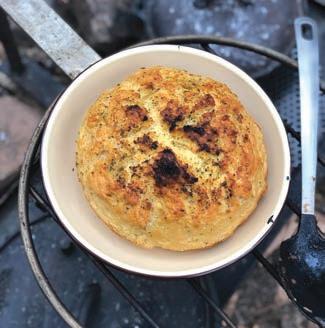
5 Anumberofhockeyteamshavevariouswin-lossratiosforaseason.
a TheCatshaveawin-lossratioof 5 : 3.WhatfractionofthegamesintheseasondidtheCatswin?
b TheJetswon 3 4 oftheirmatches.Writedowntheirwin-lossratio.
c TheEagleslost5oftheirmatcheswithawin-lossratioof 2 : 1.Howmanymatchesdidtheywin?
d TheLionshaveawin-lossratioof 2 : 7.WhatfractionofthegamesintheseasondidtheLionslose?
e TheDozerslost 2 5 oftheirmatches.Writedowntheirwin-lossratio.
f TheSharkswon 6 oftheirmatcheswithawin-lossratioof 3 : 2.Howmanymatchesdidtheylose?
Example28Dividinganamountintoagivenratio
Divide 15 kgintotheratio 2 : 1
Solution
Totalnumberofparts = 2 + 1 = 3
Fractionsare 2 3 and 1 3
Amountsare 2 3 × 15 = 10 and 1 3 × 15 = 5
10 kgand 5 kg
Nowyoutry
Divide 60 secondsintotheratio 3 : 1.
6 Divide 24 kgintotheratio 1 : 3
7 Divide 35 litresintotheratio 3 : 4
8 Dividethefollowingintothegivenratios.
$40 intheratio 2 : 3 a
Explanation
Firstfindthetotalnumberofpartsintheratio. Calculatetheproportionsforeachnumberin theratio.
Multiplyeachfractionbytheamountgiven tofindtheamountscorrespondingtoeach portion.
Answerthequestionwiththeappropriateunits.
intheratio 3 : 7 b 32 kgintheratio 3 : 5 c
Problem-solving and reasoning
9 Mickyismakingupasprayforhisfruitorchardand mixeschemicalwithwaterusingaratioof 2 : 13
a Howmuchchemicalshouldheuseifmakingaspray withthefollowingtotalnumberoflitres?
i 15 litres
ii 45 litres
iii 120 litres
b Ifheuses 20 litresofchemical,howmuchspraywill hemake?
c Ifheuses 39 litresofwater,howmuchchemicaldoes heuse?
9–119,10,12,13

d Ifhemakes 60 litresofspray,howmuchchemicaldidheuse?
10 Mohammadhas $72 todivideamongstthreechildrenintheratio 1 : 2 : 3.
a Howmuchmoneyisgiventothefirstchildlisted?
b Howmuchmoneyisgiventothethirdchildlisted?
11 Theratioofcattletosheeponafarmis 2 : 7.
a Howmanysheeparethereifthereare 50 cattle?
b Howmanycattlearethereifthereare 84 sheep?
c Howmanysheeparethereifthereare 198 cattleandsheepintotal?
d Howmanycattlearethereifthereare 990 cattleandsheepintotal?

12 Maltipsouthiscollectionof 134 onedollarcoinsanddividesthemusingtheratio 2 : 5.WillMalbeable tocompletethedivisionwithoutleavingaremainder?Giveareason.
13 Asportingsquadistobeselectedforatrainingcampwithattacking,midfielderanddefenceplayers intheratio 3 : 5 : 2.Currently,thecoachhasselected 4 attackingplayers, 5 midfieldersand3defence players.Findtheminimumnumberofextraplayersthecoachneedstoselecttohavethecorrectratio.
Slopesasratios
14 Thesteepnessofaslopecanberegardedastheratiooftheverticaldistancecomparedtothehorizontal distance.Soaslopewithratio 1 : 4 wouldmeanforevery 1 metreverticallyyoutravel 4 metres horizontally.
a Describethefollowingslopesasratiosofverticaldistancetohorizontaldistance.
i vertical 20 metresandhorizontal 80 metres
ii vertical 120 metresandhorizontal 40 metres
b Aslopehasaratioof 2 : 9.
i Findthehorizontaldistancetravellediftheverticaldistanceis 12 metres.
ii Findtheverticaldistancetravelledifthehorizontaldistanceis 36 km.

Buildingconstructionapprentice
TheconstructionindustryinAustraliaishuge, andpropertydevelopersemploymany thousandsofworkers.Apprenticesmust completehoursofon-the-jobtrainingaswell asachieveTAFEqualifications.Numberand measurementskillsareveryimportant,as constructionworkersapplytheseskillsin everydayprojects.
Fractionsarestudiedbothatschoolandat TAFE.Measuringandcalculatingwithfractions isavitalskillinthebuildingindustry.Many buildingcomponentsarefromtheUnited States,whichstillusesImperialmeasurements, soinchesandfractionsofaninchoftenfeature intheworkplace.

1 Giventhat 1 inchis 25.4 mm,findthelengthinmillimetresto 1 d.p.forthefollowing.
2 Makeaneat,enlargedcopyofthis 1-inchruleranditsscale.Startbyrulingan 8 cmlineandmark 16 equalspacesonit.Labeltheends 0 and 1 inch,labelthecentre 1
2 inch,thencarefullymarkinallthe otherfractionsofaninchasshownonthisimage.
3 Tapemeasurescanshowunitsinbothinchesandcentimetres.Whatarethefractionalmeasurements ininchesindicatedonthefollowingtapemeasures?
4 TAFEcoursesforconstructionapprenticesincludefractionskills. Writealistininchesforeachofthefollowingsetsofmeasurements:
a Increasinginquartersfrom 10 1 4 inchesto 1 foot.
b Decreasingineighthsfrom 1 footto 11 1 4 inches.
c 3 8 ofaninchlessthaneachof 1 inch, 5 inchesand 1 foot.
d 4 5 16 incheslessthaneachof 1 footand 1 yard.
5 Travis,afirst-yearapprentice,isaskedtocutoffone thirdofa 12-inchpipe.Whatlengthofthepipeinmm isremainingafterhecutsit?
6 Hollyisaskedtocut 8 1 4 inchesfromapipe 41 1 4 inches long.Whatproportionofthepipeiscut(asafraction)?
7 Murrayhaseightlengthsofpipetojointogether.If eachpipeis 4 3 4 incheslong,howmanymmisthefinal lengthofpipe?
Usingtechnology

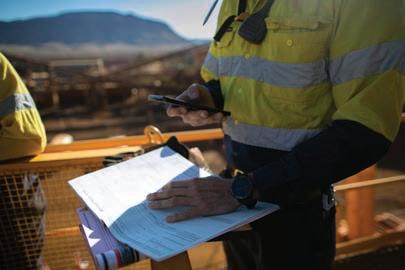
Constructionworkerscalculateandmeasureusing fractions.
8 ManyolderbuildingshavepipesthatwereinstalledbeforeAustraliachangedtothemetricsystem. Thereplacementofoldpipesrequiresexactlythesamelengthofpipemeasuredinmm. Setupthefollowingspreadsheettoaddfractionsandconvert inchestomm.
Selectallthecellsusinginches(columnsA,B,C) andFormat/Fraction/uptotwodigits. Enterformulasintheshadedcells.
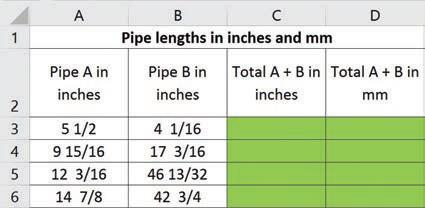

Q8Hint:Totypeafractionintoa spreadsheet,insertaspacebetween thewholenumberandthefraction. e.g. 51/2 means 5 1 2

Pricingplants
Andrewownsanurseryandnormallysellsflowerpotsfor $15 eachandonaveragehesells 100 ofthesepotsperday. Thecosttoproduceeachflowerpotis $5 sotheprofitper potundernormalconditionsis $10 perpot.
Inordertoattractmorecustomerstothenurseryhe considersloweringthepricewithoneofthefollowingdeals.
• Deal 1:Loweringthesellingpriceto $12,wherehe predictshewillsell 1 1 2 timesasmanypotsperday.
• Deal 2:Loweringthesellingpriceto $11,wherehe predictshewillsell 1 4 5 timesasmanypotsperday.

Presentareportforthefollowingtasksandensurethatyoushowclearmathematicalworkingsand explanationswhereappropriate.
1Preliminarytask
1a At $15 each,findhowmuchincome(revenue)wouldAndrewgetifhesold
10 pots i
50 pots ii
100 pots iii
b CalculatetheprofitAndrewwouldmake,undernormalconditions,ifhesells 10 pots i 50 pots ii 100 pots iii
c Evaluate 1 1 2 × 100
d Evaluate 1 4 5 × 100
2a UsingDeal 1,findthefollowing: theprofitmadeoneachpotsold i theexpectednumberofpotstobesold ii theexpectedtotalprofitforAndrew’snurseryforoneday iii
b Comparedtotheprofitmadewhenselling 100 potsundernormalconditions,byhowmuch doesAndrewincreasehisprofitunderDeal 1?
c Usingtheformula percentageprofit = difference original × 100%,calculatetheprofitincrease asapercentageoftheoriginalprofit.
2Modellingtask
Formulate a TheproblemistocreateadealforAndrewthatwillcausetheprofittoincreasebyat least 10%
Writedownalltherelevantinformationthatwillhelpsolvethisproblem.
Solve
Evaluate and verify
b ExamineDeal 2 forthesellingofpotsatAndrew’snursery.Includethefollowinginyour analysis:
i theprofitmadeoneachpotsold
ii theexpectednumberofpotstobesold
iii theexpectedtotalprofitforAndrew’snurseryforoneday
c ComparedtonormalconditionsbyhowmuchdoesAndrew’sprofitincrease,ifheuses Deal 2?Expressyouranswerasapercentageoftheoriginalprofitwithnodeals.
Andrewconsidersathirddealwherethesellingpriceisreducedto $8.Itispredictedthatthis willcausethenumberofpotssoldtotripleto 300
d ComparethisDeal 3 tonormalconditions,consideringthetotalprofitforaday.
e Byconsideringthedealsabove,comparetheprofitsforoneday’stradeforAndrew’snursery. SortthedealsfrommostprofitabletoleastprofitableforAndrew.
Communicate f Summariseyourresultsintothetablebelow.
% increaseinprofitcomparedtonormalconditions
g Usingyourcompletedtable,describeanykeyfindings.
3Extensionquestion
Isitpossibleforfindadealthatexactlyproducesa 20% increaseinprofitforAndrew’snursery?Ifso finditandexplainastowhetherornotitisarealisticdealtooffer.

Addingtoinfinity
(Keytechnology:Spreadsheets)
Itwouldbenaturaltothinkthatatotalsumwouldincrease toinfinityifwecontinuallyaddedonnumberstothetotal, however,thisisnotalwaysthecase.Justlikeinthisimage, wecouldcontinuallyzoominaddingmoreandmore spiralsbutweknowthatthetotalsizeoftheimagenever getslarger.
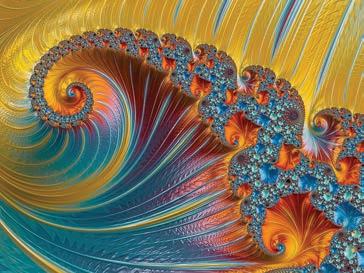
1Gettingstarted
a Considerasequenceofnumberswhereeachnumberisdoublethepreviousnumberinthe sequence.Thenthetotalsumisobtainedbyaddingeachnewnumbertotheprevioustotal.
i Copyandcompletethistableusingtheabovedescription. Sequence 1 2 4 8 16 32
1 3 7
ii Whatdoyounoticeaboutthetotalsum?Isitincreasingmoreorlessrapidlyasmorenumbers arebeingadded?Giveareason.
b Nowconsiderfindingatotalsumfromasequenceofnumberswhereeachnumberisonehalfof thepreviousnumber.
i Copyandcompletethistableusingtheabovedescription.
ii Whatdoyounoticeaboutthetotalsum?Isitincreasingmoreorlessrapidlyasmorenumbers arebeingadded?Giveareason.
iii Whatnumberdoesyoursumappeartobeapproaching?
2Applyinganalgorithm
Hereisanalgorithmwhichfindsatotalsumofasequenceof n numbersstartingat 1.Notethat S standsforthetotalsum, t standsfortheterminthesequenceand i countsthenumber oftermsproduced.
a Copyandcompletethistablefor n = 6,writingdownthevalues for t and S frombeginningtoend.
Technology and computational thinking
b Describethissequenceandsumcomparedtothesequencestudiedinpart 1
c Describethepartsofthealgorithmthatmakethefollowinghappen.
i Eachtermisbeinghalvedeachtime.
ii Thesumisincreasedeachtimebyaddingonthenewterm.
iii Thealgorithmknowswhentoend.
d Writeanalgorithmthataddsupallthenumbersinasequencebutthistime:
• thesequencestartsat 2
• thesumisobtainedbyaddingonethirdofthepreviousnumbereachtime.
3Usingtechnology
Wewilluseaspreadsheettogeneratethesumsstudiedabove.
a Createaspreadsheetasshown.
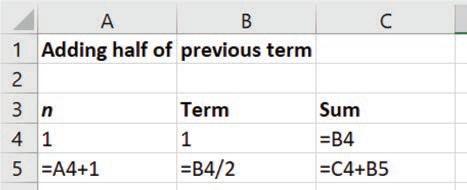
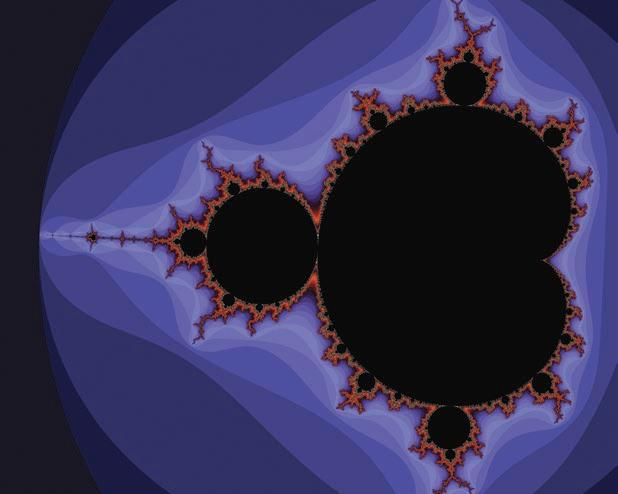
1 ThreecitiesareknownasIndia’sGoldenTriangle.Tofindthenamesofthesecities,completethe puzzle.
Matcheachofthefractionsinthemiddlerowwiththeequivalentfractioninthebottomrow. Placetheletterinthecodebelow.
2 Howmanywordswiththreeormoreletterscanyouandapartnermakefromtheword PERCENTAGES?
Youhave 15 minutestocomeupwithasmanywordsasyoucan. Scoreyourresultsasfollows:
• 1 pointforeverythree-letterword
• 2 pointsforeveryfour-letterword
• 3 pointsforeverywordwithfiveormoreletters
Compareyourlistwiththoseofotherstudentsintheclass.
3 Fractiondicegame
Twodifferent-coloureddicearerequired.Chooseonedieforthenumeratorandonedieforthe denominator.
Forexample: reddieresult bluedieresult = 5 3 or reddieresult bluedieresult = 4 1
Playerstaketurnstothrowbothdiceandrecordtheirfractionresults. Afteranequalnumberofturns,eachplayerthenaddsalltheirresultstogetherandthewinneris theplayerwiththelargestnumber.
4 Inamagicsquare,thesumofthefractionsineachrow,columnanddiagonalisthesame. Findthevalueofeachletterinthesemagicsquares.
proper fraction 3 4
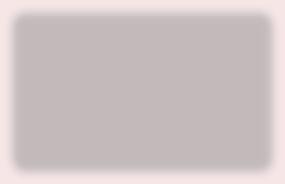




• Same numerator: compare the denominators.
• Same denominator: compare the numerators.
improper fraction 7 5 whole number = 1, = 2 7 7 10 5 mixed number 1 2 5 is less than is greater than

• Different denominators: change to LCD Lowest Common Denominator). Comparing

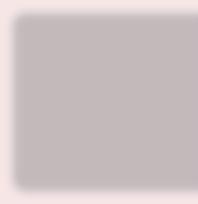
Adding or subtracting fractions
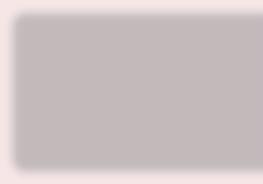
Number of shaded parts (numerator)
Number of equal parts (denominator)



Fractions


Multiplying fractions
Multiply across the top. Multiply across the bottom. Cancel when you can.

Need a common denominator. A fraction is part of a whole.

Dividing by a fraction
Multiply by its reciprocal.



Reciprocal means to swap the numerator and denominator.
Per cent means 'out of 100'




Percentages

Finding a percentage of a quantity
8% of $70 × = 8 100 $70 = $5.60

Ratios
Simplest ratios use the smallest whole numbers 10 : 4 = 5 : 2. Units must be the same.
$5.20 : 160 cents
520 : 160 13 : 4


Applying ratios
To divide into a given ratio, find the
total number of parts.
For example, $60 into the ratio 2 : 1
Total parts is 2 + 1 = 3 so of $60 = $40 and 2 3 of $60 = $20. 1 3

Comparing quantities
Units must be the same.
50 cents out of $2 × 100%
= 50 cents out of 200 cents = 50 200 = 25%

Mental calculations
10% of 300 kg = 30 kg
So 20% of 300 kg = 60 kg
75% of $80 = of $80 3 4 = $60
Chapter checklist
Chapterchecklist
AversionofthischecklistthatyoucanprintoutandcompletecanbedownloadedfromyourInteractiveTextbook.
3A 1
3A 2
Icanidentifythenumeratoranddenominatorofafractiondescribedinwords. e.g.Apizzahasbeencutintoeightpieces,withthreeofthemselected.Writetheselectionasafraction andstatethenumeratoranddenominator.
Icanrepresentfractionsonanumberline. e.g.Representthefractions 3 5 and 9 5 onanumberline.
3B 3 Icanlistfractionsthatareequivalenttoagivenfraction. e.g.Writefourfractionsthatareequivalentto 2 3
3B 4 Icanwritefractionsinsimplestform. e.g.Writethefraction 12 20 insimplestform.
3C 5 Icanconvertmixednumeralstoimproperfractions. e.g.Convert 3 1 5 toanimproperfraction.
3C 6 Icanconvertfromanimproperfractiontoamixednumeral. e.g.Convert 11 4 toamixednumerals.
3D 7 Icancomparetwofractionstodecidewhichisbigger. e.g.Decidewhichof 2 3 and 3 5 isbigger,andwriteastatementinvolving > or < tosummariseyouranswer.
3D 8 Icanorderfractionsinascendingordescendingorder.
e.g.Placethefollowingfractionsinascendingorder: 3 4, 4 5, 2 3
3E 9 Icanaddtwofractionsbyconvertingtoacommondenominatorifrequired.
e.g.Findthevalueof 3 4 + 5 6
3E 10 Icanaddtwomixednumerals.
e.g.Findthesumof 2 5 6 and 3 3 4.
3F 11 Icansubtracttwofractionsbyconvertingtoacommondenominatorif required.
e.g.Findthevalueof 5 6 1 4
3F 12 Icansubtracttwomixednumerals.
e.g.Findthevalueof 5 2 3 −3 1
3G 13 Icanfindasimplefractionofaquantity.
e.g.Find 2 3 of 15 bananas.
3G 14 Icanexpressawholenumberasafraction.
e.g.Write 21 asafraction.
3G 15 Icanmultiplyproperfractions.
e.g.Find 3 4 × 8 9.
3G 16 Icanmultiplymixednumbers.
e.g.Find 6 1 4 × 2 2 5
3H 17 Icanfindthereciprocalofafraction,wholenumberormixednumber.
e.g.Findthereciprocalof(a) 2 3,(b) 5,and(c) 1 3 7
3H 18 IcandivideafractionbyawholenumberandIcandivideawholenumberbya fraction.
e.g.Find 5 8 ÷ 3 and 24 ÷ 3 4
3H 19 Icandividefractions(properand/orimproperfractions).
e.g.Find 3 5 ÷ 3 8
3H 20 Icandividemixednumbers.
e.g.Find 2 2 5 ÷ 1 3 5
3I 21 Icanconvertapercentagetoafractionormixednumber. e.g.Express 36% asafractioninsimplestform.
3I 22 Icanconvertafractiontoapercentage.
e.g.Convert 11 25 and 3 8 topercentages.
3J 23 Icanfindthepercentageofanumber. e.g.Find 15% of 400
3K 24 Icanexpressrelatedquantitiesasaratio. e.g.Aboxcontains 3 whitechocolatesand 4 darkchocolates.Writetheratioofdarkchocolatestowhite chocolates.
3L 25 Icansimplifyaratio. e.g.Write 60 : 24 insimplestform.
3L 26 Icanfindanamountgivenaratio. e.g.Iftheratioofdrymixcementtowateris 2 : 3,whatamountofwaterismixedwith 8 litresofdrymix cement?
3L 27 Icandivideanamountintoagivenratio. e.g.Divide 15 kgintotheratio 2 : 1
Short-answerquestions
1 3A Writethefractionofeachcirclethatisshaded.
2 3B Giventhat 24 = 12 × 2 and 36 = 12 × 3,simplifythefraction 24 36
3 3B Writethefollowingfractionsinsimplestform.
4 3C Converteachofthefollowingtoamixednumeralinsimplestform.
5 3D Placethecorrectsymbol(<, = or >) inbetweenthefollowingpairsoffractionstomake truemathematicalstatements.
6 3D Statethelargestfractionineachlist. 3
7 3D Statethelowestcommonmultipleforeachpairofnumbers.
8 3E/F Statethelowestcommondenominatorforeachsetoffractions.
9 3D Rearrangeeachsetoffractionsindescendingorder.
10 3E/F Determinethesimplestanswerforeachofthefollowing.
11 3G Find:
12 3H Determinethereciprocalofeachofthefollowing.
13 3H Performthesedivisions.
14 3I Findthemissingpercentagesandfractions.
15 3J Find 10% of $200. a Find 25% of $840. b
Find 50% of 96 grams. c Find 20% of $150 d
Find 150% of $6 e
16 3K Ashopshelfdisplays 3 cakes, 5 slicesand 4 pies.Writethefollowingasratios. cakestoslices a slicestopies b piestocakes c slicestopiestocakes d
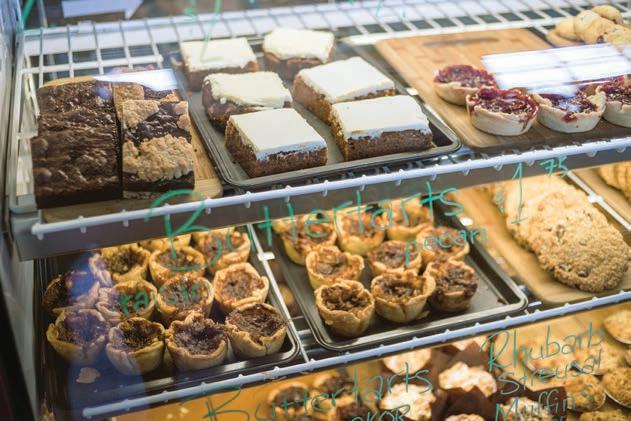
17 3K Expresstheseratiosinsimplestform.
21 : 7 a
3.2 : 0.6 b
$2.30 : 50 cents c
18 3L Divide $80 intothefollowingratios.
7 : 1 a
2 : 3 b
Multiple-choicequestions
1 3A Whichfractionisshownonthenumberline? 2 1
2 3B 3 4 isthesameas:
3 3B 4 5 issmallerthan:
4 3D Whichisthelowestcommondenominatorforthissetoffractions?
5 3A Mariahas 15 redapplesand 5 greenapples.Whatfractionoftheapplesaregreen?
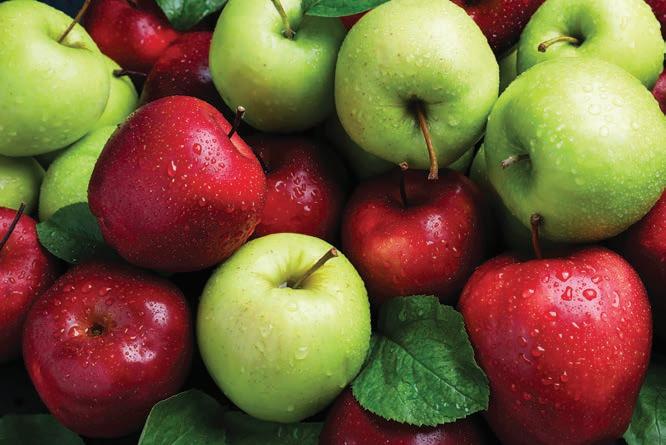
6 3D Whichofthefollowingistrue?
7 3D Whichsetoffractionsisorderedfromsmallesttolargest(ascendingorder)?
8 3E/F/G Whichproblemhasanincorrectanswer?
Whichfractionisgreaterthan 75%?
10 3K $28 to $63 expressedasaratioinsimplestformis: 9 : 4 A
11 3C 60 14 canbewrittenas:
12 3G 17 25 ofametreofmaterialisneededforaschoolproject.Howmanycentimetresisthis?
Extended-responsequestions
1 Aprinterproduces 1200 leaflets.One-quarteroftheleafletsareongreenpaper.Halfthe remainingleafletsareonwhitepaper.Therearesmudgeson 10% oftheleafletsforeachcolour ofpaper.
a Howmanyleafletswereongreenpaper?
b Whatpercentageoftheleafletswere not ongreenpaper?
c Howmanywhiteleafletswereprinted?
d Ofthewhiteleaflets,howmanyhadsmudges?
e Howmanyleafletsdidnothaveanysmudges?
